

















































is leading the way









Tricia Keith, president and CEO of Blue Cross Blue Shield of Michigan, is leading the way in lowering health care costs, boosting quality, and seeking pharmaceutical reform legislation.





























No matter what your industry, from healthcare to oil and gas, public sector and expertise to ensure their success.
We offer commercial payments and investment banking as well as employer from our industry experts. For business executives and owners, we are truly your full-service bank













ARUNA ANAND, Continental
KATIE BIGELOW, Mettle Ops
STACEY COOPES, Unite Digital
LIZ DOOR, Ford Motor Co.
LUANNE THOMAS EWALD, U-M Health
AC ROCHE, Cranbrook
TANYA SKILTON, General Motors Co.
E’LOIS THOMAS, SEEL

Fueling Michigan today and tomorrow. Every day, Michiganders depend on secure, reliable energy to heat their homes, fuel businesses, and power industries. Enbridge proudly delivers 55% of the propane used in Michigan.
We continue to modernize our energy infrastructure and further protect the Straits of Mackinac crossing by investing in the Great Lakes Tunnel.
As a North American integrated energy company, we’ve been delivering the energy the state needs for decades and we’re investing in Michigan communities and infrastructure. It’s how we’re building toward a better tomorrow.
Discover more at enbridge.com/Michigan.
16 WINGS OF OPPORTUNITY
Bidding to stay ahead and exceed in aerospace technologies, Detroit and Michigan are advancing the commercial use of drones for supporting first responders, point-to-point and shore-to-ship package deliveries, and inspection services in agriculture and energy infrastructure.
16 HIGH AND LOWS
Look for further consolidation in the Michigan cannabis market as the result of a healthy supply market — the average price for an ounce of marijuana was $82.50 last year, a sharp drop from $419 per ounce in 2020.
16 TARIFFS AND SUSTAINABILITY
As a result of Gov. Gretchen Whitmer’s policies, the state’s economy isn’t prepared to handle new tariffs on auto, chemical, manufacturing, and other industry sectors.
18 COMPENDIUM
How outsiders view Detroit.
22 BENNY AND THE SPECS
What started out as a passion project became one of the first businesses dedicated to selling designer reading glasses. By R.J. King
23 BRAND-BUILDER
Jacqueline Thompson established Superconnectors to help brands stand out among consumers. By R.J. King
23 PITCH PERFECT
Detroit City FC has unveiled draft plans for its new 15,000-seat stadium at Michigan Avenue and 20th Street in the city’s Corktown neighborhood. The stadium is scheduled to open as soon as spring 2027. By Tim Keenan
24 POWERED BY YOUTH
Catholic Central High School rising senior Dominic Recchione is focusing on a career in video production. By Tim Keenan
24 PDA Q&A
Paul Mersino, president and CEO, Butzel, Detroit. By R.J. King
26 MERCURY MARINER
Bob Shapton rides the wave of repairing antique and classic boat engines in Grand Rapids. By Seth Schwartz

70 LIV AND LET LIV
The Cardinal at Saint John’s Resort in Plymouth Township takes center stage for the LIV Golf Michigan Team Championship in August. By Tim Keenan
75 RETURN ON INVESTMENT
Elevator Pitch: Tess Mateo, who grew up in Troy, helped plan a major fundraiser in New York City with recording artists like Dionne Warwick before enjoying a long career in consulting that led to advancing global sustainability via Vision 2050. By Tom Murray
78 PRODUCTION RUN
Pizza Pizzazz: In the six years it’s been open, Mootz Pizzeria + Bar has grown to become one of downtown Detroit’s most popular dining destinations. By Tim Keenan
82 PATENTS AND INVENTIONS
Star Engineer: A former faculty member at the University of Michigan, Lynn Conway, invented a technique for using algorithms to arrange millions of transistors on miniaturized computer chips. By Norm Sinclair
85 OPINION
Communication Breakdown: Left unaddressed, negativity and conflict can harm workplace culture and potentially grow into larger organizational issues. By Vanessa Denha Garmo
86 THE CIRCUIT
92 FROM THE TOP
Largest Accounting Firms in Metro Detroit, Largest Banks and Thrifts in Metro Detroit, Largest Credit Unions in Metro Detroit, Corporate Aviation: Top Regional Airports 2025.
98 CLOSING BELL
Golden Girl: Michigan’s first female attorney, Elizabeth Eaglesfield, was an activist and entrepreneur with a penchant for conflict. By Ronald Ahrens
Our party pics from exclusive events. ON THE COVER Photo by Nic Antaya









































When Little Caesars Arena



Little Caesars Arena, as many performers choose to land their private jets at Detroit City Airport rather than other local airports because of its location just 6 miles from the central business district.




opened in 2017, it became home to the Detroit Red Wings, Detroit Pistons, and multiple concerts and events.







What’s more, during major events like the Detroit Grand Prix, the NFL Draft, and playo games, private jets are parked wingtip-to-wingtip at Detroit City Airport (as many as 100 aircraft at a time). e facility hasn’t seen that type of tra c since it rst opened in 1927.

Over the past eight years, it has been among the top three sports and entertainment venues in the country, consistently drawing the world’s most popular recording artists.



While critics highlight public investment in such projects could be better spent on trade schools, housing developments, or community assets, in the case of Little Caesars Arena, the venue has all but saved Coleman A. Young International Airport, more commonly known as Detroit City Airport.


With new revenue coming from landing fees and other services, in recent months the FAA approved a 20-year airport development and strategy design plan. e move not only opens federal funding to help subsidize infrastructure improvements at the airport, but it also helped spark a wave of new development.



Following the city’s 2014 bankruptcy, Mayor Mike Duggan talked openly of replacing the 344-acre airport with an industrial park. e airport had lost money for years, especially after regularly scheduled passenger airline service ceased in 2000.
With the city running out of industrial land — a surge in demand for production facilities, warehouses, and distribution centers since 2016 greatly contributed to the replacement of abandoned factories — Duggan believed new tax revenue from an industrial park was a better prospect than an airport.
But what the mayor didn’t foresee was the FAA’s requirements for closing an air eld operation. Before the facility could be shuttered, the investments the FAA had made to the airport in recent years — amounting to $25 million or so — would need to be paid back.
As the mayor pondered his next move, the FAA saw the future potential of the airport as takeo and landing tra c soared. Driving the growth was
Today, the airport is undergoing a building boom with multiple projects either approved or under construction, including new hangars and aeronautical facilities, a new airport tower, and the return of the Davis Aerospace Technical High School and the Detroit Fire Department’s Engine Company 20. at’s the most development Detroit City Airport has seen since a new terminal was added along Conner Avenue in the 1960s.
Already, new hangars are being built by Av ight, the airport’s longtime FBO, along with MyFlight Tours, a helicopter tour company. More hangars will be added near Conner and eventually west of the main runway, which has recently been upgraded. e facilities on the west side will be joined by the new airport control tower.
As for Duggan’s plan to build an industrial park on the site, the FAA and the city recently agreed to close the airport’s shorter runway. e city intends to use that land to attract a package distribution facility.
With the airport now an economic generator, it’s driving new revenue for the city. It also provides more local students with the certification classes needed to land high-paying jobs in the aviation sector.
R.J. King rjking@dbusiness.com
I want to extend a sincere thank you for allowing us to participate in the DBusiness Breakfast Series discussion about AI and its applications in business and career development. It was both enlightening and inspiring. The information and insights shared will undoubtedly help shape our approach to integrating AI into our own processes. It was a valuable opportunity to connect with industry experts and peers. Thank you once again for hosting such a great event.
Joe Turner Troy
NATIONAL ACADEMY OF INVENTORS
Kudos on your article about Ken Cook and Lawrence Technological University’s formation of a campus chapter of the National Academy of Inventors. You clearly did a huge amount of research for the article and you certainly captured the essence of Ken, both as a man and an inspiration. He is greatly missed.
Bruce J. Annett Jr. Southfield

Business leaders say they trust the attorneys of Plunkett Cooney to anticipate legal pitfalls, to resolve high-stakes litigation and to craft contracts they can sign... with confidence. See your business differently. Get the Plunkett Cooney perspective. n Appellate Law n Banking, Bankruptcy & Creditors’ Rights n Business Transactions n Cannabis Law n Commercial Litigation n

























John Sitkiewicz has been a contributing writer at DBusiness for more than a decade, during which time he’s produced a series of investigative features on topics ranging from terrorism to narcotics tra cking in the city of Detroit to the Benton Harbor water crisis. His work also has appeared in The Detroit News, Michigan Capitol Confidential, and Xology magazine. He’s a graduate of Oakland University and earned an MBA from Lawrence Technological University in Southfield. In this issue, he looks at what’s driving the rash of burglaries of wealthy homes in metro Detroit.
Josh Scott is a self-taught, Detroit-based photographer who specializes in editorial, portraiture, automotive, and product photography. His passion is “creating beautiful and thought-provoking work.” His work has been seen in Hour Detroit, DBusiness, Metro Detroit Weddings, Road & Track, and AutoWeek magazines, as well as the University of Michigan’s LSA Magazine for alumni. He has owned his own photography business since 2012, and his non-editorial clients include Ford Motor Co. and Hagerty. In this issue he photographed Mootz Pizzeria + Bar Co-owner Lisa Walters and Executive Chef Angela Georgas.


Seth Schwartz is in his second year as a DBusiness contributor. He covered high school sports for the Chicago Sun-Times, and contributes to The Wall Street Journal real estate section. Schwartz also writes for The Local Palate, Block Club Chicago, and Sailing Anarchy. He covers food, spirits, small businesses, and real estate. He also was the executive producer for documentaries on former Jackson State quarterback Roy Curry, former Cleveland Browns and Dallas Cowboy scout John Wooten, and Tampa’s Oliva cigar family. In this issue, Schwartz explores Michigan Boat and Engine in Grand Rapids.
ACCOUNT MANAGER Elizabeth Kowalik
SPECIAL PROJECTS EDITORS Emily Doran, Olivia Sedlacek DIGITAL
DIRECTOR OF DIGITAL STRATEGY Travis Fletcher
DIGITAL DEVELOPMENT MANAGER Matt Cappo
SR. DIGITAL DEVELOPMENT SPECIALIST Luanne Lim
DIGITAL DEVELOPMENT SPECIALIST Izak Geisler
DIGITAL STRATEGY INTERNS Connor Cooper, Keerthana Reddy, Jacalyn Wyka IT IT DIRECTOR Jeremy Leland
CIRCULATION
CIRCULATION MANAGER Riley Meyers
CIRCULATION COORDINATORS David Benvenuto, Cathy Krajenke, Rachel Moulden, Michele Wold
MARKETING AND EVENTS
MARKETING AND EVENTS MANAGER Regan Wright
MARKETING AND EVENTS COORDINATORS Lindsay Sheridan, Maya Stephenson
MARKETING AND EVENTS ADMINISTRATIVE ASSISTANT Isabella Amadori
WEDDINGS ACCOUNT MANAGER Karen Wilkie
MARKETING AND EVENTS INTERNS Samantha Kosonog, Talia Rubin, Megan Splan, Isabella Tersigni
MARKETING RESEARCH
MARKETING RESEARCH DIRECTOR Sofia Shevin
MARKETING RESEARCH COORDINATORS Kristin Bestrom, Alyssa Fueri
MARKETING RESEARCH SALES COORDINATOR Alex Thompson
MARKETING RESEARCH SALES ASSISTANT Theresa Lowery
GRAPHIC DESIGNER Kendra Okamoto
MARKETING RESEARCH INTERNS Elma Mehmedovic, Anya Samsonov, Gwen Zych
BUSINESS
CEO Stefan Wanczyk
PRESIDENT John Balardo
DIRECTOR OF BUSINESS OPERATIONS Kathie Gorecki
MEDIA ASSOCIATE Kayla Yucha
SENIOR ACCOUNTING ASSOCIATE Andrew Kotzian
ACCOUNTING ASSOCIATES Jenna Glod, Austin Schmelzle
DISTRIBUTION Target Distribution, Troy

july 10 | Shakespeare on the Rocks: The Tempest
A live evening performance on the Back Lawn by Shakespeare in Detroit
july 13 | Summer Beer and Wine Soiree on the Bay
Sip, stroll, and savor lakeside views, historic charm, and curated beverage samplings
july through august | summerfest movies & concerts
Enjoy free movies and live concerts on the Back Lawn, six dates July through August


scan the qr code to check out the full schedule of summer fun at the war memorial



Jessica Dadas-Schulze is the Michigan managing partner at DUGGAN BERTSCH, PLLC, in the Trust & Estate Planning Group and works closely with the Corporate and Health Care teams to serve clients. With over 18 years of experience, Jessica focuses on tax and private wealth planning, asset protection, business exit planning, philanthropy, transitional planning, and federal and state tax and compliance audits.
Jessica’s practice serves businesses and business owners, executives, real estate developers and investors, health care providers, companies in the financial industry and in the government contracting industry, and tax-exempt organizations. Recognized for her extensive background in advising on and negotiating complex estate planning matters, Jessica specializes in probate court matters, including guardianships, conservatorships, probate, and
litigation, as well as federal interpleader life insurance beneficiary disputes throughout the country.
Certified in government contracting, Jessica also specializes in federal procurement and government set-asides, complex entity certifications, proposals, bid protests, contract administration, estimating, and compliance. In the past five years, Jessica has directly managed bid proposals resulting in over $88 million in new federal and Michigan contract awards for her clients.
A former recipient of DBusiness magazine’s Top Corporate Counsel designation from 2022 to 2024, Jessica is a dedicated attorney, mother of two wonderful boys, mentor, and thriving breast cancer survivor. Let Jessica and her team at DUGGAN BERTSCH know how they can assist you and your legal needs. Give them a call today at 248-206-8636.
Jessica Dadas-Schulze, J.D. Partner
DUGGAN BERTSCH, PLLC
41000 Woodward Ave.
Suite 350 East
Bloomfield Hills, MI 48304
248-206-8636
jdschulze@dugganbertsch.com
DUGGANBERTSCH. com

“WHEN EVERYTHING SEEMS TO BE GOING AGAINST YOU, REMEMBER THAT THE AIRPLANE TAKES OFF AGAINST THE WIND, NOT WITH IT.”
— HENRY FORD
BILLION
AVIATION
Bidding to stay ahead and exceed in aerospace technologies, Detroit and Michigan are advancing the commercial use of drones for supporting first responders, point-to-point and shore-to-ship package deliveries, and inspection services in agriculture and energy infrastructure.
The goal is to set standards, expand services, and grab a larger piece of the global drone sector that’s projected to be a nearly $58-billion marketplace by 2030, according to Drone Industry Insights, a German-based consulting group. The company reported global drone flights jumped 25 percent last year to 19.5 million, from 15.5 million the prior year.
Overall, Michigan and Detroit, working with industry partners, have been testing drones and establishing safe flight paths as unmanned aerial vehicles start to become essential tools in industries like construction, agriculture, energy, and transportation.
As it turns out, most people are making money operating drones rather than building them, according to Drone Industry Insights. The commercial services segment is by far the largest within the drone industry, as people use small aircraft for everything from wedding photography to making advanced maps. There’s also been an increase in the military’s use of small, portable drones.
“Drones as a service” is a broad, widely encompassing segment that’s expected to reach $29.4 billion this year. Behind that is the drone hardware industry. In 2025, drone hardware will be worth $6.7 billion — it’s the fastest-growing industry segment, and is being fueled by recent innovations in BVLOS (Beyond Visual Line of Sight) technology. It also has to do with growing trends like the proliferation of automated drone docking stations.
MICHIGAN’S RED-HOT CANNABIS MARKET IS beginning to mature as adult-use sales reached a record of nearly $3.3 billion last year, up 9.9 percent from $2.9 billion in 2023, according to the Michigan Cannabis Regulatory Agency. That comes on the heels of 46-percent growth in 2023, and a 55-percent jump in sales in 2022.
Look for further consolidation in the Michigan cannabis market as the result of a healthy supply market — the average price for an ounce of marijuana was $82.50 last year, a sharp drop from $419 per ounce in 2020. Since adult-use sales were launched in December 2019, multiple local and national growers have sprouted up statewide.
Moving forward, in a bid to maintain or grow profit margins, more cannabis companies will merge or be acquired, new high-quality and niche products will be introduced, and added cannabis consumption lounges will pop up around the state to limit a recent spate of layoffs and the number of national companies pulling out of the local marketplace.
To address oversupply issues, Michigan regulators are looking at limiting or pausing the number of new grow licenses that are issued. While the state has one of the nation’s largest cannabis markets, potential policy adjustments could make it even better by equalizing prices relative to supply and demand.
BILLION
Recently, the Michigan Department of Transportation, Michigan Central, and Airspace Link in Detroit launched the Advanced Aerial Innovation Region (AAIR). It’s billed as “a first-of-its-kind urban aerial innovation testbed designed to accelerate the development and deployment of commercial drone technologies.”
Spanning a 3-mile radius surrounding Michigan Central, the AAIR group is working to provide a controlled drone environment featuring “shared-use systems, infrastructure, and technologies” that include an operations center, a beyond-visual-line-of-sight system, an FAA preflight check system, and a launchpad and scaled launch facility.
In turn, Skyports Drone Services in London recently conducted a series of proof-of-concept ship-to-shore beyond-visual-line-of-sight drone flights and deliveries from the coastal village of DeTour in Michigan’s Upper Peninsula. From May 7-27, Skyports completed trial flights ferrying cargo to Interlake Steamship vessels.
Conducted in partnership with MDOT, the Michigan Office of Future Mobility and Electrification, and Newlab, the trial was designed to validate the benefits of using drones to supplement regular ship deliveries from supply boats — demonstrating the speed, safety, improved sustainability, and cost benefits of maritime drone deliveries. Light cargo such as oil samples, potable water samples, flat and small mail, and linens/laundry were delivered during the trial. The pilot program seeks to validate drone technology, generate insights to help inform the regulatory requirements and policy frameworks, and lay the groundwork for the widespread adoption of dronebased logistics in Michigan.
POLICIES PUT IN PLACE under Gov. Gretchen Whitmer have given more economic and political power to labor unions, with the loss of Right to Work and the addition of sometimesstifling regulations on businesses. As a result, the state’s economy isn’t prepared to handle new tariffs on auto, chemical, manufacturing, and other industry sectors.
According to a recent forecast by the University of Michigan, some 13,000 potential jobs in the state will be lost in the coming years due to the 25-percent tariffs recently put in place on everything from steel to aluminum, parts, and components. The new levies also are expected to lead to supplier consolidation, fewer jobs, delays in new investments and industry planning, and higher prices for consumers.
Rather than support free market principles, Michigan’s economy has been so lackluster over the last six years Whitmer has been in office, the state has resorted to offering millions of dollars in record outlays to lure manufacturers. The pay-to-attract model of luring private investment is unsustainable.
Based on a recent outlook from the Research Seminar in Quantitative Economics, Michigan saw 80,000 new jobs created in 2023, followed by 38,000 jobs last year. Job growth is expected to be even lower this year and next, reaching as low as 18,500 jobs. For a governor who touts a “Make it in Michigan” strategy, her policies actually serve to stifle growth and inhibit innovation.

AUTOMATION, AMID MANUFACTURING UNCERTAINTY, HITS THE ACCELERATOR FORBES
MAY 13, 2025
BY BILL KOENIG
Automation — robots, sensors, simulation software among other things — is speeding up even while manufacturing faces uncertainty.
The Automate Show in Detroit in May demonstrated various types of automation. The annual event alternates between Detroit and Chicago.
Manufacturing faces worker shortages. As a result, companies are looking for automation to take up that slack as well as improve efficiency.
Manufacturers, including automakers, are looking for more and faster.
“We’re trying to find flexible solutions,” Paul Stephens, global strategy manager for Ford Motor Co., said at a Tuesday panel discussion at the show. The days “of four-, five-, six-year automation projects is over,” he added.
“I see us in an acceleration period right now,” Mike Cicco, president and CEO of robot maker FANUC America, said at the same panel. “The speed to deploy has changed. … Once we have delivered it, it has to be installed very quickly.”
Over the past two
decades, factory automation has expanded to include 3D printing; collaborative robots, which can be deployed near human workers; (and) so-called digital twins, which help manufacturers simulate how machinery will be deployed. Simulation software in general has helped automation companies hit the ground running.
“We’re able to do the work before we get there,” FANUC’s Cicco said. With the case of robots, their makers can “pre-teach” the robots before they get to the factory floor, he said. ...
BLOOMBERG MAY 3, 2025
BY MARK BYRNES
When General Motors Co. announced last April that it would be vacating the Renaissance Center, concern over the fate of downtown Detroit’s most recognizable structure turned into speculation that the distinctive skyscraper complex would be demolished. Once unthinkable, plans to take down two of its five office towers, and then some, are proceeding.
Developer Bedrock Detroit, in a partnership with GM, has tasked Gensler and James Corner Field Associates with reimagining the nearly
real estate development at the time and a bold statement about Detroit.
With the region rapidly segregating and the city losing population a few years after one of America’s most destructive riots, the timing was critical. Portman’s sleek towers and signature atrium proclaimed — at least to those with a chamber of commerce worldview — that Detroit was poised for rebirth. …
half-century-old mega-complex. Their $1.6 billion concept involves significantly reducing its 5.5-million-square-footage by demolishing two of its original five towers as well as an early 2000s podium addition while creating new public outdoor spaces that connect to the Detroit River. No question, the aging Renaissance Center complex needs a drastic overhaul to return as a destination, not just a landmark. But the proposal for partial demolition comes as a shock to some Detroiters who long ago learned to love the behemoth known to locals as RenCen. A group of preservationists, city boosters, and elected leaders has stepped forward to intervene, objecting to both the removal of architecturally significant features as well as the public financing required for the job.
(The) Renaissance Center is like nothing else on Detroit’s skyline. It was designed by John Portman, an Atlanta architect known for gargantuan hotel projects with soaring atriums, typically located in struggling downtowns. The first phase was completed in 1977, comprising four 39-story office towers surrounding a cylindrical 73-story hotel, each one enveloped in dark glass. The $337 million ($1.8 billion in 2025) construction project was the world’s largest privately invested
Giant sequoias are typically found in California’s Sierra Nevada mountain range, where they reach heights of up to 300 feet.
Now, however, with help from conservationists, the world’s largest trees are spreading to new places. In Detroit, arborists are planting dozens of giant sequoia saplings in a blighted area in hopes of creating an urban forest that will clean the air, provide shade and, overall, improve residents’ quality of life.
The trees are being planted in Detroit’s Poletown East neighborhood through a partnership between two nonprofits, Arboretum Detroit and Archangel Ancient Tree Archive.
The effort started in 2020 and 2021, with the planting of 20 giant sequoia trees on private property and vacant lots owned by Arboretum Detroit. It continued late last month, as volunteers convened on Earth Day to plant roughly 100 additional saplings.
“There’s not another urban area I know of that has the kind of potential that we do to reforest,” said Andrew “Birch” Kemp, co-director and board president of Arboretum Detroit, to the Associated Press’ Corey Williams. “We could all live in shady, fresh air beauty. It’s like no reason we can’t be the greenest city in the world.”
The Earth Day saplings are roughly a foot tall. But, if all goes as planned, they’ll rocket to roughly 15 feet tall — and counting — over the next decade. The trees can grow up to 2 feet each year.
The saplings are all clones of two well-known trees in

California. One is the Amos Alonzo Stagg tree, which measures 243 feet tall. Nicknamed “Stagg” for short, the tree is the fifth-largest in the world. The other, known as Waterfall, had the largest ground perimeter of any giant sequoia, 140 feet, before it was killed in a 2020 wildfire, reports MLive.com’s Justine Lofton.
The clones were developed by experts with Archangel Ancient Tree Archive, which traveled to California to gather the trees’ cones and new-growth clippings in 2010. The group is working to propagate and preserve the world’s old-growth trees at its headquarters in northern Michigan, as well as in “living libraries” around the world.
Giant sequoias are not native to Michigan. And, yet, they’re somehow thriving in the state, which has a much cooler and wetter climate than their native California.
The biggest giant sequoia east of the Rockies is a 77-year-old specimen, called the Michigan Champion, that was planted in 1948 on the eastern shores of Lake Michigan. The tree measures roughly 116 feet tall and 5 feet in diameter.
“They’re safer here ... we don’t have wildfires like (California),” Kemp tells the Associated Press. “The soil stays pretty moist, even in the summer. They like to have that winter irrigation, so when the snow melts they can get a good drink.”
Meanwhile, experts say some native trees — including hemlock, elm and beech — are struggling in the city. In addition to the giant sequoias, Arboretum Detroit is also planting roughly 80 other species of trees in the neighborhood. …

From the barbershop-lined blocks of Birmingham, Ala., to the storied storefronts on Chicago’s west side, Black-owned tailor shops have long stood as quiet custodians of cultural memory. These mom-and-pop ateliers — many in operation for decades — are more than places to hem a pair of trousers or tailor a jacket; they are institutions of tradition, skill, and, most importantly, community. Black tailoring, as both a craft and a calling, has dressed generations — for Sunday service and first jobs, protest marches, and graduation stages. Through the decades, these tailors have stitched not only fabric but legacy. …
Black folks have long wielded style, using dress as a tool of survival, pride, and radical self-definition. Across the country — in cities like Detroit, Chicago, and Birmingham — the tailor’s shop has remained central to that evolution. …
In Detroit, the legacy of Black dandyism lives on through Hot Sam’s, the city’s oldest Black-owned menswear store and a cornerstone of the community for over 100 years. At the helm are Cliff Green and Tony Stovall, two old-school clothiers who have owned and operated the downtown Detroit institution for 31 years. The sartorial duo sees tailoring not just as a trade but as a calling. “We’re more than just salesmen, we’re mentors,” Green tells Vogue. He’s been sewing since 1967 and views every alteration as “a form of surgery.” A master tailor by training, Green began his craft in high school after being captivated by the sight of young Black boys hunched over sewing machines, threading their futures through fabric. “It hit me right then, I had to take that tailoring class,” he recalls. What makes a great suit? “The fabric and the inner workings,” he says. “And detail — that’s what separates a garment from being just good to truly exceptional.” For Green, tailoring is more than a technical skill; it’s a practice in precision, care, and cultural memory. “When I sew, I’m thinking about how it should move, how it should fit, how it should feel on the man. It has to mean something.” He’s dressed generations of Black men for weddings, proms, homegoings, and first
jobs, all while instilling values of pride, respect, and presence. “It’s not just about the suit,” he adds. “We teach them how to stand tall, how to shake a man’s hand, and how to carry themselves.”
For Tony Stovall, Hot Sam’s is a sanctuary for Black men where style meets purpose. “I bought the store so young Black men could see themselves in ownership,” Stovall says. “We all have value, but so often we’re not told that. I wanted this place to say it loud.” His journey started as a teenager, when his father — sharp, cool, and tall — brought him to Hot Sam’s for his first real suit. That rite of passage shaped him, and today he’s passing it on. At Hot Sam’s, getting suited is never just about fabric or fit; it’s a lesson in confidence, care, and self-respect. “We talk about more than clothes.”
WINDSOR STAR
APRIL 16, 2025
BY TREVOR WILHELM
Chaos fueled by U.S. President Donald Trump’s trade war is causing seismic shifts in border traffic across the country — including wild swings in Windsor-Detroit.
The number of people travelling from Windsor to Detroit plummeted by about 80,000 individuals in February after Trump’s tariffs took effect, says U.S. Customs and Border Protection.
Traffic then rebounded in March, when the number of people crossing either the Ambassador Bridge or Windsor-Detroit Tunnel into
Michigan increased by 93,000, according to American data.
But that was still about 84,000 fewer travelers than March 2024. And the latest tunnel numbers, particularly on non-workdays, indicate Canadians may have soured on casual travel to the U.S.
Travel consultant Melanie Harding told the Star that fear and fury over Trump’s treatment of Canada has led to a widespread U.S. boycott by Canadians.
“It’s the uncertainty,” said Harding, with Valente Travel in Windsor. “I think there is some fear of crossing the border, being held up. And then of course it’s, ‘I’m not spending my money there. I’m not going to contribute to this.’ I’m hearing some of that, too.
“But fear is definitely one of the reasons.”
Even before the tariffs took effect Feb. 1, cross-border travel was declining as Trump started making trade war threats and mused about annexing Canada.
In addition to anger over tariffs, the depressed value of the Canadian dollar and recent stories of hassles at the American border have also put a chill on U.S. travel.
The Canadian Association of University Teachers (CAUT) warned academics against travelling to the U.S.
“Given the rapidly evolving political landscape in the United States and reports of individuals encountering difficulties crossing the border, CAUT strongly recommends that academic staff travel to the U.S. only if essential and necessary,” the association stated in an advisory.
CAUT also urged “particular caution” for academics who fall into certain categories. They include people who have
expressed negative opinions about the U.S. administration or its policies, anyone whose research might be at odds with the position of the U.S. government. ...
8, 2025 • BY
JOE KUCINSKI
Four men, including a former Ford employee, have been arrested in connection to a theft ring that allegedly stole Ford parts directly from the assembly line. According to the Dearborn Police Department, the arrests were made on May 6, after a months-long investigation in conjunction with Ford Motor Co.’s global security department.
Dearborn Police Chief Issa Shahin spoke to Fox 2 News Detroit about the alleged theft ring. Shahin states that the thieves had been taking Ford parts off the assembly line for over two years, and that the parts are reportedly worth millions of dollars.
Parts were allegedly stolen from the Dearborn, Flat Rock, and Wayne plants. These plants build some of Ford’s most popular models: Dearborn builds the F-150; in Flat Rock, they build the Mustang; and Wayne builds the Ranger and the Bronco.
Once the stolen parts were removed from the assembly line, they were allegedly taken to one of two third-party auto shops in Detroit. From there, police say the items would be listed and sold on eBay.
Police obtained a search warrant for two local residences and two Detroit businesses in the pursuit of the investigation. “When we executed a search warrant at one of the shops in Detroit, from the floor to the ceiling it was stacked with brand-new auto parts,” said Shahin. Inside the shop, police say they found everything from Ford hoods, bumpers, headlights and taillights — all in storage and allegedly waiting to be sold.
The four men remain in custody, although their names have not been released as official charges from the Wayne County Prosecutor’s Office have not yet been filed; those charges could include grand theft, criminal enterprise and racketeering, according to Fox 2 Detroit. The auto shops that were searched in connection with this theft ring have been temporarily closed.





What started out as a passion project became one of the first businesses dedicated to selling designer reading glasses.
BY R.J. KING
Susan Berryman, a longtime marketing executive at SEE Eyewear in Southfield, along with its predecessor, D.O.C., one day began searching for a pair of designer reading glasses with “heirloom quality,” and came up empty-handed.
“There were no handmade or ready-made reader glasses with European quality,” Berryman says. “I saw this white space, and since I was of the age of someone who needed readers, I knew the market was there.”
In July 2024, following 25 years with CEO Richard Golden, who in 1993 co-created a brilliant ad campaign for D.O.C. called Sexy Specs, which made him a local household sensation by literally dancing in the streets, Berryman left the company because “I wanted to be challenged, and challenge myself.”
After pondering the prospect of striking out on her own in the $15 billion marketplace for reader glasses in the United States, she began to develop a plan to stand out in the industry by sourcing fashionable readers from Italy.
GM Names Duncan Aldred President of North America
General Motors Co. has promoted Duncan Aldred to president of its North America region. Aldred, who recently was vice president of commercial growth strategies and operations, is now also a GM senior vice president.
Susan Berryman, founder and CEO of Benny’s Eyewear in Bloomfield Hills, saw a niche for designer reading glasses. The specs are available at boutique stores both in Michigan and nationwide, as well as online.
Lineage to Acquire Warehouses from Tyson Foods for $247M
Lineage Inc. in Novi has announced plans to expand its U.S. cold-storage network via the acquisition of existing cold storage warehouses from Tyson Foods for $247 million, as well as greenfield projects and boosting automation.

Berryman also began to formulate a brand label for her enterprise, and settled on naming her company after Benjamin Franklin, the famous diplomat, scientist, writer, and Founding Father who, among other things, invented bifocals.
Enter Benny’s Eyewear in Bloomfield Hills, which exclusively offers designer reading glasses from Italy. Berryman sources her eyewear from family-owned companies skilled in the type of artisanal quality associated with products that say they’re “Made in Italy.”
“I wanted to see if I could launch the company on my own, with no help from anyone,” says Berryman, founder and CEO of Benny’s Eyewear. “It took me six months to launch. I learned how to find the factories (in Italy), vet them, and then build relationships.”
Since launching her woman-owned-and-operated business last year, Berryman has overcome several challenges, including a requirement to register her company with the FDA, establish an international supply chain, and set up a distribution network.
Pricing was another factor. She settled on $169 for every pair of glasses, some of which are named after her family members. The frames and lenses are both “optical grade,” meaning customers can “fulfill” any prescriptions by taking their Benny’s readers to an optical outlet to get the specific lenses they need.
“I wanted a lean operation, so I have two women working with me,” Berryman says. “One lady helps with various company operations and oversees social media, while the other handles wholesale accounts and sets up pop-up events. All of our growth has been organic, via word of mouth.”
The eyeglasses are sold via the company’s website, at various events, and at around a dozen boutique retailers in Michigan and nationwide, including local venues like Found Objects in Birmingham, Zieben Mare in Franklin, Talulah Belle in Rochester, Pearl in Grosse Pointe Farms, and IRIS in Grosse Pointe Woods.
“About 95 percent of our sales are to women, although the collection is unisex,” Berryman says. “Our marketing targets women. With the website and our events, we’re getting feedback in real time.”
M1 Concourse in Pontiac to Add X Center, KTO Track
M1 Concourse in Pontiac will open a $30-million X Center, a 22,000-square-foot interactive simulator venue, as well as a 5/8-mile KTO Racetrack, at the northwest corner of Woodward Avenue and South Boulevard.
Devon O’Reilly Picked to Lead Fair Lane in Dearborn
Devon O’Reilly has been named president and CEO of Fair Lane: Home of Clara and Henry Ford in Dearborn. He succeeds Bob Bury. O’Reilly joins Fair Lane after more than 10 years at the Detroit Regional Chamber.
Washtenaw County Growth to Slow in Next Three Years
University of Michigan economists say they expect Washtenaw County’s growth will slow over the next three years, but its educated workforce, diverse employment base, and institutions will provide buffers against volatility.
DETROIT CITY FC HAS unveiled draft plans for its new 15,000-seat stadium at Michigan Avenue and 20th Street in the city’s Corktown neighborhood. The stadium is scheduled to open as soon as spring 2027.
In May, the Detroit City Council approved funding for demolishing the vacant Southwest Detroit Hospital that dominates the site.
At a meeting of the Corktown Business Association at the Basilica of Ste. Anne de Detroit, club co-founders Sean Mann and Todd Kropp said demolition of the abandoned hospital is expected to begin in July.
But first, approximately 1.5 million to 2 million gallons of water must be drained and filtered from the building’s basement.
Removing the vacant structure and preparing the area for the construction of the stadium is expected to cost $6.5 million; the City says it will reimburse the team over a period of 21 years.
The new stadium will sit on about 17 acres at 2401 20th St., which bridges Detroit’s Corktown and Mexicantown neighborhoods. It will be on the west side of 20th Street, while on the east side a lively mix of bars, restaurants, and related commercial offerings is planned.
Mann says the timeline for tearing down the hospital and building the new stadium is “aggressive,” and expects an early 2026 construction start. The project also includes a multilevel parking deck to go near the future stadium.
“The goal is to get this done by the spring of ’27,” Mann says.
— By Tim Keenan
Airspace Link Launches New AirHub Operations Center
Airspace Link has launched the Operations Center in its AirHub Portal, designed to give organizations real-time operational oversight of aircraft activity in one system and deliver safer and more coordinated drone operations.
Jacqueline Thompson established Superconnectors in Detroit to help brands stand out among consumers.
BY R.J. KING
Jacqueline Thompson, founder and CEO of Superconnectors in Detroit, has a passion for driving meaningful relationships and influential partnerships for a range of clients that includes Tom Brady, Jennie Garth, the LPGA, and the Corewell Health/Mark Wahlberg Youth Foundation.
“We bring very ROI-driven outcomes to the marketplace for our clients,” Thompson says. “For me, driving results should be friction-free. We’re all about connecting the right people, on the right platforms, at the right time. I like to connect people to drive value.”
As a recent example, Superconnectors collaborated with American actress and entrepreneur Jennie Garth to secure key brand partnerships, along with providing custom event production services, for her inaugural “I Choose Me” event at the iHeart Theatre in Los Angeles earlier this year.
The first-ever, live-recording podcast event included a panel of industry experts, thought leaders, and celebrities such as Naomi Watts, Jackie Tohn, Yvette Nicole Brown, and more, along with a marketplace of brands that aligned with her audience and community.
Garth’s “I Choose Me” podcast, presented by Jennie Garth and iHeart Media, is a movement and brand that promotes self-empowerment, selflove, and personal growth, while encouraging individuals to prioritize their well-being and happiness.
The movement centers on the idea that choosing oneself — whether it’s through mental, emotional, or physical health practices — is key to living a fulfilled and balanced life.
“Jennie and her team were great to work with,” Thompson says. “I built my career across sports and entertainment, and strategically putting brands in the epicenter of cultural moments and consumers. The podcast is off to a great start.”
Thompson also works with Shadow Lion, a new generation of storytellers and strategists that are a creative studio defined by hustle, emotion, and trust. They started as a creative and production arm to support co-founder Brady and his brand partners. As an NFL quarterback, Brady won the Super Bowl a record seven times.
“Superconnectors drives brand growth by securing and integrating strategic partnerships across Shadow Lion’s productions,” Thompson says. “We ensure seamless alignment between brands and content.”
A 35-year leukemia survivor, Thompson works with a range of local and national clients like Corewell Health Foundation Southeast Michigan and the Mark Wahlberg Youth Foundation to “drive community partnerships, growth, and impact.”
For many years, she received treatment at the Corewell Health William Beaumont University Hospital in Royal Oak.
Pontiac Hospital Pioneers New AR Knee Replacement
Trinity Health Oakland in Pontiac is the first hospital in the United States to complete a total knee replacement surgery using Pixee Medical’s newly FDA-approved Knee+ NexSight augmented reality system.
Visit Detroit Signs Global Deal with Italy’s Juventus FC Visit Detroit will be featured on the front of the Italian Juventus Football Club’s jerseys as part of a new multiyear agreement. Visit Detroit will serve as Juventus FC’s principal destination partner.
“We partner with Corewell Heath and Mark’s team, along with key community sponsors, to plan and execute strategic initiatives that deliver yearover-year ROI gains, including brand awareness and exposure, securing donations, and collaborating on widespread digital and traditional media coverage,” Thompson says.
A major part of the effort is the annual Feldman Automotive Children’s Miracle Celebrity Invitational, which was held this year on June 9 at the Detroit Golf Club. The event features golf foursomes featuring one celebrity or sports star; participants have included Wahlberg, his brother, Donnie Wahlberg, Tom Izzo, Calvin Johnson, and Sugar Ray Leonard.
STAR LINK
“We also work to bring brands to life, from concept to reality,” Thompson says. “We offer a full-circle, bespoke service that raises the profile of companies and organizations in a unique, strategic way.”
Jacqueline Thompson launched Superconnectors, in part, to support brands from concept to reality.

Long-abandoned Cooley High School to be Redeveloped
The Detroit Public Schools Community District Foundation is investing $32 million in capital projects that include redeveloping the vacant Cooley High School on Detroit’s northwest side into a community-based sports facility.
Ford Names Nuno-Whelan New President of Lincoln
Ford Motor Co. has announced that Joaquin Nuno-Whelan will replace Dianne Craig as president of the Lincoln brand. Craig elected to retire following a 38-year career with the automaker.
For full stories and more, visit dbusiness.com/daily-news to get daily
Detroit Catholic Central High School
senior Dominic Recchione is focusing on a career in video production.
BY TIM KEENAN | NICK HAGEN
When he’s not staring down opposing batters, Detroit Catholic Central High School southpaw pitcher Dominic Recchione is training his eyes on a career in video production.
Recchione, a native of South Lyon, started producing videos of his “Fortnite” game play in 2019 and posting them on YouTube. The videos drew viewers from as far away as Australia.
That led to self-study, acquiring a $500 camera, and making a hype video for the Shamrocks football team in 2024, which his father convinced him to show to someone at school.
“I showed it to the defensive coordinator, Mike Mack, and he got really excited and suggested I reach out to our athletic director (Aaron Babicz). He offered to pay me to come to sporting events to help promote the videos and get a business going.”
Since then, the 17-year-old has made more videos for the football team — under the DREffects brand — and added the hockey, basketball, lacrosse, e-sports, rugby, and wrestling teams to his client base.
A documentary about the Shamrocks football squad, which took Recchione some 250 hours of work, is forthcoming.
The success of his school-related projects led him to work outside of Catholic Central, creating promotional videos for Farmington Hills-based Born in
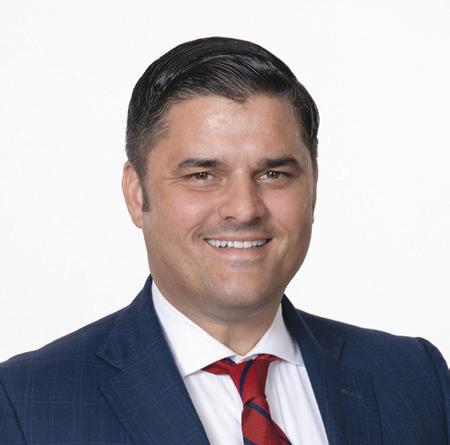
PAUL MERSINO President and CEO
Butzel, Detroit
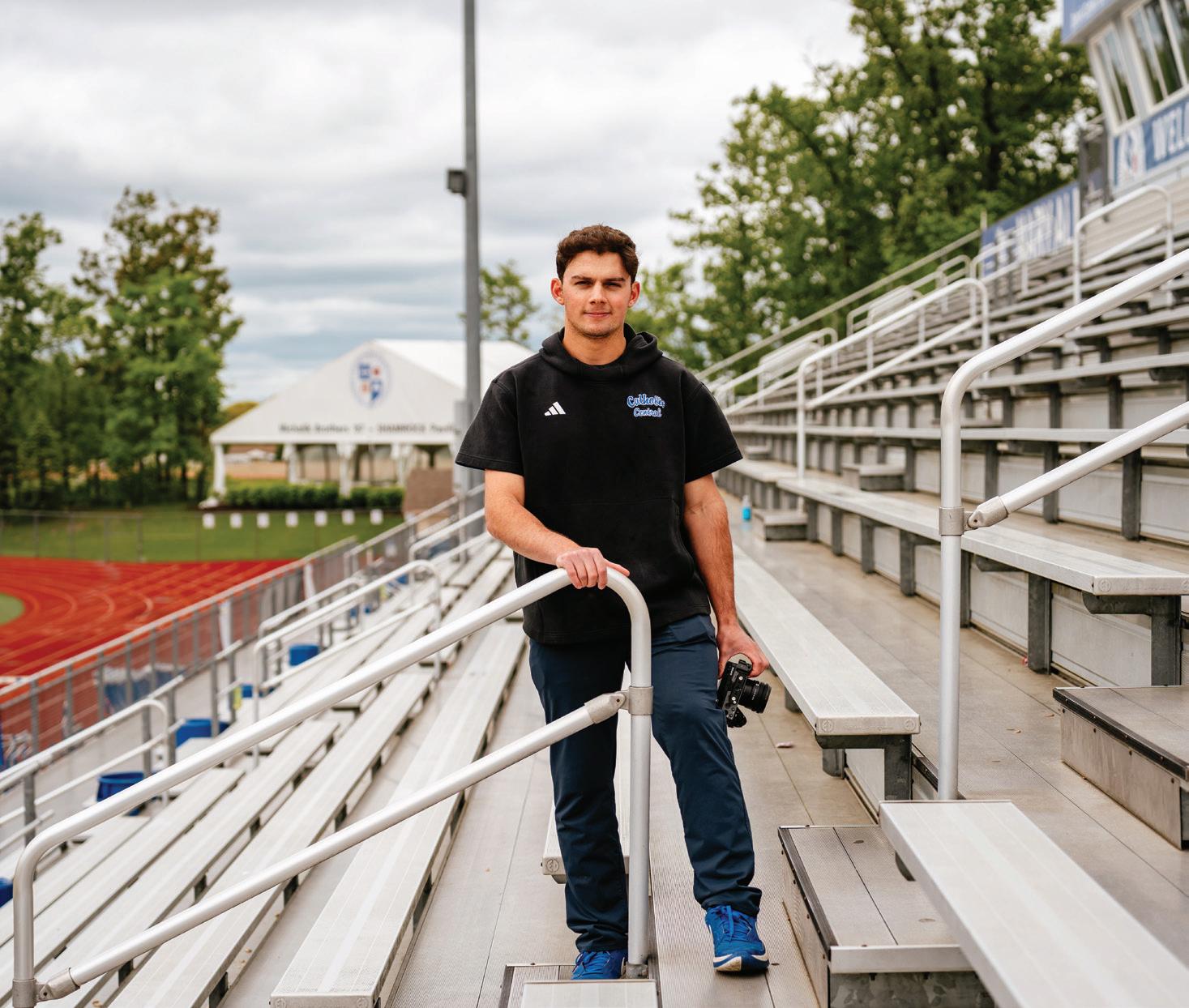
In addition to running his own video company, Dominic Recchione is interning this summer in Catholic Central’s media department.
Detroit, High-Performance Training in Wixom, and the Legacy Center Sports Complex in Brighton.
He also made pre-NFL Draft videos for former University of Michigan players Colston Loveland and Kalel Mullings.
Recchione estimates he’s made around $25,000 with DREffects since last fall.
The middle son of three boys, the pitcher has a stout 2.5 earned run average and is captain of the CC team, but he’s also devoted to his craft.
“I love this stuff,” he says. “I live and breathe this stuff. Even when I’m at the baseball field, I’m thinking,
DB: WHERE ARE YOU?
PM: I’m in Barcelona, where I’m attending the Lex Mundi conference for managing partners of global law firms.
DB: HOW DOES IT WORK?
PM: Lex Mundi is a membership organization of 150 law firms from all over the world. There’s one law firm for each
jurisdiction, and we’re the member firm for Michigan.
DB: WHEN DID IT START?
PM: It began in the 1980s, and we were one of the founding law firms. Each member firm is highly vetted, they’re the best in their jurisdiction, and it’s a great referral source.
DB: HOW DO CLIENTS BENEFIT?
PM: If one of my clients has an issue in London, Vietnam, or Mexico, I can call someone who’s vetted by Lex Mundi in that geographic area, and I know who is on the other line. I can get expert knowledge on a given issue, and that provides our clients with stability and reassurance.
How can I improve this project, and improve that relationship for the better?”
Although Recchione says he doesn’t have specific college plans, he doesn’t think he’ll play baseball at the NCAA level — but he doesn’t rule it out, either. If a scholarship helps him finance his continued study of video production, he’ll take the ball.
“As of right now, I want to focus on my business when I graduate (from high school),” he says.
Post-college, Recchnione says, “I want to help high school athletes get a platform and a presence on social media that will ultimately lead to brand deals.
“Another thing I’d love to do is work for the NFL, MLB, NBA, and NHL as a live content correspondent. I think that would be a big step in my career.”
DB: WHAT ARE THE CONFERENCE HIGHLIGHTS?
PM: The conference rotates between Europe and the U.S. This year, some of the topics are tariffs, cross-border issues, and the advent of AI in the legal industry.
DB: ARE THERE CHALLENGES?
PM: The biggest obstacle
is the level of uncertainty, especially tariffs. Things can change by the day or by the hour, and businesses hate uncertainty. We provide more certainty, and we have an international team we can consult with at a moment’s notice.
— R.J. King


University of Michigan Health C.S. Mott Children’s Hospital and Von Voigtlander Women’s Hospital

















Bob Shapton rides the wave of repairing antique and classic boat engines in Grand Rapids.
BY SETH SCHWARTZ
Growing up in Michigan’s Thumb area, Bob Shapton was immersed in repairing all manner of mechanical parts.
“My dad had every wrench, socket, and special wrench in a large steel toolbox, mixed with machinist tools,” Shapton says. “I learned how to use everything through hands-on training.”
Checking out a neighborhood garage sale when he was 16 years old, he bought a 1952 Mercury Rocket Hurricane KG4 boat engine for $25.
Affection for the Mercury engine triggered his muse, and he continued restoring a couple of vintage boat engines each year.
After graduating from Detroit’s College for Creative Studies in 1992 with a degree in industrial product design, Shapton took a job with Bonnette Design International in Holland.
Three years later, he switched to furniture design in Grand Rapids.
With encouragement from his wife, Mary, he launched Michigan Boat and Engine in 1995.
At the outset, he focused on repairing Mercury engines produced between 1948 and 1962. Today, 75 percent of his repairs are Mark 55 and Mark 25 engines from 1954-1958.
Appearing at a handful of wooden boat shows in Michigan annually since 1995 has helped spread the message. More than a third of Shapton’s customers are in Michigan, another third are in the Midwest, and the rest come from Florida, Texas, California, the East Coast, and Canada.
Half the orders are repeat customers, while the rest learn of Shapton’s skills by word of mouth.
The first step in repairing or refining an engine is understanding the buyer’s preferences. What boat it will be used with, how much horsepower does it need, and should the colors match the engine?
Shapton’s inventory consists of 300 core models. Half the engines are shipped out, while the rest are sold through the shop.
Nearly all of his clients are antique wooden boat owners.
“I take every individual casting apart and rebuild the engine piece by piece,” says Shapton, who has been a one-man operation since the start. “Gear-foot, powerhead, distributors, fuel hoses, and ignition make up most orders.
“I paint them separately and put them together with stainless steel hardware. It’s like a sculpture when I’m finished. Anodizing seals the aluminum,

which preserves and protects it from moisture. I do it the old way — factory assembled, raw casting, and spray it. I also produce reproduction parts and outsource the molds.”
During a recent boat show, Shapton brought 15 engines to display.
Charlie Strang, the former head of engineering at Mercury, was impressed. “This is what Carl Kiekhaefer (who founded Mercury in 1939) would’ve loved to have seen,” Strang said to Shapton.
Apart from marine engines, in 2011 Shapton refurbished a 1948 Sunoco gas station, and an adjoining creamery and print shop in downtown Grand Rapids. The showroom window draws a range of onlookers throughout the day and evening, with a few knocking on the door to get a closer look.
Tom Gilmore, a South Haven resident who had a 1956 Mercury motor with 30-horsepower restored for his 1956 14-foot Feather Craft boat, says, “It took Bob seven months to finish. He goes to such details; it’s like putting a watch together. It’s a work of art.
“The motor was painted ivory white with poppy red on top. There’s no maintenance required. When I’m on the water, other people will pull up and ask about the engine.”










Greenstone Destination Services in Birmingham and others are facing a slowdown in the number of international executives moving to metro Detroit.
BY TIM KEENAN
Helen French, president and CEO of Greenstone Destination Services in Birmingham, has developed a very particular set of skills by helping companies bring employees to Detroit from overseas.
The native of Dublin, Ireland, was educated in England as a pediatric physical therapist and came to the U.S. with her husband 13 years ago. In the last few years, she has helped more than 300 families navigate moving to the United States.
But Greenstone Destination Services, as well as others that offer similar programs, are in a bit of a lull in early 2025, the result of confusion surrounding the Trump administration’s fast-moving immigration and foreign and domestic policies.
“It has been a lot slower,” French says of her business. “A lot of companies are very uncertain about what’s going to happen, especially with the EVs. A lot of companies are sending people back to their home countries.”
Laurie Trinch, vice president of relocation and corporate services at The Agency in Birmingham, sees a similar trend.
EBB AND FLOW
The market for relocating executives to metro Detroit from around the world can be up and down. During times of economic growth, the market rises. More recently, activity has declined due to uncertainty over immigration, tariffs, and interest rates.
“My office is fortunate to handle relocations for transferees in the EV space and, as you know, three years ago there was a strong push for talent in this space,” Trinch says. “It was an exciting time for us, (and that) included international relocations.
“Much of this was driven by the Bipartisan Infrastructure Law to support domestic production of these materials. We started to see a slowdown leading up to the (November 2024) election, but we remain optimistic locally that this work will continue, just scaled back and slower. “
Critics of the current administration are quick to point out the trend started on Jan. 20, 2025.
Not so, according to Dan Gutfreund, principal of Dan Gutfreund Realty Group in Birmingham and a member of Signature Sotheby’s.
“In the last three years I’ve seen a rapid decline of people coming in from overseas to take positions here in the United States,” Gutfreund says. “Most of our relocations are happening within the U.S., not overseas.
“There are a couple of things that are playing big roles in this. First and foremost, post-pandemic, things have really changed a lot in business overall. No. 2 (is the) access (people have) to technology, Zoom calls, and Teams calls. We don’t need people to be here, boots on the ground.”
As a result, executives in other countries don’t need to uproot their families and move. Instead, travel time has gone up while the overall number of relocations has gone down.
New trade and immigration policies aren’t blameless, however, in the slowdown of international relocation. Negative attention being paid to academia is reportedly making foreign educators hesitant to come to the U.S. Local real estate brokers, meanwhile, have heard from their colleagues overseas that the traditional feeling of being welcome in the U.S. is waning.
Nancy Rands, an associate broker at Meredith Coburn Real Estate in Birmingham, says international relocation has slowed more dramatically since January.
“It has absolutely gone down,” she says. “In fact, it’s almost ground to a halt. It has (declined) dramatically since January.”
She points to “the uncertainty of where our economy is going in general” as the reason behind the change. Rands adds, “There are some sectors of the economy where Zoom only goes so far. One of those areas would be medical. In cutting-edge fields like transplantations and research in things like genetics, the last five months have been very impactful.”
Gutfreund relates a recent case where a client came to Michigan as a result of the policies of the current administration.
“Most recently, I sold two houses to a gentleman from Shanghai who is building a battery plant here, a house for his family, and one for his parents,” he says. “That is a direct result of the tariffs and international trade situation between China and the United States.”
The statistics reveal the impact of international workers.
According to the U.S. Bureau of Labor Statistics, in June 2024 immigrants made up more than 19 percent of the U.S. workforce — over 32 million out of a total of 169 million workers — and participated in the labor force at a higher rate than native-born workers.
Since dropping to a low of 61.8 percent at the beginning of the COVID-19 pandemic, the immigrant labor force participation rate recovered to 67 percent in June 2024, higher than the pre-pandemic level of 65.8 percent that same month in 2019.
MOST RECENTLY, I SOLD TWO HOUSES TO A GENTLEMAN FROM SHANGHAI WHO IS BUILDING A BATTERY PLANT HERE ...”
— DAN GUTFREUND
HOME SWEET HOME
From single-family homes to condominiums, and from urban to suburban, an array of real estate companies in metro Detroit help relocate executives to the region from overseas.
In fiscal year 2022, approximately 1.06 million foreign nationals immigrated to the U.S. for work purposes, representing about 41 percent of the total number of authorized immigrants.
As a result, business was booming for area relocation services.
Overall, based on the latest figures, around 47.8 million immigrants resided in the U.S. as of 2023, with 29.4 million being employed.
A significant portion of those employed immigrants worked in management, professional, and related occupations, according to USAFacts.org
In the manufacturing industry, where Greenstone Destination Services and others ply their trade, there were 3.2 million foreign workers — 20.2 percent of the industry — in 2023.
Since the Trump administration took over in January, it has de-emphasized electric vehicle adoption and clean energy initiatives, and emphasized more secure borders and strict immigration policies, contributing to the decrease in demand for cross-border relocation services.
Looking to get a handle on the future of this highly specialized industry, WERC, the Washington, D.C.-based relocation services trade organization, conducted a survey in April of corporate mobility practitioners to determine how the new policies might impact their organizations and the ability to move talent around the world.

HELEN FRENCH, CEO OF GREENSTONE DESTINATION SERVICES IN BIRMINGHAM, has dealt with her share of complications while moving several hundred clients to metro Detroit from points overseas for work assignments.
She’s had to manage indecisive clients, those with pets, children with special needs, and a host of other issues.
One pet that caused her one or two sleepless nights was a horse that belonged to a foreign national who was a competitive equestrian and was moving to western Oakland County.
“The client wanted to bring her horse over,” French recalls, “so that was kind of tricky. I had to do some research.”
First of all, it was an expensive proposition, costing more than $10,000. It involved permits, specialized transportation, quarantine, and finding a place not only to stable the horse, but one that had the type of facilities where the client would be able to practice dressage, an equestrian sport where a horse and a rider perform a series of precise movements in a rectangular arena.
As it turned out, the rider and the horse stayed in the states for about six years.
Another situation involved a family moving to Farmington Hills from India that had a baby and a preschool-aged child who French could sense had a yet-to-be-diagnosed disability.
“In my former life I was a pediatric physical therapist,” French says. “It was clear their child had special needs, but the family didn’t necessarily know that or know how to approach it, and even if I was working as a PT, I couldn’t make a diagnosis.”
While visiting the local school, the staff spent time with the family and determined the child was autistic and needed a special school. “So I directed them to a particular pediatrician and a specialized school,” French relays.
Another couple from Mexico needed to buy a house during the COVID-19 pandemic. “That was a nightmare, as they were first-time homebuyers,” French says.
And there have been some situations even French couldn’t help with.
A client called her at 8 a.m. one day to tell her that his wife was pregnant and they didn’t want to have the baby, and asked what they should do. Not wanting to get too involved in a situation that personal, French gave them a couple of contacts and sent them on their way.
“That was out of my arena,” she says.
— Tim Keenan

Most respondents answered they expect “somewhat negative” to “significantly negative” impacts due to the potential policy actions.
U.S. visa restrictions and trade-related changes, including those specific to the U.S.-Mexico-Canada Agreement (USMCA), are the potential policy actions most likely to have significantly negative impacts on companies and their foreign national populations, according to survey respondents. Most notably, 100 percent of respondents said restrictions on U.S. visas would have a “significant” or “somewhat negative” impact on their organizations.
Canada- and Mexico-related actions are particularly top-of-mind for global mobility practitioners and their organizations, according to the survey respondents. Canada (43 percent) and Mexico (20 percent) are among the largest non-U.S. markets where employee populations are located.
Other findings include:
• Ninety-one percent of those surveyed say changes to the USMCA would have a negative impact on their organization and foreign national populations.
• Ninety-four percent of respondents say restrictions to and/or the elimination of the non-immigrant USMCA Professional Visa for Canadian and Mexican nationals would have a negative impact on their talent mobility programs.
• Fifty-three percent of respondents indicate that their organization would consider moving current and future employees to non-U.S. locations if changes are enacted. Canada is the most likely market (79 percent) and Mexico the fourth most likely (21 percent).
Even though the market has slowed of late, fulfilling difficult requests never goes away.
In 2020, French took ownership of a similar business the previous owner wanted to sell, and launched Greenstone Destination Services. By that time, she had secured her real estate license and had experience assisting hundreds of foreign families set up housekeeping in the U.S.
“I’ll do an initial phone call with clients to find out everything about them, especially any unusual things that they might want or need,” she says. “I explain what I’m there for, tell them I’m there for them 24/7, 365, and find out what dates they’re coming.”
When called into action, mostly for clients in the automotive industry or as a contractor for other, larger relocation companies, French guides individuals and families through the acquisition of a U.S. Social Security number, stateside bank account, and a Michigan driver’s license.
“A lot of companies won’t let them go on their payroll until they get a Social Security card,” she says. “Once they get a Social Security card, I can do everything else.”
Other services range from finding a place for her clients to live, whether they want to rent a space or purchase a home, setting up utilities, and finding schools for her clients’ children to attend.
“I’ll also do school searches, and find pediatricians so the kids can get their vaccinations and start school. Anything after that, if they need specialist doctors or have a child with special needs, I can call Oakland County to get them involved.”
French says she charges $1,250 to help a single person move, $1,750 for a couple, and $2,050 for a family. Those fees lead to annual revenue of $80,000 to $120,000 a year, depending on the number of people she’s assisting.
The entire process can take as little time as two weeks, although it takes longer for others, depending on the specific situation.
“When I came here 13 years ago, we had a German relocation service that wouldn’t take no for an answer and we got through the process pretty quickly,” French says with a chuckle. “Some of the Eastern European clients I work with are very quick decision-makers and can be done in two or three weeks. Other people take months, mostly deciding on the housing situation.
“All I want is to see people happy and settled entering the next chapter of their lives. I have personally gone through the relocation process myself, from Ireland to the United Kingdom, and finally settling in the U.S. in 2012.”
One might expect French’s work to be done when a client moves in, but that’s not necessarily the case.
“After they’re settled in, they’ll call me for any and everything,” she says. “I’ve had calls for suggestions for new schools and for where to go on holiday.”
When
Basically a one-person show, Greenstone Destination Services does use a few part-time assistants when things get busy.
“People skills are the No. 1 quality one needs for this business,” French says. “And you have to have some sort of empathy.”
Although most of her business is in the automotive sector, French is looking to expand into serving any overseas companies that want to start up operations in the U.S.
With metro Detroit being a hot spot for mobility, clean tech, advanced manufacturing, financial services, and health care, French is optimistic about the future of the region and her business.
“I think it’s cyclical,” she says of the recent slowdown in relocations. “There are peaks and troughs. There have been quiet times, though not as quiet as this.
“I think maybe in the third or fourth quarter things will pick up as things settle down. I think it’ll come back. I just have to ride with it.”
Trinch, with The Agency in Birmingham, sees a similar trend.
“Detroit remains very relevant as its workforce leads applications in automotive AI, given the region’s expertise in electrical engineering and controls,” Trinch notes.
“The tariff discussion has been challenging for companies to plan both short- and long-term, which also leads to delaying transferees,” she adds. “I’m hopeful that we’ll see relocations to metro Detroit ramp up soon.”



A series of home invasions targeting a uent areas in metro Detroit has introduced aspects of South American organized crime in ways few residents ever imagined.
BY JOHN SITKIEWICZ

Awave of home break-ins across metro Detroit over the past two years was so well-executed, it was as if the intruders had the keys, security codes, and passwords ahead of time.
Unsuspecting homeowners in the wealthiest pockets of Birmingham, Novi, Grosse Pointe Farms, and elsewhere, along with their security systems, stood little chance of even knowing someone was in their homes.
One of the rst residential invasions, on Feb. 5, 2023, was reportedly orchestrated by a Chilean gang that seemingly was well-acquainted with the target — a manor home along Provencal Drive in Grosse Pointe Farms, a private street with around-the-clock security and a guard shack to prevent non-residents from driving in.
e robbery, discovered the following day by a property manager, caused nothing but aggravation for the homeowner, Maurice “Morry” Taylor, founder and chairman of Titan Industries in West Chicago, Ill., a $5 billion manufacturer of tires, wheels, and undercarriages for trucks and trailers.
“ ey came over the wall in the back of my house,” Taylor says.
From property camera footage, he reports seeing four individuals moving around the backyard, right outside his house. He says they all climbed over a wall that separates his property from Grosse Pointe Equestrian, an upscale club for horse owners.
Each of the invaders was wearing a mask and was dressed entirely in black. One was pacing back and forth on lookout duty, while the other three searched for an entry point.
“ ey came (in) through the back of my house,” Taylor says. “On their rst try, they couldn’t open any windows or doors.”
ree of the individuals eventually entered the home after cutting a large hole through a plate glass window. Once inside, they went from room to room, hitting bedrooms, the great room, a library, home o ces, and even the basement.
Using what appeared to be heavy-duty garbage bags, over the course of a few minutes the thieves grabbed jewelry and other valuables. But they failed to land a big score.
‘ ey trashed the place,” Taylor says. “ ey went through almost everything.”
To the best of his recollection, Taylor believes the burglars made o with two $100 bills he recalls leaving atop a dresser, and three watches.
“Most everything was items belonging to my wife, such as assorted jewelry pieces and designer purses,” he says. “Law enforcement told us later that one of the suspects was a woman.”
So far, Taylor can’t account for why his alarm system wasn’t triggered that evening.
A few months later, on Sept. 29, 2023, Oakland County Sheri Michael Bouchard broke the news that Taylor and other homeowners in metro Detroit were the victims of well-trained thieves, most likely from South America.
During a press conference, he revealed that an outbreak of home invasions across some of the region’s most a uent neighborhoods could soon emerge as a much bigger phenomenon.
As Bouchard and other law enforcement leaders across the country assessed the cause of the uptick in home burglaries, it became evident that changes by the Biden administration to border security, analysis, interventions, and prosecutions contributed greatly to the crime spree.
A task force aimed at getting a handle on the new wave of organized crime has pointed out that the
South American gangs have, in recent years, entered the United States illegally to target thefts at upscale homes, most often in single-family communities.
Chilean government allows, or is aware of, close to 100 home invasion rings that train young men and women to disable residential security systems, identify entry points, and work systematically to locate and steal precious goods.
Once trained, equipped, and transported, the recruits most often slip through the Southern border and make their way to predetermined wealthy enclaves in states ranging from Michigan to Indiana, Ohio, Virginia, Florida, Arizona, New York, and California, among others.
Initially, when Bouchard made the public aware of the targeted residential robberies happening in Rochester, Rochester Hills, Bloom eld Hills, and Novi, there were several known factors.
Investigative work conducted between the Oakland County Sheri ’s O ce, local police departments, the FBI, and the Department of Homeland Security arrived at a series of trends.
Based on all available information at that point, Bouchard stated the break-ins locally resulted in the loss of “hundreds and hundreds of thousands of dollars” of merchandise in the form of jewelry, precious metals, currency, designer watches, purses, and safes.
By all indications, the biggest target was safes, which were either forcibly opened on-site or carried off the premises entirely. It also was noted that the burglaries typically occurred between 5 p.m. and 9 p.m.
In addition, available intelligence suggests heists were planned and conducted by transnational gang members from South America, who were seizing upon the riches of Oakland County.
Some of those seasoned criminals entered the country by exploiting a DHS-administered Visa Waiver Program, or VWP, that allows nationals from 42 eligible countries to travel to the U.S. for tourism or business for stays of up to 90 days without obtaining a
visa. Others are believed to have crossed over the Southern border illegally or by boat, where they’re dropped off along the West Coast.
More than two months after his initial press conference, on Dec. 6, 2023, Bouchard provided an update to the public on the rash of home invasions that were occurring in some of the most affluent areas of Oakland County. The bad news was that the robberies were coming fast and furious.
Quite disturbingly, somewhere between 30 and 40 home invasions fitting an unmistakable MO had been pulled off since that September. In some instances, the break-ins were happening at such rates and the investigations were so fluid, solid numbers were hard to come by.
Of the known home invasions, seven robberies took place over Thanksgiving weekend. Five more followed the weekend after. All of those burglaries, split between Bloomfield Hills and Bloomfield Township, had been conducted in a similar fashion.
For Bouchard, the patterns and frequency of the break-ins began to reveal much about exactly who was targeting Oakland County neighborhoods.
“In terms of the pattern and the frequency, it became obvious to us that we had something going on toward the end of 2023,” he says. “We were seeing the same types of burglaries in multiple communities.”
Interestingly enough, what the agencies working cases were literally seeing, and what Bouchard was sharing with the media, happened to be a fair share of property camera footage that showed the individuals menacing Oakland County neighborhoods broke into homes often valued north of $1 million.
Without question, the people who were out there doing dirty work in Bloomfield Hills, Bloomfield Township, Rochester Hills, and elsewhere happened to be masked, black-clad tactical burglars on a whole new level.
“They’re highly trained and act in a very sophisticated manner, which isn’t the usual burglar on a lot of different levels,” Bouchard says. “They almost participate as a special ops team.”
For starters, much like the home invasion on Provencal Drive in Grosse Pointe Farms, the burglars were working in rings compromised of four to six members. But instead of climbing over property walls, they were making their way onto Oakland County properties behind targeted homes using preplanned routes that passed through wooded areas, open fields, and golf courses.
Once in place, they used a lookout to keep watch and breached suitable entrance points — mostly glass doors or windows — to force entry into some of the most plush residential real estate that Oakland County has to offer.
What really set the theft rings in Oakland County apart, and what ended any real mystery regarding their national origin, came down to what they were doing to sophisticated home security systems.
In essence, they had managed to make them a nonfactor during their home invasion spree simply by using a tactic widely known to be a Chilean calling card, involving nothing more than having a ring
member use an electronic apparatus, often called a jammer, to disable a home security system when the burglars arrived on-site.
Home alarm systems, particularly those operating solely off Wi-Fi, were being taken offline. In several ways, that tactic was the real reason behind all the sinister success Chilean rings were enjoying in cities like Bloomfield Hills, Rochester, and Rochester Hills.
All told, it was why they were able enter manor homes, rummage through the property completely undetected, and take what they could carry before heading off to reach a getaway driver parked in a designated spot, all in a matter of minutes.
In the fall of 2023, the Chilean method of disabling home alarm systems was giving local police departments fits, preventing them from responding to home invasions in progress.
“I would say by late fall of 2023 and winter 2024, we were getting a lot of shared intelligence saying the ones that are in Oakland County, and the most and the hardest (to apprehend), are the Chileans,” Bouchard says. “The only way you’re typically going to catch them is (when they’re) in progress.”
Additional revelations presented during the December 2023 press event included assessments from the task force Bouchard christened the Southeast Michigan Collaborate Arrest and Prosecute team (SEMCAP) that fall.
SEMCAP, which includes agents from the U.S. Border Patrol and the Secret Service, believes the Chilean rings at the time were moving in and out of metro Detroit with relative ease, using false identification to reserve hotel rooms in blocks and rent cars with outof-state plates.
Homeowners have several security measures at their disposal to help prevent break-ins, including hard-wired alarm systems and timers.
“I know there have been times where they’ve used an Airbnb,” Bouchard says. “Sometimes, they go to a hotel.”
From the jump, SEMCAP honed in on the Visa Waiver Program, which Chilean ring members were predominately using to enter the country, for one very good reason. As coincidence would have it, Chile just so happens to be the only South American country that qualifies for VWP participation.
“We know the Chileans are extremely welltrained,” Bouchard says. “We need to have some (federal) pressure to shut that down and stop the pipeline of these newly trained teams that are coming in and hammering us.”
In addition to their skills in tactical burglary, the Chilean rings had something else of significance going for them, according to investigators. SEMCAP and a whole host of local municipality law enforcement agencies around the country dealing with home invasions believe the thieves have roots in an established fencing operation with points in Miami, Los Angeles, and New York City. The operations sell off hot goods and transfer portions of the profits received back to underworld contacts in Chile.
Just how deep those contacts are with respect to syndicate-level crime is really anyone’s guess, but the consensus among law enforcement is someone is running the home invasion operation from abroad, whether a Chilean criminal organization or a wider South American network that provides direction.
Oakland County’s top elected law enforcement official believes the Chilean rings operate far too systematically for that not to be the case.
“When you have a group of people that operates exactly the same way, with the same type of tools, with the same type of movements, the same type of training, and utilize the same path to get into the country and the same processes to dispose of property, the natural conclusion is someone is (doing) this on an organized level,” Bouchard says.

WHAT REALLY MADE THREE MALE COLOMBIAN NATIONALS
between the ages of 25 and 48 decide to try burglarizing a Troy home along Milay Street in the middle of the day last August?
By any objective measure, everything about the attempt on the residence on Aug. 1, 2024, was ill-conceived.
By the time entry was forced, one of the intruders, clad in a dark shirt and wearing a mask, was already appearing live on interior security camera footage — which prompted a 911 call from the homeowner, who told dispatch they were watching the entire episode via their cellphone while at work.
All three intruders were apprehended in short order by responding Troy police officers, who initially came upon them fleeing from the scene.
One was taken following a foot chase. Another was nabbed after being seen walking into a family restaurant. The last person was placed under arrest following a traffic stop involving a Honda Odyssey with a Virginia plate, which he had gotten into as a passenger.
In the end, the intruders were each charged with second-degree home invasion, a 15-year felony. The 25-year-old also received a separate charge of being in possession of burglar’s tools, a 10-year felony.
According to Oakland County Sheriff Michael Bouchard, the carelessness of the Colombian nationals demonstrated they were “very opportunistic.”
More simply stated, Colombians engaging in criminality inside of Oakland County jurisdictions, many of whom happen to be in the country illegally, are known for acting on pure impulse and little else.
As such, they’re often extremely difficult to predict.
In sharp contrast to Chileans, who law enforcement still believes aren’t seeking violence, Colombians are prone to it.
An additional threat looming countywide and across metro Detroit comes from Venezuela.
“Without getting too deep into the water, we know that we have a Venezuelan gang (in Oakland County), as well,” Bouchard says. “We just don’t have a specific crime we can attribute to them.”
Whether that gang has roots with Tren de Aragua, a notoriously
violent gang formed in the Venezuelan prison system, is not yet known.
If so, the odds that its crimes will be traceable in Oakland County, and potentially elsewhere in the region, are next to nil for several reasons.
For starters, Tren de Aragua views any area they operate in as one giant money pit. Its members, who have no qualms with engaging in gratuitous violence, believe anything and everything a community has to offer is theirs for the taking.
Interestingly, Tren de Aragua, which is known to be as close as Chicago and is extensively involved in using data viruses to steal cash from ATMs, running extortion rackets, robbery, and retail drug trafficking, has become something of a case study in recent years for experts in gang culture.
Overall, the consensus to date suggests its members make sadists in MS-13 (aka “Mara Salvatrucha”), a gang having origins going all the way back to the barrios in Los Angeles during the 1980s, appear tame.
Not a single expert anywhere expressed any surprise when President Donald Trump designated Tren de Aragua as a foreign terrorist organization, and said its members are subject to immediate removal from the country by way of an executive order signed in January.
Suffice it to say, a Tren de Aragua presence in Oakland County, whether it be very real or even a knockoff version, would be most unwelcomed at any time, not the least of which has to do with the fact that Oakland County law enforcement officials are currently coming across instances of fentanyl being found in seized marijuana purchased at the street level.
That danger to public safety, which Bouchard mentioned in testimony provided to Congress on Feb. 6 during a hearing covering the tragedy of addiction, in his capacity as vice president of the Major County Sheriffs of America, cannot be overstated.
It’s a situation capable of resulting in unforeseen deaths that would change the lives of families forever — a situation that narcotics pushers in Tren de Aragua wouldn’t lose a moment of sleep over.
— By John Sitkiewicz
Near the end of 2023, something known, and never debated, was what the Chilean rings were doing on the ground in Oakland County.
To sum it up, they were completely having their way in some of the county’s most premier destinations, and making off mightily in ways that few ever even imagined.
“The most regular (home invasion) recipients have been Bloomfield Hills, Bloomfield Township, Novi, Oakland Township, and Rochester Hills,” Bouchard says. “We think in the December (2023) time frame, they were pulling about $1 million a week out of Oakland County.”
Around that same time, the Chilean rings coming in and out of the county also were continuing to avoid arrest, to the point that they might as well have been ghosts.
For all intents and purposes, home security systems, no matter how sophisticated, were essentially being rendered useless in the houses the criminals were hitting.
Overall, albeit by illicit means, Chilean rings were taking full advantage of everything Oakland County has to offer. Ironically, they were doing so for many of the same reasons so many corporate executives and iconic names in the world of professional sports have chosen to live there for decades.
In terms of location, there are multiple pathways in and out from the surrounding metro area off major mile roads and the interstates.
In addition, homes in its cities and townships — ranging from Bloomfield Hills to Bloomfield Township, Birmingham, Rochester Hills, and Oakland Township — are considered by many to be sanctuaries in which to live, raise families, and entertain.
If that’s not enough, prior to the home invasion outbreak, spectacular crime in many of those areas was rare to the point of almost being unheard-of.
In more ways than one, criminals specializing in home burglaries really couldn’t ask for a better American county for practicing their trade.
Oakland County Sheriff Mike Bouchard, left, and his team, have been at the forefront of investigating a rash of home burglaries in the region.
Having it too good in Oakland County may be one reason why the Chilean rings haven’t even bothered with Macomb County, according to Jennifer Putney, communication manager for the Macomb County Sheriff’s Office.
“We haven’t had any high-end home break-ins (conducted) by transnationals from South America in our jurisdictions,” Putney says.
It might also explain why anything to do with the high-end home invasion phenomenon barely even registers in Wayne County, says Sheriff Raphael Washington.
“Fortunately, we haven’t seen the uptick in robberies Oakland County is experiencing,” Washington says. “Our local communities haven’t reached out for help in our areas of expertise, like digital forensics. We stand ready to assist Wayne County communities and our colleagues in Oakland and Macomb if needed.”
Meanwhile, over in Oakland County, come December 2024, the estimated number of Chilean ring home burglaries was eye-popping. “I’d say somewhere around 60 home invasions is a fair estimate,” Bouchard says.
Given that number, one thing couldn’t have been clearer with 2025 fast approaching. Collectively, law enforcement in Oakland County needed to hit pay dirt on the Chilean ring.
As circumstances had it, that’s exactly what occurred on Dec. 2, 2024, when Novi police were able to respond to a home invasion in progress on Equestrian Trail, near Eight Mile and Beck Road.
The events of that evening began at 7:19 p.m., when a homeowner monitoring their home security system over a mobile phone placed a 911 call to report malfunctions and the presence of individuals outside attempting to force entry.
Fortunately, police units were nearby, actively patrolling the area in response to a series of home invasions in Novi that began on the night of Halloween.


Four residential burglaries suspected to be the work of a Chilean ring, based on similar patterns from earlier home robberies, occurred between Oct. 31, 2024, and Nov. 15, 2024. All the homes targeted, and subsequently broken into, were located near Eight Mile, Beck, Garfield, and Haggerty roads.
Every one of the homes was approached after dark through wooded areas and open fields, typically between 6 p.m. and 9 p.m.
In turn, each home had its security system disabled, forced entries were made through rear doors, and, in the case of one home, a second-story bathroom window.
Novi police investigators believed the properties had been surveilled to ensure residents would be away when the thieves approached a target.
Interestingly, something about that Chilean ring’s operation that evening had gone horribly awry. The home security system at the property they targeted hadn’t been taken completely offline. It was functional enough to send out a mobile alert to the homeowner, who was away.
The thieves must have known the authorities had been alerted, as it is believed they quickly fled the scene in a white van with an out-of-state plate. Soon after, their escape attempt was thwarted by a Novi police patrol car responding to the 911 call.
A traffic stop on the van was attempted, but it sped off, prompting a chase to ensue. That chase ended abruptly when the van turned off Beck Road onto Iroquois Court and finally pulled over.
Four suspects exited the van and ran off into the night. Three managed to get away and remain at large. However, one suspect, a female, was apprehended following a short foot chase.
Identified by Immigration and Customs Enforcement officers after initially providing Novi police with a false name, Vania Herrera Valdes, 21, of Chile, was verified to be in the country illegally and had a criminal record.
According to Novi Police Department Commander Jason Meier, Valdes only spoke Spanish and immediately requested a lawyer after being taken
South American gangs targeting suburban communities in the U.S. are both brazen and well-organized. In many cases, the thieves are trained in their home countries.
into custody. No interrogation took place. Currently housed in the Oakland County Jail on a retainer issued by ICE, on Dec. 5, 2024, Valdes was charged with one count of second-degree home invasion, a felony punishable by up to 15 years in prison, and one count of resisting arrest, a two-year felony.
The takedown of a Chilean ring member during a home invasion in progress was no small victory for Oakland County law enforcement.
As far as strategy goes, the tactical deployment of patrol officers to an area known to be experiencing heightened home invasion activity worked as intended. But as laudable as the result was, something about that episode is still regrettable.
The three getaways are still out there, somewhere. No one knows who they are, let alone where they are.
By now, the likely Chilean nationals could be off in another state, working with a ring specializing in home invasions.
It’s possible that they could even be in the business of burglarizing the homes of professional athletes, like NFL quarterbacks Patrick Mahomes of the Kansas City Chiefs and Joe Burrow of the Cincinnati Bengals, who both suffered robberies in the fall of 2024 that were suspected to be linked to a Chilean theft ring.
Professional basketball players in Milwaukee and Memphis also saw their homes broken into last fall while they were away playing games. In the case of Bobby Portis of the Milwaukee Bucks, $1.5 million in stolen items was reported.
Or they might even be back in Chile, living comfortably somewhere off the Pacific coastline.
For all anyone truly knows, they may even be somewhere in Oakland County, inconspicuously blending in, and just waiting for directions from a higher power telling them to get back to work.
There’s no solace in that at all.
IN MANY WAYS, DETERRING SOUTH AMERICAN HOME invasion rings from wanting to make an attempt on a residential property involves being willing to create illusions.
More specifically, it’s about maintaining the appearance that someone is at home whenever a residence happens to be empty, especially during evening hours. Current data indicates that Chilean home invasion rings typically approach targeted properties in the early evening hours, before 9 p.m.
Although it’s admittedly simple enough, the age-old method of leaving the lights on can make all the difference when it comes to preventing transnational criminals who are watching from somewhere close by from being able to determine a life pattern. The use of timers to switch off light sets and turn on televisions can go a long way toward suggesting that someone is at home.
Homeowners with properties that back up to woodlands or are surrounded by known darkened areas may also want to consider installing a motion-activated lighting system. For those truly seeking the most advanced measures in home protection, making plans to install a hardwired security camera setup capable of capturing activity inside and outside a residence on continuous live-feed video should be a priority.
Al Shenouda, a co-founder and managing partner of City Shield, a security strategies and services provider in Detroit, believes that level of monitoring can exponentially increase any homeowner’s situational awareness, particularly with respect to any burglary-type activity that may be occurring on the outside.
“Video monitoring is a key to safety,” he says.
As for countering the Chilean criminal underworld tactic of disabling home alarm systems operating off Wi-Fi, Shenouda, a former security adviser with DHS, believes the criminals are “using a Wi-Fi interrupter, often known as a jammer.”
The most effective step to defeat such jamming devices, regardless of type, involves having one’s home security system completely reconfigured to solely work off a hardwired setup.
“Hardwiring and battery backup is the name of the game,” Shenouda says.
In essence, that means having an alarm system that’s designed to operate off a home’s electrically-wired power source, and is backed up by a battery to protect against weather-related outages or unforeseeable electrical surges.
Shenouda also recommends the installation of a dual-path communicator, which is compatible with most alarm systems typically installed by home security companies.
The devices operate by simultaneously sending off signals over cellular and through internet protocol (IP), which is hardwired. What’s more, they’re not susceptible to outside jamming attempts.
Aside from protective measures focused on high-tech solutions, additional recommended steps range from developing good habits to guarding personal information.
If someone decides to purchase a safe to store valuables and personal records, Oakland County Sheriff Michael Bouchard recommends that they consider heavy-duty models capable of being anchored to a floor or bolted into a wall.
Anything involving information appearing online is another issue unto itself.
Chilean home invasion rings want any information about a targeted home — and who happens to live inside — that they can find. Data about any targeted home’s address and the owner’s life story will do.
With that, they view everything having to do with social media as a treasure trove, especially for people posting vacation pictures.
“Other than physical surveillance, we already know that the criminals basically data-mine via social media,” Shenouda says.
He and his team regularly advise clients to proceed with caution whenever publicly posting any information regarding business travel, daily excursions away from home, and vacation plans.
“Keeping things to yourselves, and alerting trusted relatives and neighbors that you’ll be away, are other good strategies,” Shenouda says.
— By John Sitkiewicz
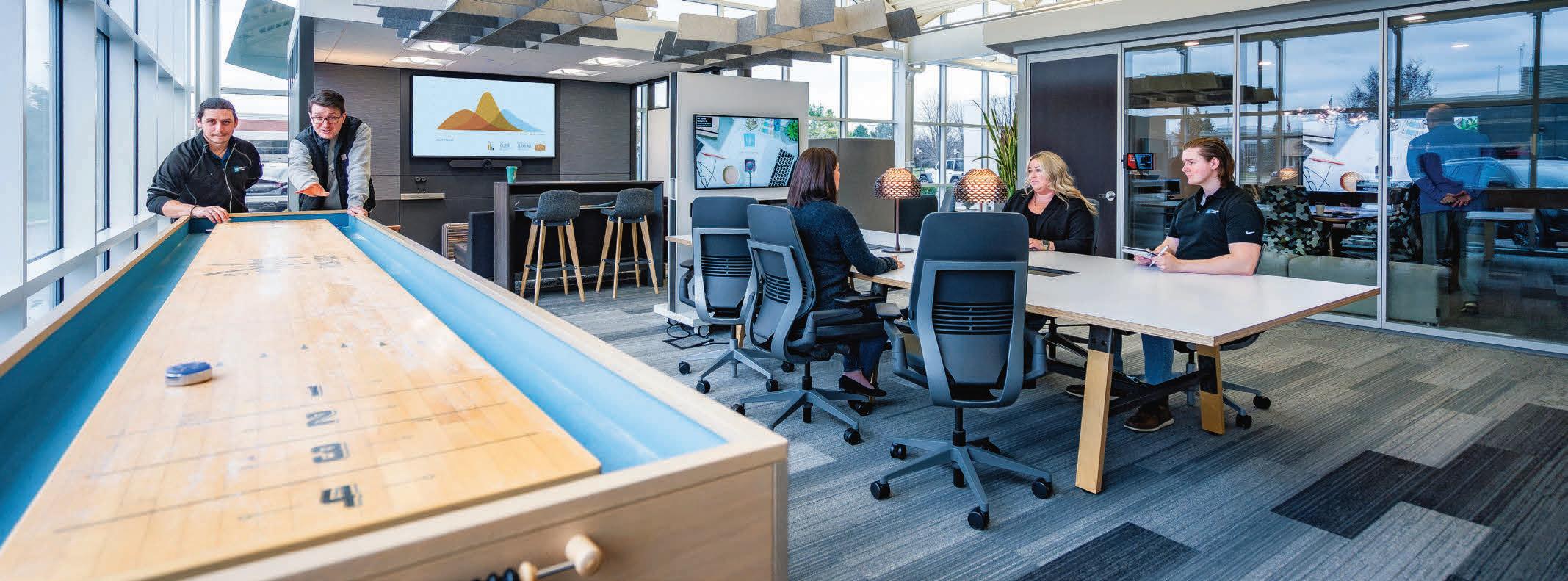
An Authorized Dealer


The 2025 Powered by Women honorees reflect on the challenges of leadership, growing their respective organizations, and the lessons learned along the way. In addition, each honoree is wearing and describes their attachment to a personal item of jewelry that was given to them or borrowed from an influential woman in their life. To meet the Powered by Women honorees, please join us at the DBusiness Breakfast Series on Aug. 6, from 8:30 a.m. to 10:30 a.m., at the Gem Theatre in downtown Detroit. For tickets, email Maya Stephenson at mstephenson@hour-media.com.

President and CEO, Automotive North America
Continental, Auburn Hills
Employees: 40,000
Revenue: $45.6B
The U.S. Marine Corps prides itself on its ability to adapt, improvise, and overcome. Aruna Anand, who’s served as president and CEO of Continental’s North American automotive business in Auburn Hills since December 2022, can relate.
Anand spent the first 20 years of her life in Chennai, in southern India, and studied in strict Catholic institutions before earning a bachelor’s degree in electrical and electronics engineering at Anna University in India.
“As an only child, my parents were always pretty protective of me,” Anand says. “I even had to commute an hour each way to college. But my mom and dad decided it was best for me to study in the U.S., because they figured that exposure would set me up well for life.”
From India, she came to Michigan in the winter of 1995 to work on her master’s degree in computer science and engineering at Oakland University in Rochester Hills.
“I had never seen snow in my life before,” she recalls with a chuckle. “For me, coming to the U.S. was a massive shift in culture. I was like a sponge, taking everything in and integrating with the culture.”
While at OU, Anand landed an internship, then a full-time a job, at Siemens Automotive in Auburn Hills as a software engineer working with cruise control algorithms and similar projects.
“I could have easily retired working as a software engineer,” she says. “If you love something, there’s no reason to change.”
But then, a mentor at Siemens Automotive (which had become Siemens BDO) encouraged her to step out of her comfort zone and to work in di erent areas of the company.
So, after 13 years in powertrain software, the last several years as head of software for gasoline engine and transmissions systems for the electronic controls business unit within the company’s powertrain division, she moved to interior systems software. After she had spent six months as head of software for the interiors group, Siemens BDO was acquired by Continental.
After the acquisition, Anand found herself in a smaller role than she had at Siemens, again working on software for individual products. But as the dust settled and people left the company, Anand was asked to take over Wireless Product Group Engineering within the Connected Car Networking business unit of Continental’s Vehicle Networking and Information business area.
“Overnight, instead of just software, I became responsible for hardware, software, systems, and mechanical,” Anand says. “This allowed me to learn how to deliver a product from scratch to production, the whole life cycle.”
After eight years in that position, she led another group called Continental Engineering Services and picked up profit and loss responsibility. It also allowed her to learn the entire Continental product portfolio and di erent industries.
In five and a half years, the group grew five times.
“For me, my career is more about having a learning environment, feeling challenged, and respecting the people I work for and work with. If that’s the case, that’s all I’m looking for.”
During the COVID-19 pandemic, Anand was named head of Architecture and Networking for North America, one of the largest business areas at Continental. Her leadership was noteworthy during this time as she navigated her team through unprecedented challenges, ensuring employee safety while implementing strategies for economic recovery and innovation growth.
“The personal learning from that (experience) is you’re not always going to be the best expert in what you’re doing, and your success is making sure the team around you (is made up of) all the right people who are able to have the technical competence to support you,” she says.
In December 2022, she was appointed president and CEO of Continental’s North American automotive business, a role that was vacant for nearly nine months. While maintaining her Architecture and Networking responsibilities, Anand jumped right in to re-engage with the entire Automotive North America team, reviving and re-energizing employees, fostering an environment of inclusion and learning, and boosting collaboration and engagement.
“Aruna brings an outstanding combination of experience and talent to the president and CEO Automotive North America position,” said Nikolai Setzer, CEO of Continental AG when she was named to the post. “She is a respected leader in many areas that are the focus of our future growth.”

Among the accolades Anand has received throughout her career is an Automotive News PACE Award in 2013 for a Tire Pressure Monitoring System: Localization on Synchronized Emissions, a Women of Color Professional Achievement Award in 2017, and being named an Automotive News Rising Star in 2018.
More adaptation is on the horizon for Anand and Continental. In September, the Automotive North America business is being spun o to form AUMOVIO, with an independent listing on the Frankfurt Stock Exchange.
“A spino of automotive has the potential to create competitive opportunities, enhance agility, and increase transparency,” Wolfgang Reitzle, chairman of the Continental Supervisory Board, said when the announcement was made last year. “As a strong, independent entity, automotive would be able to harness its full potential for creating value. In addition, investors would be able to invest in a company focused specifically on automotive electronics.”
Anand will be at the helm of the new company.
“I’ve been constantly learning,” she says. “I’m using all of what I’ve learned and applying it to this role. I look at the people around me, and I’m still the sponge I used to be. I learn more and more that it’s not about me. This is my dream job, and I know that my success is the success of the people around me that leads to the success of the company.”
— Tim Keenan






“(The ring on my le hand) is my mom’s ring. She used to wear it on special occasions. My mom and dad had to undergo a lot of sacri ces — some spoken, some unspoken — so that I could be the best version of myself. Who I am today is a re ection of how they raised me. It feels like I have my mom really close to me while wearing this ring.”










This year’s photo shoot was held at Lily’s & Elise Tea House in Detroit, a luxury tea lounge providing European-style afternoon and high tea, along with mocktails, fresh pastries, and small plates. Lily’s and Elise is located along the historic Livernois Avenue of Fashion (19037 Livernois). The tea house (lilyandelise.com) is open Sunday, Wednesday, and Thursday from 10 a.m. to 6 p.m.; and Friday and Saturday from 10 a.m. to 8 p.m.
It only seems natural that Katie Bigelow, who grew up as a self-described “Air Force brat,” would end up not only serving her country in uniform, but in business.
The CEO of Mettle Ops in Madison Heights leads a company that designs, integrates, and manufactures advanced war-fighter solutions for a range of military clients.
“Initially, we were going to be a program management company,” Bigelow says. “Now I have six program managers and 26 engineers on staff. We’re really an engineering company now.
“Our engineering team can design anything for an Army ground vehicle, be it for powertrain, mobility, or survivability. We also do kitting, packaging, and manufacturing, and help the government with supply chain obsolescence.”
Mettle Ops began in 2013, which was one of the most challenging years of Bigelow’s life. In addition to starting the company that year, she was diagnosed with cancer and lost one of her nine young children.
As a result, she didn’t land her first contract until the third quarter of 2015. “It took me a long time to recover from that year,” she says. “This whole thing started while daydreaming about a side gig while the kids were napping.”
Mettle Ops has since evolved into a $30-million enterprise with 62 employees serving the Army, Navy, Air Force, and Marine Corps, and it has amassed more than $200 million in government contracts focused on soldier survivability.
The company’s current biggest project — $87 million over three
“I wore one ring for my chief of staff, and one ring for my CFO. I work with them every day, and I wouldn’t be where I am without them.”

years — is focused on developing reactive armor tiles. It’s a passive system that hangs on the outside of heavy armored vehicles that have explosives packed into them.
Once a rocket-propelled grenade penetrates the tile, its explosives detonate outward, preventing the projectile from penetrating the hull and injuring the soldiers.
“This is a major manufacturing contract for us,” Bigelow says. “We use suppliers from all over Michigan, and some in other parts of the country.” Assembly and kitting is done in Madison Heights, and the explosives are added in Kentucky.
A current Mettle Ops engineering project is a generic test turret on which the government can integrate equipment and test it to make design decisions, while the OEMs are developing the rest of the vehicle.
“We’re pretty technology agnostic,” she says. “Instead of selecting the technology that’s most profitable for us, we can choose the technology that’s best for the vehicle platform and the warfighter.”
Bigelow’s life as an Air Force brat started with her birth in Maine. Her family then moved to Nebraska and stayed there while her father took posts in Korea and Washington, D.C. Eventually, they ended up together in Colorado, where she graduated from high school.
Her father retired from the Air Force as a colonel, then worked on flight navigation and space and missile defense systems.
Shortly after graduating from high school, Bigelow enlisted in the U.S. Army as an Arabic linguist, and spent time at Fort Hood in Texas and in Bosnia. With not much need for Arabic speakers in Bosnia, she became a warrant officer in the aviation section and flew Black Hawk helicopters for seven years, leaving the service as a chief warrant officer 2.
Her overseas service included a tour in South Korea and in Iraq between 2005-2008, where she performed medical evacuation missions during that conflict.
Fast-forward to Madison Heights, where Mettle Ops is evolving its business to keep up with trends on the battlefield.
“The ground vehicle community is very important to us, but we’re also looking to expand into aerospace and defense,” says Bigelow, who in the past year has started a drone company, named Celestus, by buying another firm’s drone-related intellectual property.
Katie Bigelow CEO
Mettle
Ops, Madison Heights
Employees: 62
Revenue: $30M
Bigelow says drones can be driven to a launch point on the battlefield and, once in the air, they can drop a payload “like a toaster” when it’s near or over a target.
Most drone parts, however, are manufactured overseas and not in friendly countries, and can’t be used in defense applications, she notes, adding, “So we have our own drone motors that are made entirely in the U.S.”
Celestus currently is developing Class 1 drones, which carry payloads of up to 2 pounds. In addition to ordinance, other drone payloads can include cameras and radio jamming equipment.
“We also have speed drones, which go pretty fast — but I can’t say how fast,” she says.
In addition to protecting today’s troops, Bigelow says she’s committed to empowering women, veterans, and disadvantaged groups. She says she creates opportunities and strives to serve as a role model for future leaders.
Whether it’s designing equipment for ground vehicles or drones, Bigelow says the mission of her company reflects her time in uniform.
“My job as a medevac helicopter pilot was very closely connected to soldiers living or dying, so I’m very personally connected to that, still.”
— Tim Keenan
CEO
Unite Digital, Bloomfield Hills Employees: 95 Revenue: $100M+

“I’m wearing my mother’s pearls; she gave them to me when I graduated college. They mean a lot to me on two levels: One, I was the first person from my family to graduate from college. Secondly, I had always wanted to be an astronaut, and was really inspired by the movie, ‘Hidden Figures,’ because it told the story of the women in NASA who broke the male-dominated world of astronauts of that time. For me, I’m in auto, a very male-dominated ecosystem, so it takes on that second meaning of being able to make it and pave the way for others.”
Automotive manufacturers and their affiliated dealers may be separate companies, but most consumers don’t make that distinction when they explore buying a car.
People typically visit OEM websites, look at OEM social media channels, and engage in all kinds of ways with the manufacturers.
In her 12 years at FordDirect (which culminated in her becoming its CEO), Stacey Coopes worked on developing digital tools to help bridge the gap between the customer data Ford was accumulating and the dealerships that could use it to improve their sales and customer service performance.
But she saw an opportunity beyond the Ford universe, recognizing that OEMs and dealers across the industry could benefit from platforms that empowered the better use of customer data.
So, in 2016, following 13 years at FordDirect, Coopes decided to take a risk and invest her own capital in launching Unite Digital in Bloomfield Hills.
It’s been a rapid rise since she hit the ground in 2017. Today the company has surpassed $100 million in annual revenue, and has nearly 100 employees who serve both OEMs and dealerships.
Unite Digital’s clients include Mitsubishi and Stellantis, as well as many companies in their networks.
“We sit in the middle between the OEM and the dealers,” Coopes says. “We have technology that allows the integration of the franchise networks to work with an OEM’s digital marketing strategies.”
In essence, Unite Digital is allowing the dealerships not only to white-label the promotional efforts of their affiliated OEMs — incorporating their own names, messaging, URLs, and other custom details — but also to plug in the customer data, to ensure the delivery of the message is targeted and strategic.
Unite Digital also negotiates with vendors at scale, so each dealership’s costs reflect the volume of the larger OEM’s network, rather than having to pay higher rates that only reflect the individual dealer’s own volume.
As a result, dealers don’t need to spend time figuring out how to use the data to improve their strategies. Unite Digital applies it to their campaigns in such a way that it’s all done for them.
Another example of the technology’s use is letting customers know about the need to take a particular action with their vehicle.
“We take all the data from the OEM to know when the vehicle needs to be serviced, or any recall message from the OEM that needs to go right to the customer,” Coopes says.
“We send the right messages at the right time. All this data is just plugged into a third-party solution that we partner with, that can integrate the data and can provide us with an out-of-the-box solution for the dealer.”
The basis of the Unite Digital model is the idea that customers aren’t distinguishing between OEMs and dealers in their car-buying experience, and Coopes doesn’t think they should have to.
“When those two entities aren’t coordinated, it feels like you’re working with a very separate company,” Coopes says. “It doesn’t improve the brand experience, but as the technology gets better, customers are expecting this frictionless consumer experience.”
Some of the industry’s interest in the Unite Digital approach has come from the perceived threat from certain manufacturers — some in the U.S., but especially in Europe — trying to remove the dealer from the equation and sell directly to consumers.
That hasn’t worked well, Coopes says, because the manufacturers don’t really understand retail.
But it did show the OEMs they need to improve their coordination with dealers to make the sales operation as smooth as possible, and that starts with getting their customer data out of silos and getting it into the hands of the people who are actually dealing with the consumers.
When Coopes took the concept to market, she realized she needed to be able to show the other OEMs that Unite Digital had built something that understood their business models.
“We began to work on unique solutions that would allow us to be first in the market and show innovation,” she says.
“We did a program, for example, with Google where we were the first agency to take an OEM’s inventory and populate it on every dealer’s Google business profile. That project was unique in allowing us to gain traction with the OEM, and it had tremendous value because so many consumers go to the Google business profile but don’t actually go to the website.”
In the eight years since Coopes established Unite Digital, she has had to manage the transition from doing much of the work hands-on to training and empowering a full team. That leadership experience has taught her a lot.
“You take something very small and figure out how to grow it,” Coopes says. “The key to that is how you evolve as a leader, because in the beginning you’re doing everything and running all parts of the business.
“You’re in every aspect of the proposals and the work that needs to get done in terms of financing and how the company is generating cash. And then, as you grow, the key is how do you bring on the right people that have the skill sets you need to take the company to the next level?”
Coopes decided she wanted a team of independent thinkers who could nevertheless align behind a common vision.
“There were already two big competitors in the market, so we had to do things faster and more nimbly, and that challenge really caused our team to gel,” Coopes says.
At 54, Coopes is finding satisfaction in the challenges and the triumphs, and is keeping her focus on achieving more. “As long as it’s fun, I want to stay,” she says.
— Dan Calabrese
While studying packaging engineering at Michigan State University in East Lansing, Liz Door, chief supply chain officer at Ford Motor Co. in Dearborn, couldn’t have imagined the path her career would take.
Door, who once played on the volleyball, basketball, and softball teams at Oxford High School, now patrols Ford headquarters with concerns about government affairs and international trade.
“Fifteen or 20 years ago, purchasing was about cost and technology,” Door says. “Now it’s about all kinds of different things. There are geopolitical circumstances and international trade.
“You need to have legal knowledge, business acumen, (and know about) government affairs, communications, and HR. There are all of these skills that supply chain management requires, and I think that’s what has kept it interesting to me.”
Door has been engaged throughout her career, which started with packaging internships at Kraft General Foods in New York and Post Cereal in Battle Creek.
“I picked packaging engineering because my understanding at the time was that MSU had the best package engineering school in the country, and I was confident that I’d get a job in that major,” Door says of her choice of college major. “Soon after the internships, I decided packaging probably wasn’t my calling.”
Her first job out of college in 1995 was as a resident quality engineer for Prince Corp. at a Chrysler assembly plant in St. Louis. Prince Corp. was an electronics supplier that eventually became part of Johnson Controls.
After a year at that job, Door decided to return to Michigan. She leaned on her grandfather, who played golf with someone from GM who arranged an interview for her. The interview went well and led to an opportunity as a contract package engineer for General Motors Service Parts in Flint, working on boxes and graphics for AC Delco.
“I got to do more than work with boxes,” she explains. “I met a lot of people on the sales and marketing side.”
Ultimately, she was offered a full-time position in the purchasing department at GM Truck in Pontiac. Four years later, when GM’s truck and car businesses merged, she moved to Warren, where she spent the rest of her 15-year GM career in a variety of supply chain roles.
“I enjoyed going to the plants and seeing how things go together, the engineering aspect of it,” she says. “I honestly never thought I’d leave GM, but I got a call about an opportunity at Whirlpool to be on a business team and be head of North American procurement. I got to be a bigger fish in a small pond.”
After leading Whirlpool Corp.’s North American procurement, she was named the appliance company’s executive vice president of global strategic sourcing and was made a member of the company’s executive committee.
In 12 years at Whirlpool in Benton Harbor, on the state’s west side, she found that although they have their differences, the automotive and appliance businesses are quite similar. Like the auto industry, the appliance industry was under pressure from Asian competitors and had small profit margins. Sales are tied to innovation, design, price, and brand experiences.
“One of the things I’ve learned is that I like working at product companies, especially products that make the tasks you really don’t like doing easier. To work on all the products that delight people in the kitchen was pretty cool, although my experience at GM was the foundation for everything.”
The COVID-19 pandemic brought into focus just how important the kitchen, and its equipment, can be to families.
“When the pandemic hit, the kitchen became the center of our home,” Door says.
Two years ago, a couple of years removed from the pandemic, Door got a call from Ford about becoming its chief supply chain officer.
Her objectives at Ford are to improve quality, reduce costs, and leverage product connectivity and digitalization, while improving relations across the company’s supply chain.
Although purchasing and supply chain management have evolved over the years, recent times are presenting even more challenges for people in Door’s business.
“What are we not facing?” Door asks with a chuckle. “If I start mapping and plotting out a calendar or an order of time and events, there’s always some black swan event.”
A black swan event is defined as a rare, unpredictable, and impactful event that defies expectations and significantly alters the course of events.
“There are these circumstances that arise that require problem-solving,” Door says. “I continue to be in roles that require problem-solving, so I must like it.”
Unlike some other pioneering women in the auto industry, Door says she didn’t notice too many hurdles along the way that were specifically due to her gender.
“I didn’t pay attention to that until others made me aware,” she says. “There were some awkward moments on the assembly plant floor as a 21-year-old, but eventually you become part of the ecosystem.”
With two college-age children and a retired husband at home, Door doesn’t see retirement in the near future. Rather, she expects to ramp up her involvement in the United Way, which she became affiliated with 10 years ago on the west side of the state. She’s also eager to continue her work under the Blue Oval.
“To be part of the transformation and modernization of Ford is pretty exciting,” she says.
— Tim Keenan

“I’m wearing this ring that was gifted to me from my grandmother. When I was a child, I used to play with all of her shoes and jewelry. It’s one of my favorites.”
Liz Door Chief Supply Chain Officer
Dearborn
President and CEO
University of Michigan Health/CS Mott Children’s Hospital and Von Voigtlander Women’s Hospital, Ann Arbor
Employees: 5,000+
Revenue: NA
Thirty-five years as a health care administrator has brought Luanne Thomas Ewald a wealth of experience in business, operations, and executive leadership — all of which have positioned her to lead Michigan’s top pediatric and women’s hospitals.
But ask her which experiences most influence her approach to her job as president and CEO of CS Mott Children’s Hospital and Von Voigtlander Women’s Hospital, part of University of Michigan Health in Ann Arbor, and she’ll describe the role of being a mom, along with her favorite job at the age of 21 as a cuddler.
Both of these have driven her belief that children’s and women’s hospitals are different, and they must put as much emphasis on the patients’ experiences as on their medical care.
“I enter every day with my mom patch on,” Ewald says. “And even before I was a mom, (I was) just really trying to understand what the needs of our families and our kids and our women are. It became crystal clear once I became a mother.”
Ewald believes families are an important component of community strength, and that’s often most evident at critical moments. But she thinks they deserve more.
“What they don’t expect are a lot of the other things,” Ewald says, “like pet therapy, or music therapy, or a child life specialist who helps distract the child with an iPad or video games while the child is undergoing treatment or getting poked.”
Ewald readily admits that she didn’t bring all of these innovations to U-M Health upon being recruited in 2020 from Children’s Hospital of Michigan; many of them were already in place. But when U-M was looking for its next leader for the Mott/Von Voigtlander segment of its health operations, Ewald’s empathy toward the experience of families made her a natural fit.
That empathy had its roots in Ewald’s undergraduate years at Marquette University in Milwaukee, where her dorm was across the street from Children’s Hospital of Wisconsin. She got used to watching people going in and out, and became interested in their experiences and situations.
She says the most formative experience came during graduate school at Xavier University in Cincinnati, between 1991 and 1993. That’s when Ewald landed an internship at Children’s Hospital of Cincinnati , which she describes to this day as the favorite job of her life.
“I was a cuddler,” she reports with obvious affection for the experience. “My job was to rock and feed the babies in the neonatal intensive care unit from midnight until 5 in the morning. Never really having set foot in a children’s hospital, that was my first exposure.
“I just saw, especially in the middle of the night, those extra touches. The nurse came in with a fresh blanket for the baby, or sometimes someone would sing a lullaby to the baby. I saw the team going above and beyond what was in their job description.”
One example of how Ewald has incorporated that philosophy into her work at U-M Health is an on-site music studio called Sophie’s Place, which allows children to come down from their rooms, play instruments and make music videos, and even do their own mixing.

“My ring is a cameo ring that my grandmother gave to my mother. I remember when I was a little girl looking at this ring when my mother wore it. It’s now a memory of both my grandmother and my mother, so I wear it every day. It also reminds me that I need to be that kind of strong, powerful, and loving woman that they were, and to carry it on to my own two daughters.”
What they create is often piped into the other children’s rooms so everyone can share in the experience.
U-M Health also has implemented a comfortable and fully equipped family center, where parents and relatives can step away, check their computers, or otherwise take a mental and physical break from the experience of going through the treatments with their children.
Success, of course, breeds demand.
Ewald has had to deal on a regular basis with the fact that the beds in her facilities are 100 percent full just about all the time. To mitigate that squeeze while still finding ways to bring quality care to as many patients as possible, she has worked out partnerships with Pontiac-based Trinity Health Oakland and with Lansing-based Sparrow Hospital.
The latter has actually gone from a strategic partner to part of the U-M Health family, and Ewald says both the Pontiac and Lansing hospitals are able to provide many of the same types of care for patients who live closer to those facilities.
“The physicians are seeing patients in other parts of the state, and we’re trying to keep a lot of them close to home so
they only have to come to Ann Arbor for major surgeries or treatments,” she says.
And because there’s no slowing the demand, Ewald is on the lookout for more ways to expand capacity.
“Demand is very great for our services, and our beds are full every day,” she shares. “We’re looking at planning for the future. We also know we need more beds, so we need to determine how many beds more beds we need. Are they in Ann Arbor? Or are they in surrounding communities?”
Ewald also serves on a variety of community boards, including The Children’s Foundation (which she currently chairs), along with United Way of Southeastern Michigan (incoming chair), the Make-A-Wish Foundation, Ronald McDonald House Ann Arbor, The Parade Company, and Mercy High School.
Still, nothing motivates her more, she says, than providing the most positive experience possible for the women and children who come under the care of her organization.
“You can tell, as they’re walking in, they’re not feeling great,” Ewald says. “But when they walk out, there’s a smile on their face.” — Dan Calabrese
Last fall, starting her fourth full year in charge of her educational community, Aimeclaire Roche, who goes by “AC,” was beginning another successful academic cycle for Cranbrook Schools. Yet even during this June’s commencement ceremonies at the landmark Bloomfield Hills institution, she couldn’t be blamed for occasionally casting her eyes forward.
Roche, president of the Cranbrook Educational Community, is already looking ahead to 2027 — the year that will mark the centennial of the Cranbrook Foundation, which was established by George and Ellen Booth.
The foundation endowed an elementary school, separate high schools for boys and girls, an art academy, a science institute, and Christ Church Cranbrook. All were built and continue to flourish on the country estate the Booths acquired in 1904.
Rather than planning a fireworks extravaganza for the anniversary, Roche is preoccupied with larger pragmatic and philosophical questions.
“How do we expand our programs?” Roche asks. She thinks of the Horizons Upward Bound college-readiness program for students from the Detroit Public Schools.
In 2024, there were 41 graduates. Of the cohort, one was joining the U.S. Navy, and the rest were indeed college-bound. Horizons Upward Bound started about 60 years ago. “How do we ensure that program continues to thrive?” she asks.
The other point concerns maintaining and enhancing Cranbrook’s “thought leadership,” as she expresses it. “How do we make sure that we continue to be a nexus, a place where incredibly thoughtful scholars and creators and scientists can come together?”
Making her mark by solving these and other questions would satisfy Roche, who came to Bloomfield Hills in 2018 as director of Cranbrook Schools, and advanced to president of the Cranbrook Educational Community in 2021.
Previously, she spent nine years as head of school at The Bishop’s School in La Jolla, Calif. The little-known connection between Bloomfield Hills and La Jolla is that The Bishop’s School was founded in 1909 by Ellen Booth’s aunt, Ellen Browning Scripps, co-founder of The Detroit Evening News — today’s Detroit News
“I have this phenomenal exposure to two different institutions that come out of the same family and (are) commitments to education,” Roche says.
“I’m wearing my mother’s set of pearls. She was one of the strongeest women I’ve ever known. She managed to raise five crazy kids, then go back for a master’s degree in social work, and a law degree later in life. She wanted to use her later adulthood after we all left the house to apply what she learned as a mother, and in her graduate work to be an advocate. She is a blessed memory now, but very much with me when I wear these.”

Growing up in Pittsburgh, Roche was inspired by her parents, who were first-generation college graduates. With their encouragement, and the help of “amazing, caring, dedicated” teachers, she learned ancient Greek and Latin in prep school at Exeter Phillips Academy in New Hampshire.
She went on to earn bachelor’s and master’s degrees at Harvard University and Columbia University, respectively, and observed that the devotion to Classical languages — sometimes called “dead” languages — is only possible with the assistance of skillful teachers. She says it made her determined to help pass on the knowledge she had gained.
“I was, I think, tuned into being an educator from (the time I was) a very, very young kid,” she says. “If there was any sort of surprise for me, it was that schools are really communities and are more than the life of your single classroom; they’re the life of all of those classrooms, and all of the things that happen on the field or in other venues. All of it, together, makes the experience.”
If Cranbrook offers its own twist to the formula, it comes from the institution’s emphasis on interdisciplinary experience and lifelong learning. The Booths’ “bold founding vision” places Cranbrook as “this kind of beacon in the community” that coming generations would keep improving.
A good example of the interdisciplinary approach is seen in the weaving program established in 1928 by Loja Saarinen, whom Roche calls one of the “amazing women creatives connected to Cranbrook.” Loja managed the institution along with her husband, Eliel, the Finnish architect who was Cranbrook president, and decided to create textiles that complemented his designs.
It turns out that weaving is more than artisanry; it’s a metaphor, too, and now Roche casts her eyes back to Penelope, the faithful wife of Odysseus who worked her loom during his years of wandering, as described in “The Odyssey.”
“The very act of weaving is so emblematic of what any of us does, pulling the threads of a complicated tapestry and pulling them together to make that beautiful whole,” she says. “Of all the characters in the world of Cranbrook, I actually see her (Loja) as so emblematic of Cranbrook at its best.”
Assuming Cranbrook’s presidency meant moving further from the classroom and into the tedious depths of fiscal and financial oversight. Roche looks after the Cranbrook Schools, Academy of Art, Art Museum, Institute of Science, Center for Collections and Research, and the Cranbrook House and Gardens.
The task of managing all of the departments isn’t too daunting, she says, noting it’s the work that allows all the other initiatives to go forward. And she doesn’t necessarily find financial administration, infrastructure considerations, or fundraising efforts to be harder than teaching.
Contributing in this administrative way to the exhibitions, educational programs, and tours gives her “great joy,” she says.
Meanwhile, Roche shows signs of becoming a thoroughly entrenched member of the greater Detroit community. “For me, personally, I’m just so excited about what’s happening in Detroit as a city,” she says.
With her husband, Nathan Costa, an organist and instructor of Latin, she enjoys following the Tigers, Red Wings, and Pistons. They also visit independent artists in their studios and, on another scale, occasionally take in “something as grand as the DIA.”
Roche
President Cranbrook Educational Community, Bloomfield Hills Employees: 900 Revenue: $88M
The Chevrolet Detroit Grand Prix was in the offing in early June, but IndyCar racing isn’t the kind of pro sport Roche follows. Nevertheless, numerous Cranbrook alumni have achieved a high rank in the auto industry, so she’s forward-looking when it comes to other aspects of automotive culture.
“You’ll always find me on the berm at the Woodward Dream Cruise,” she says of the school’s main entrance north of Lone Pine Road. “I think that’s the most unbelievable local event ever.”
— Ronald Ahrens

“My mother and I designed these earrings together. We bought the stones together, and had them made by a jeweler in India.”
Tanya Skilton’s journey from Calcutta to Detroit as executive director of strategy, innovation, and customer care for General Motors Co. Global Purchasing and Supply Chain has been anything but a direct flight.
“I’ve lived in many different places, but I’ve lived in Michigan three separate times,” Skilton says. “It keeps bringing me back.”
Skilton’s story begins in Calcutta, where she met St. Mother Teresa of Calcutta, known during her life as Mother Teresa, twice during her childhood. The first time was when Skilton was 5 years old, and the second time was when she was 16.
“The first time was kind of a random encounter,” Skilton recalls. “The second time, I was a princess in a school play, and we decided to give the proceeds of the play to Mother Teresa. I got to hand her the money, and there was a picture of me in the paper.”
After graduating from her 150-year-old Christian all-girl high school, she started college in Calcutta before making the leap to the College of Wooster in Wooster, Ohio, majoring in economics and communication.
Leaving India, a very traditional country, wasn’t easy, but Skilton had help from her mother.
“My mother had a full scholarship to Cornell and her father wouldn’t permit her to come to the U.S. as a single young woman,” she shares. “When I started having dreams of leaving Calcutta, my mother was enthusiastically supportive.”
Skilton’s first job out of college was with the Customer Service Group of Federal Mogul in Southfield. It was her first stop in Michigan.
“I was answering 300 to 400 phone calls a day, taking orders for piston rings and gaskets,” she says. “It was where I started sounding less Indian. The accent was getting in the way.”
Federal Mogul also is where Skilton received a crash course in everything automotive.
“They made us take apart a V-6 engine and put it back together, with supervision,” she says. “I was an economics student. I didn’t know anything. And we had to go under a vehicle and look at the ball joints and CV joints, because we were taking orders for these things and we needed to be able to picture what they were talking about.”
After two years at Federal Mogul, Skilton studied at the Thunderbird School of Global Management, which is part of Arizona State University.
Executive Director of Strategy, Innovation, and Customer Care, GM Global Purchasing and Supply Chain
General Motors Co., Detroit Employees: 162,000
Revenue: $187.4B
General Motors recruited Skilton out of Thunderbird to be a buyer in 2000. She would be based in Michigan — her second stay in the Great Lakes State.
She moved to production control and logistics before being sent to Japan, where she was part of an advance guard of the purchasing team to work with Subaru; GM was planning to produce a Saab model for international markets. Even though that plan didn’t work out, she stayed in Japan helping Subaru modernize its supply chain.
Skilton left Japan and GM in 2004 and joined the Rio Tinto Group mining company in Australia. She spent 12 years with that company — nine years in Australia and the final three in Singapore.
“They were looking for automotive best practices for their purchasing and supply chain,” she says. “They knew they were 20-something years behind.”
While in Australia, she was part of a team that acquired fully autonomous vehicles for Rio Tinto to help promote safety in mining operations.
“I’m what you call ‘techno curious.’ I’m not technologically qualified, but I love technology and I have a commercial brain. I was able to bring that technology to life in a way that was affordable for the company, and that makes a huge difference. Fatalities go to zero immediately, and the productivity goes up as well. We could operate 24/7, eliminating five drivers.”
Her time in Singapore was spent selling and marketing copper and diamonds Rio Tinto mined in the Land Down Under.
At the end of 2016, she came back to GM as the automaker was ramping up its electric vehicle and autonomous vehicle activities.
“Coming back to Mary Barra’s General Motors, I felt like I was breathing pure oxygen,” Skilton says. “Instead of seeing the question marks in peoples’ eyes when you walk into a business setting, you have a seat at the table and get right to it. You don’t have to prove that you even have a voice.”
Prior to accepting her current post, Skilton led the sourcing of critical battery materials, founded BrightDrop’s procurement and supply division, took GM’s first Smart Cities software platform Future Road from concept to launch, and partnered with Cruise Automation to forge viable sources of sensing and computing technologies to enable Level 4 vehicle autonomous operations.
“Now my days revolve around tariffs and trade policy,” she says. “Now I get to use my economics degree.”
She describes her job as solving complex problems and performing strategic forward-thinking, yet helping the business solve today’s problems.
When she’s not hard at work, Skilton serves on the board of directors of the Asian Pacific American Chamber of Commerce, the Michigan Minority Supplier Development Council, the Center for Advanced Procurement Studies, and FiveTwo, a Christian organization that equips entrepreneurs so they can start new ventures. She also supports outreach and missions at her local church.
— Tim Keenan
E’Lois Thomas President
SEEL, Detroit Employees: 130 Revenue: $141M
Upon returning from a recent conference in Florida, E’Lois Thomas had the chance to take care of a few things at the o ce before starting a holiday weekend.
Thomas had spent most of the week in Jacksonville at the annual meeting of the Southeast Energy E ciency Alliance (SEEA), for which she serves on the board of directors. Although attendees stayed at an oceanside resort, Thomas never went into the water — but she did enjoy the view.
“It’s definitely a town that I will visit again,” Thomas says in her merry, emphatic way.
After years in corporate accounting led her to become vice president of finance at MCL Jasco Inc. in Detroit, Thomas joined its subsidiary, SEEL — Solutions for Energy E cient Logistics — as chief administrative o cer.
She served for a more than decade until 2021, when she was named SEEL’s president.
The company shares quarters with MCL Jasco at 7140 W. Fort St., a repurposed building that used to house the Detroit Police Department’s 8th Precinct. As president, she oversees SEEL’s energy-management programs, with concentrations in finance, IT, and administrative support.
The company is a nationally certified minority business enterprise that operates various channels of sustainability solutions. Besides implementing energy management strategies for small businesses, SEEL does workforce development and even o ers grant-writing coaching for program applicants.
“My role is to set the vision to drive strategy and ensure execution,” Thomas says. “I lead with a real focus on growth, operational excellence, and community impact.”
She explains that she works to build strong relationships with SEEL’s utility clients and focuses on developing new market opportunities. Beyond the performance metrics, though, is a “deeper mission” of equity and access.
“That’s what I do on a day-to-day basis,” she says. “I also call myself a culture-keeper. I call myself that because I’m always trying to take leadership, trying to support our team’s development, and just ensuring that our values show up every day.”
The path Thomas followed to reach her present seat is marked by a string of educational attainments that started during her youth on Detroit’s east side, when she joined the Detroit Area Pre-College Engineering Program to nurture her avid embrace of math and science.
After earning a bachelor’s degree in accounting from the University of Detroit Mercy and an MBA in management from Walsh College in Troy, she had an eye-opening experience when she became a member of the American Association of Blacks in Energy.
“I was able to see that it was OK to allow yourself to lead from your (geographic) area,” Thomas says. “Sometimes that’s the most di cult thing, your region, and (getting) people (to accept) you where energy isn’t as hot.”
When she first joined SEEL, she sought a Green Energy Management certificate from San Diego State University.
“Energy was very prevalent on the West Coast, and it wasn’t that prevalent or known in the Midwest,” Thomas says. “I wanted a program where I could learn about the importance of energy. I was so enamored with solar panels and windmills and all of the things that they (Californians) had.”
Another step, completed in 2017 after a seven-year e ort, was earning a Ph.D. from North Central University in Minneapolis. As part of her dissertation, Thomas conducted what she calls “a qualitative multiple-case study” on innovation and revenue streams in small and medium enterprises, looking for applications at MCL Jasco and SEEL.
“Part of my research in my published work is around making sure your human capital, your investment, and your team is always a priority,” she says.
A point of pride is starting SEEL’s learning institute and o ering training as a community asset.
“We do grant-writing training within our team. We also do building-science training for the BPI (Building Performance Institute) certification, which is the accreditation needed within the energy space.”
Looking back, it seemed to Thomas as though her Ph.D. would represent the end of formal learning, but becoming president of SEEL caused her to think again and look for a program to help improve her strategizing and decision-making skills. She followed







through with a certificate from the Women’s Leadership Program at the Yale School of Management in 2021.
Additional inspiration comes from a local source: Joyce Hayes Giles. Besides knowing and admiring Giles — the former senior vice president of DTE Energy — Thomas read the book, “The Energy Within Us: An Illuminating Perspective from Five Trailblazers,” which Giles co-authored.
“What I learned in watching her is that you can bring femininity into the boardroom, and that’s OK. You can be your true authentic self, and that’s OK.”
Devoted to public service, Thomas relishes working with youngsters. She is vice chair of Detroit PAL and belongs to the boards of Franklin Wright Settlements and Results Mentoring, the latter of which her husband, Charles Thomas Jr., is the founder and CEO.
She also became a member of the Detroit Athletic Club in 2021, and works with a community outreach subcommittee there.
“It’s so funny,” she says. “The DAC supports a couple of schools within the Detroit Public School system, and what makes it so meaningful for me is those two schools are Nolan Middle School and Pershing High School, and both are schools that I went to.
“Walking those halls as a student, I never imagined I’d return years later to serve and give back. So that’s very exciting work for me.”
— Ronald Ahrens




“This watch is more than a beautiful accessory — it’s a deeply personal reminder of love, loss, and presence beyond time. My sister gi ed it to me with ‘Dr. Thomas’ and a heart engraved, honoring a milestone my mother wasn’t physically here to witness: my doctorate. Though she couldn’t celebrate that moment with me in person, this gi reminds me that her love is timeless and will always with me — no matter what time it is.”
















DRE WALLACE CEO & FOUNDER OF OPNR


Detroit was recently named the #1 emerging startup ecosystem in North America. Advancing the success of businesses statewide, MEDC supports the $60 million Michigan Innovation Fund. With well-rounded resources and collaborative communities, we welcome entrepreneurs from everywhere to bring their breakthroughs here.
Start your future with us at MICHIGANBUSINESS.ORG

TTricia Keith, president and CEO of Blue Cross Blue Shield of Michigan, is leading the way in lowering health care costs, boosting quality, and seeking pharmaceutical reform legislation.
his past January, Tricia Keith became the first female president and CEO in Blue Cross and Blue Shield of Michigan’s 86-year history when she succeeded Dan Loepp. Keith is only the third person to hold the positions in the last 40 years.
Growing up on a working dairy farm in west Michigan, Keith has held leadership positions at BCBSM since 2006. Most recently, she served as executive vice president and COO of BCBSM and president of Emerging Markets, a $22-billion division.
Last winter, she took over the reins of a $40-billion company with more than 11,000 employees in Michigan, nearly 2,000 employees at subsidiaries outside of the state, and 5.1 million members in Michigan.
What’s more, she faces the challenges of leading a business that last year suffered significant financial losses due to the increased utilization of health services since the COVID-19 pandemic and rising costs.
During his record 18-year tenure as CEO, Loepp had adeptly transformed the company from a large, single-state
Tricia Keith, president and CEO of Blue Cross Blue Shield of Michigan in Detroit, leads a $40-billion company with 11,000 in-state employees who help serve 5.1 million members.
BY BILL DOW | NIC ANTAYA
health plan into a diversified, multi-company enterprise while navigating and leading changes that were needed due to the enactment of the Affordable Care Act.
His predecessor, Richard Whitmer (the father of Michigan Gov. Gretchen Whitmer), saved the company from virtual insolvency, added new members, and produced muchneeded stability.
Facing multiple challenges of her own, Keith appears more than ready to make an impactful mark on BCBSM, just as the two previous CEOs have done.
“I was deeply honored to be named president and CEO, and was really heartened by the reaction our employees had,” Keith, 54, says during an interview in her 20th floor office, with its panoramic view of the Detroit River, Windsor, Ontario, and the Renaissance Center.
A sports fan who loves watching the Detroit Tigers, especially of late, Keith’s office décor includes replica football helmets from Central Michigan University and Michigan State University (schools she attended), along with Detroit Lions

Profile: A nonprofit mutual insurance company
Founded: 1929
Headquarters: Detroit
President & CEO: Tricia Keith
Employees: 11,000+
Revenue: $40.6B

In 2029, Blue Cross Blue Shield of Michigan will reach its 100th anniversary. Today, the company includes Blue Care Network of Michigan, the largest HMO in the state.
and Red Wings helmets that she proudly displays in front of the picture windows. A Tigers helmet is next on her wish list.
“I expected women in the workforce to feel good about my promotion, in the role model sense — ‘If you see it, you can believe it’ — but one of the surprises for me was the reaction from men,” says Keith, who recalls greeting employees at the door every morning during her first two weeks, while “a thousand” selfies were taken.
“One gentleman said, ‘We were talking at our tables and agreed that we wanted our daughters to see it,’” she shares. “Women make a lot of the decisions when it comes to health care, so having that understanding can only benefit our company and members.”
In just her third month on the job, Keith had the unpleasant task of announcing the alarming 2024 BCBSM financial report that further placed into focus the challenges she faces.
It was revealed that within its core health insurance business, the company paid out $100 million per day in health care for its members ($12 million more than 2023), while paying $3 billion more for medical and pharmacy services than it had the prior year, resulting in an underwriting loss of $1.7 billion and a -4.2 percent negative operating margin. Pharmacy claims alone had increased $900 million from the previous year, although the losses were partly offset by strong performance from the nonprofit company’s investment portfolio.
In early June, Blue Cross Blue Shield of Michigan announced it laid off 220 nonunion employees and eliminated more than 400 open nonunion jobs.
The insurer also is in contract talks with area health systems over the cost of care.
Overall, health insurance carriers nationwide have reported the financial challenges of skyrocketing costs, largely due to the increased utilization of health care by an aging population, along with escalating hospital and prescription drug pricing.
According to a 2024 report by the American Medical Association, “Health spending in the U.S. increased by 7.5 percent in 2023 to $4.9 trillion, a growth rate significantly higher than the 4.6 percent rise in 2022. Apart from the 10.4 percent rise in 2020 due to the COVID-19 pandemic, it is the highest growth rate observed since 2003 (8.5 percent).”
On top of that, Keith and the BCBSM team are working in a difficult and highly charged environment as patients across the country have become increasingly disgruntled with health care in general.
That fact was never more apparent than last December, when UnitedHealthcare CEO Brian Thompson was shot and killed on a New York City street. When arrested, the alleged assailant reportedly was carrying a letter critical of the health care system, and the cartridge cases used during the

shooting were inscribed with the words “delay,” “deny,” and “depose.” For weeks afterward, some people on social media sympathized with the shooter and used the incident to vent their anger about health insurance companies.
A 2023 Harris poll commissioned by the American Academy of Physician Associates noted that “More than 70 percent of U.S. adults feel the health care system is failing to meet their needs in at least one way, and that patient satisfaction also suffers due to the high costs, inaccessibility, and confusing logistics of U.S. medical care.”
Sitting across from Keith’s desk is a small metal fixture that spells “Achieve.” She says it’s her second strength, as identified in a Gallup personality assessment taken several years ago during a talent development initiative. Keith says her No. 1 identified strength was “Focus,” while the others were “Significance,” “Command,” and “Competition.”
“In my work, focus means looking at a complex issue and determining what we need to work on and what will drive it forward,” she says.
Based upon her 19-year ascendency and success at Blue Cross, Keith has certainly been focused and has proven to be a high achiever.
Her strong work ethic was first nurtured while growing up on a 131-year-old Centennial dairy farm in Scottville, outside of Ludington, in west Michigan.
“My responsibility was the calf barn, both before and after school,” she says. “If I didn’t show up and feed the cows, the calves didn’t eat. I learned about ‘showing up,’ and one of the things I like to tell people is that the world is run by those who show up.
“You can show up in a lot of different ways, like participating in meetings. I’m very proud of my farm upbringing, and what I learned carries through to this day.”
Originally Keith planned to become a teacher, but instead she obtained Bachelor of Arts degrees in political science and German at Central Michigan University, where she graduated in 1993. In 2009, she earned an Executive MBA from Michigan State University.
“Growing up where I did, I wasn’t sure of all the other career possibilities. One of the things I liked about CMU is that it prepared me for opportunities I didn’t know existed,” she says.
An important lesson I learned is that great things happen when self-interests align (and) you work toward a common goal ...
— TRICIA KEITH
Keith
Following an internship with State Sen. George McManus, a position she created with CMU, Keith became a legislative assistant for Republican State Rep. Robert Bender before holding other positions in state government, including working for Gov. John Engler during a 15-year career in Lansing.
The experience she gained while working in state government paid dividends as a BCBSM executive.
“Working in the state Legislature taught me a lot, including how critical state regulation and public policy is, and how it impacts our heavily regulated business,” Keith says.
“An important lesson I learned is that great things happen when self-interests align (and) you work toward a common goal while seeking to understand what the other side is seeking to accomplish (and how that impacts) what you’re trying to accomplish. Generally, you can find a way to make it work,” she says.
As a legislative intern, Keith became acquainted with Loepp when he was serving as chief of staff for Speaker of the House Curtis Hertel. Soon, they were working on issues together, although from opposite sides of the aisle.
“I thought Tricia was very sharp and extremely talented, so I thought of her when I was setting up my team when I was the CEO designate,” says Loepp, who joined BCBSM in 2000 as vice president of governmental affairs and later was chief of staff for Whitmer before being named BCBSM president and CEO in 2006. “You have to hire good people, and you’re looking for talent and potential, and that was the case with Tricia.”
Keith began her BCBSM career as senior vice president, corporate secretary and services, and started on Loepp’s first day as CEO. Before joining BCBSM, she was director of business operations for the Michigan House of Representatives, and was previously president of external relations at the Michigan Economic Development Corp.
“I wasn’t the decision-maker as to who would replace me, but she had 18 years at the company to show her wares in different settings and the board was able to see that,” Loepp says.
“She got things done. Tricia will have a lot of decisions to make, along with the board, on where they want to go from here. She’s going to do a great job, but it will be very challenging.”
Clearly there’s a mutual admiration between Loepp and Keith.






“I learned so much from Dan, and I’m very grateful for the opportunity he gave me,” Keith says. “He had a knack for hiring great people with talent and allowing them to do their jobs. He also knew how to read the tea leaves on what was going to happen with the business and politics.”
Although Keith says it’s complicated to explain how the company su ered signi cant underwriting losses in 2024 (“for every $1 BCBSM took in, we paid out $1.04 in member care”), two factors stand out beyond increased utilization from members: e unregulated and rising pricing by drug manufacturers, and the escalating prices charged by hospitals resulting, in part, from health system consolidations.
Last year, while in ation was 3 percent, BCBSM paid almost 15 percent more for members’ pharmacy claims than it did in 2023.
A recent RAND Corp. study found U.S. drug prices were 2.56 times higher than those in 32 comparable countries, with brand-name drug prices averaging 3.44 times higher.
Further, a 2024 report from the Centers for Disease Control and Prevention (CDC) found the high cost of prescription drugs caused more than 9 million adults to not take their medications as instructed.
“Do you realize that all those drug ads we’re all tired of seeing on television are tax-deductible by the pharmaceuticals?” Keith asks, incredulously. Meanwhile, BCBSM also is actively seeking pharmaceutical reform legislation that includes a proposal to lower the 12-year exclusivity period for biologic drugs to seven years, to bring competition to the market earlier as well as to lower prices.
A 2024 study by Harvard University, Yale University, and others showed consolidation in the U.S. hospital sector contributed to reduced competition and higher prices for hospital care.
Keith points out hospital pricing increased 2.5 times from 2000 to 2024.
Southeast Michigan-based health systems have experienced several dramatic consolidations in just three years.
Many hospital systems tout potential cost savings when bidding to expand through acquisitions, but so far in the state market, those savings have yet to be demonstrated.
In 2022, Beaumont Health and Spectrum merged and formed the 22-hospital Corewell Health, while University of Michigan Health acquired Lansing-based Sparrow Health in 2023, and last year Henry Ford Health and Ascension Michigan launched their newly combined organization.
“ ey told us when they were trying to consolidate that it wasn’t going to impact pricing, and so now we’re working with them to try and have them stand by that commitment,” Keith says.
In addition to addressing the issues of a ordability, access, and quality health care, the BCBSM leader says she’s determined to make sure BCBSM is a sustainable company.
“ ere are a lot of things we need to do to promote a ordability by working with hospitals, physicians, pharmaceuticals, and looking at our own administrative costs,” says Keith, who also is reviewing all of BCBSM’s assets and a liations in terms of growth and the appropriate use of those assets. “We’re not going to ask anything of our health care partners that we’re not willing to do ourselves.”
Besides having to raise premium rates to counteract the increasing cost of health care and improve the bottom line, as many other companies have done, Keith introduced a BCBSM Accelerated program, which includes a three-year plan to cut $600 million in administrative costs. One component involves o ering voluntary separation o ers to non-bargaining employees.
“ is o er was a way to honor the service and signi cant contributions from employees across the business,” says Keith, who looks to reduce administrative costs by $285 million this year. “It was sad to see a lot of experience walk out the door, but these are the things we had to do to promote a ordability and serve our members. We were very pleased with the response.”
Keith also says that generative AI is being used as a business tool to improve operations and e ciency.
She notes that many in the public may not understand that BCBSM is a nonpro t mutual health insurance company, meaning it doesn’t have shareholders, nor is it pro t-driven.
“We don’t pay shareholders and we’re not trying to make money on health care, but we try to break even,” Keith says. “Last year we had a negative 4 percent operating margin. Over the past 15 years, we’ve had less than a 1 percent margin.”
In advance of the A ordable Care Act, in 2014 BCBSM, which had served as Michigan’s “insurer of last resort,” was able, through 2013 legislation, to have its regulatory structure changed to a mutual health insurance company — enabling it to diversify its product lines and make it a “more fair playing eld.”
In turn, the company is required to pay taxes (“more than $166 million in 2024”) and contribute up to $1.56 billion over 18 years to e Michigan Endowment Fund, which provides grants bene ting children and seniors in several health-related areas.

s consumers and health insurance companies struggle with paying the escalating costs of prescription drugs and hospital bills, many people may not realize that a handful of near-monopoly “middlemen” called Pharmacy Benefit Managers (PBMs) and Group Purchasing Organizations (GPOs) allegedly inflate costs.
They also control a large part of the health care marketplace and reap enormous profits. Surprisingly, there’s scant independent research on the impact these organizations have on patients, hospitals, and insurance companies.
According to the Federal Trade Commission, “PBMs serve as middlemen negotiating the terms and conditions for access to prescription drugs for hundreds of millions of Americans. Due to decades of mergers and acquisitions, the three largest PBMs now manage nearly 80 percent of all prescriptions filled in the United States.”
A detailed 2024 FTC O ce of Policy Planning Interim Sta Report states:
“(PBMs) wield enormous power and influence over patients’ access to drugs and the prices they pay. This can have dire consequences for Americans, with nearly three in 10 surveyed Americans reporting rationing or even skipping doses of their prescribed medicines due to high costs. … PBMs oversee critical decisions about access to and a ordability of medications without transparency or accountability to the public.”
An extensive 2024 New York Times investigation concluded, “The job of the PBMs is to reduce drug costs. Instead, they frequently do the opposite. They steer patients toward pricier drugs, charge steep markups on what would otherwise be inexpensive medicines, and extract billions of dollars in hidden fees.”
To date, despite numerous Congressional hearings and bipartisan support for PBM reforms that include targeting conflicts of interest, spread pricing (where PBMs charge health plans or employers a higher price for medications than what they pay to pharmacies), and the lack of transparency regarding proprietary rebates negotiated between PBMs and drugmakers, Washington has failed to enact reform legislation.

In May, when President Trump signed an executive order asking drugmakers to voluntarily reduce the prices of key medicines in the United States, he expressed a desire to cut out PBMs, although he did not disclose details about how he plans to do so.


“We’re going to cut out the famous middleman,” Trump said. “Nobody knows who they are. … I’ve been hearing the term for 25 years. We are going to cut out the middleman and facilitate the direct sales of drugs at the most favored national price directly to the American citizens.”
Time will tell if PBM reforms will ever be enacted.
Meanwhile, GPOs date back to 1910, and were first formed to help health care providers such as hospitals realize savings and e ciencies by aggregating purchasing


volume and using that leverage to negotiate discounts with manufacturers, distributors, and other vendors.
The Hospital Supply Chain Association, which represents leading GPOs, claims that “GPOs save the health care system up to $55 billion annually, and save providers an average of 10-18 percent on products and services.”
Not everyone agrees.
In his 2024 updated white paper, “A Cost Analysis of the 1987 Medicare Anti-Kickback Safe Harbor for Group Purchasing Organizations and Pharmacy Benefit Managers,” author Phillip Zweig, executive director and co-founder of Physicians Against Drug Shortages, concludes that, “although the sole purpose of a GPO was to save money for facilities, GPOs inflate the cost of drugs, devices, and supplies for hospitals, clinics, and alternate care facilities.”
Zweig said when Congress exempted GPOs from criminal penalties for taking kickbacks and rebates from suppliers in 1987, the “safe harbor provision gave rise to a ‘pay to play’ scenario and a perverse financial incentive that encouraged GPOs to negotiate higher rather than lower prices for health care supplies.”
A handful of GPOs for years have controlled hundreds of billions of dollars in annual sales of medical supplies and equipment provided to nearly all of the nation’s hospitals and health care providers.
With less competition and lack of access to manufacturers not connected to the few GPOs that have contracted with hospitals, health system supply chain managers can’t shop around for lower prices. Only licensed wholesalers and distributors can sell to a hospital.
In this magazine’s 2018 article, “Medical Monopoly,” award-winning investigative reporter Norm Sinclair found that although GPOs are charged with saving hospitals money within a secretive, anti-competitive marketplace, they actually drive up costs.
Phillip Abraham, founder and CEO of Northville-based Brilliancy Deep Tech (formerly CloudFace), was hired by Loma Linda University Medical Center in California to streamline their supply chain and reduce spending, which he did.
“I beat their GPO’s prices by 20 percent to 80 percent,” Abraham says. “I priced a replacement knee from a manufacturer for $200, and for the same part the GPO billed the hospital for $5,000. You’d think I’d be buried with opportunities to reduce costs from other hospitals, but the GPOs have made sure I don’t get into other health systems.”
Abraham says he remains skeptical of GPO reforms being enacted.

“It’s not just lobbying by the industry that has stopped Congress from taking action,” says Abraham, who tried but failed to get the Justice Department to investigate the GPO practices, though he keeps trying.

“You would have to have a Serpico (N.Y. police corruption whistleblower) moment, where I get dragged out in front of Congress and (appear on) national television. That’s the only way they would ever do something. They’re not going to touch this with a 10-foot pole.” —BillDow



“This year we hit over $1 billion given to the fund, and we have six years left to pay $500 million,” Keith says. “We’re proud of our commitment to Michigan and how the fund has impacted seniors, paternal health, children’s health, and a number of other programs that impact the health of Michiganians.”
Over the past 20 years, BCBSM has invested more than $17 million in Strengthening the Safety Net grants, which support nearly 50 clinics that provide free or low-cost medical, dental, and behavioral health services — as well as referrals to specialty care providers — to uninsured or underinsured community members.
In that time, more than 250,000 people have received care valued at over $350 million. The change helped save the health care system $200 million.
“We believe that this safety net program avoided over 400,000 emergency room visits from folks in need,” Keith says. “That’s an example of how we invest to keep our health systems functioning well.”
Keith points out that “we talk about affordability because it’s on everyone’s mind, but we’ve been focused for a long time on wellness and the health outcomes for our members.”
Twenty years ago, the company created a new payment model called Value Partnerships, which compensates health care providers for higher quality and better outcomes. The offering is now seen as a national model.
BCBSM says its portfolio of programs under the partnership has caused physicians and their care teams statewide to coordinate patient care, avoid repeated tests, reduce errors, prevent emergency room visits, and shorten hospital stays — all of which has prevented $6.3 billion in medical expenses.
The program platform is comprised of more than 20,000 physicians, 40 physician groups, and 100-plus hospitals.
“Like us, physicians want the right outcomes for their patients, and it’s on us to give them the data and information they need to ensure that we’re partnering with the appropriate use of all procedures and cares,” Keith says. “It’s a great example of self-interest benefiting the patient.”
On top of her responsibilities in leading BCBSM, Keith sits on several health industry boards while also serving on the boards of Business Leaders for Michigan, the Detroit Economic Club, the Downtown Detroit Partnership, and Business Leaders for Michigan.
“As Michigan’s economy goes, so do we — because we have critical partnerships with all of the businesses in the community,” Keith says. “We want to affect the economy and the public policy of the state because we want our state to thrive.

CAMPUS BENEFICIARY
Blue Cross Blue Shield of Michigan’s downtown campus, near Greektown, features an outdoor sunken plaza and walking paths, while the roof of a neighboring parking deck offers a jogging track.
“We’re very active in local, state, and national public policy. With the Downtown Detroit Partnership, I try to amplify our impact in the city, work with our peers, and, again, ‘show up.’ ”
Despite all the challenges and stresses that come with leading one of the largest health insurance companies in the country, including participating in countless meetings and events throughout the day and evening, Keith clearly relishes her role and enjoys interacting with the employees. She says it gives her added energy.
“I like to get in early and make the rounds in the cafeteria with the employees, get my coffee, and get a pulse from them,” she says. “The culture in this company is critical. One of the reasons I sought the role of CEO is because I knew I would have the employees behind me.
“Our culture is committed to our mission, which is ‘We believe in being our members’ trusted partner to improve their care and health.’ That’s what we all work for every day. Sometimes, when things aren’t working, you need to hear about it, too. It’s important to have those open lines of communication (and) to know someone’s name when you pass them in the hall.”
Keith also is a strong believer in having a healthy work-life balance.
“I love watching the Detroit Tigers, being outdoors, hiking, kayaking, and getting some fresh air,” she says. “We’re privileged to live in Michigan, because we have so many diverse opportunities — and I take advantage of them.”
In addition, she enjoys returning to her to roots by visiting the family farm near Ludington, connecting with family and friends there, and continuing a treasured tradition.
Keith, who was a DBusiness Powered by Women honoree in 2018, was once asked what her hidden talent was in a questionnaire for this magazine’s annual Detroit 500 issue. Her answer: “I grow, harvest, and distribute horseradish.”
She explains: “My great uncle was a World War II hero who had a hobby farm, and when I was growing up he would make horseradish every year for everyone. During the 1990s, I (started doing) that with him, (and did it) until he passed around 2000.
“For a few years my family had no horseradish, so I decided around 2003 that I would plant some on the farm and start making it. It’s a wonderful tradition. On Thanksgiving night, my extended family and friends gather and we make the horseradish for the year, and I pass it out in little jars. It’s just a great tradition, so I continue to make it.”
Keith also recalls another fact about growing up on the family farm. “I tell the story to the board and employees that I didn’t have health insurance until I was 22,” she says. “That’s what access and affordability means, and what drives us with our mission. That keeps me going. I will never take this job for granted.”
















































Carl Gill is a dedicated and seasoned financial adviser with over 30 years of distinguished service. He has worked with countless clients, guiding them through the complexities of financial planning and ensuring their financial stability during their golden years.
Carl’s passion for service extends beyond the realm of financial advising. He has embarked on numerous philanthropic missions, and these experiences have profoundly influenced his approach to financial advising.
Additionally, Carl is deeply committed to helping his clients

enjoy their retirement years to the fullest. His personalized approach ensures that his clients not only retire successfully but also live their retirement years with confidence and joy.
Carl Gill’s extensive experience, compassionate approach, and unwavering dedication to his clients’ success make him a trusted and invaluable resource. Whether you are just beginning your retirement planning or are seeking to enhance your current financial strategy, Carl is here to provide the expertise and support you need.





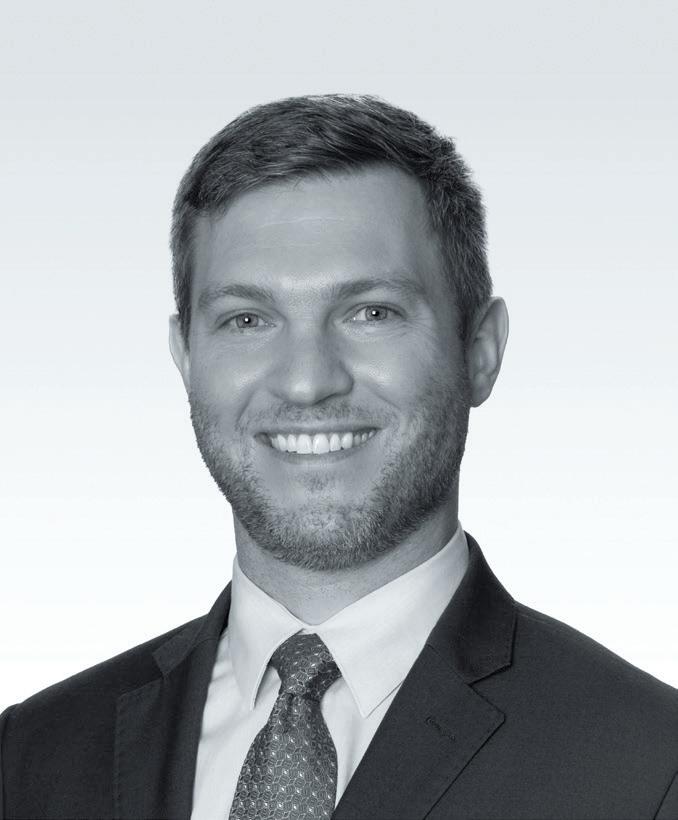



The physicians at Consultants in Ophthalmic & Facial Plastic Surgery — Geo rey Gladstone, Evan Black, Francesca NesiElo , Dianne Schlachter, Robert Beaulieu, Shravani Mikkilineni, and physician assistant Lindsay El-Awadi — are proud to be known as the “Eyelid Experts.”
Representing the gold standard in eye plastic surgery, these doctors have developed and improved techniques to provide the results patients seek when it comes to plastic surgery in the delicate areas around the eyes and forehead.

Their advanced training, together with the personal care and attention provided to patients, is obvious from your fi rst visit. Outstanding results, faster healing, long-lasting benefi ts, and happy patients are what the team strives to achieve. They o er upper and lower eyelid surgery and the removal of eyelid “bags.” State-of-the-art endoscopic brow and forehead-lift procedures accomplish the rejuvenation many patients can’t get from eyelid surgery alone. When you choose the Eyelid Experts, you’ll “see” the di erence!






As the Faces of Family Entrepreneurship, Carmine and Kira Jabri exemplify the power of building a business with vision, resilience, and heart. Their journey began with a shared belief in partnership, and they’ve transformed that foundation into a thriving portfolio spanning multiple industries. From global management consulting to independent publishing, fine dining, and wellness, each of their businesses reflects a unique blend of entrepreneurial spirit and deeply rooted family values. What sets their story apart is the strength of their

collaboration. Every venture draws from their complementary talents, mutual trust, and long-term vision. Based in the Detroit area with a growing international presence including strategic e orts in Dubai, United Arab Emirates, their businesses are shaped by a global mindset and a commitment to excellence.
Carmine and Kira lead with integrity and purpose. Their work stands as both a legacy for the next generation and a modern blueprint for building enduring, cross-border impact through family-driven leadership.












TUSHAR VAKHARIYA & RENEE LOSSIA ACHO — TVA + RLA | KW DOMAIN 210 S. OLD WOODWARD AVE., SUITE 200, BIRMINGHAM, MI 48009 | 248-786-7790 TUSHAR@TVARLA.COM | RENEE@TVARLA.COM
Tushar Vakhariya and Renee Lossia Acho have redefined luxury real estate in Michigan through a results-driven partnership that combines over 40 years of expertise. As the powerhouse team behind TVA + RLA, they’ve built a reputation for delivering unmatched value to their clients through exclusive access to listings, a vast network of qualified buyers, and a proven ability to sell 35% of their listings o -market at record-breaking prices. Their approach is precise. Every strategy is tailored to the

current market, leveraging hyperlocal data, elevated marketing, and a deep understanding of buyer behavior. Every move matters, and Vakhariya and Lossia Acho consistently deliver clarity, confidence, and results to their clients.
Backed by a best-in-class team, TVA + RLA has set the standard for luxury real estate in Michigan, o ering clients not just a transaction but a seamless, high-touch experience rooted in trust, discretion, and record-breaking performance.




Local bankers, national resources. Put the expertise of KeyBank, a bank that knows Michigan, to work for your middle-market business.
KeyBank’s team will get to know your business in detail to suggest valuable ideas and approaches — from innovative fi ntech and cash management tools to extensive capital markets support and fraud protection — that can evolve with your needs.


See how thoughtful, industry-informed advice; strong


relationships; and access to capital can help your middlemarket business achieve its goals. Visit key.com/commercial Banking products and services are o ered by KeyBank National Association. All credit, loan, and leasing products are subject to collateral and/or credit approval terms, conditions, and availability and are subject to change.
Pictured from left to right are SVP Ryan Sullivan; SVP Michael Dolson; David Mannarino, regional executive and market president; SVP Paul Whalen; and VP John VandenBrink.





from any corporation. “This allows our team to stay true to the mission of treating each person as a whole being, rather than a diagnosis,” says Dr. Ashley Casey, co-founder and program director. LHRC’s expert clinicians pride themselves on a truly personalized approach to treatment that works to address each client’s unique needs and concerns. This translates into a robust and individualized approach to set you and your loved ones up for success.


FACES OF

CINDY KAHN & EMILY KAHN — THE AGENCY BIRMINGHAM
442 S. OLD WOODWARD AVE., BIRMINGHAM, MI 48009 | 248-568-7309 | 248-568-0569
CINDYKAHN.COM | CINDY@CINDYKAHN.COM
EMILY@CINDYKAHN.COM
For two decades, Cindy Kahn has been a prominent figure in the real estate industry, specializing in southeast Michigan’s finest residential properties. Her daughter, Emily Kahn, joined the business 4.5 years ago, bringing a fresh approach and her own successful business acumen. Cindy’s success is built on her extensive network of fellow agents, area professionals, and valuable referrals. She is known for her unwavering work ethic, tenacity, and local expertise, and clients highly appreciate her commitment to serving buyers and sellers at every level, not just luxury properties. This commitment has earned her the prestigious title of The Agency Birmingham’s Top Producer for nine consecutive years (2016-2024), placing her in the top 1% of Realtors nationwide. Emily shares in this dedication to clients, ensuring a seamless continuation of their legacy of excellence.



A family business from day one, Heritage understands the importance of high-quality vision care as essential to whole-body health. Integrity, a ordability, fl exibility, and top-notch customer service — these traits are at the heart of what Heritage provides.
Heritage Vision Plans began in 1991 as a second line of business within Heritage Optical, a full-service retail optical dispensary. Founder George P. Barnes Jr. recognized an opportunity to better serve his clientele through a vision benefi ts and management company, and he brought in his children Tracey and Lenny to lead the new enterprise. Since that time, Heritage has become a leading U.S. provider of vision benefi ts plans with an extensive, nationwide network of eye care providers covering all 50 states. No matter the size of the organization, Heritage is committed to providing the best client experience.



Julie



Recognized



The Cardinal at Saint John’s Resort in Plymouth Township takes center stage for the LIV Golf Michigan Team Championship in August.
BY TIM KEENAN

Some of the biggest names in professional golf will converge on Saint John’s Resort in Plymouth Township from Aug. 22-24 when the LIV Golf Michigan Team Championship becomes the first professional tournament to be played on the resort’s new Cardinal course.
Jon Rahm, Bryson DeChambeau, Brooks Koepka, Phil Mickelson, Dustin Johnson, Sergio Garcia, and Cameron Smith are the major tournament champions who headline the Saudi-backed golf league that began play in 2021, causing a pro golf schism from the PGA Tour.
The LIV Golf Michigan Team Championship will be the second pro golf extravaganza in metro Detroit this summer, following the PGA Tour’s Rocket Classic, which has been played in June at the Detroit Golf Club since 2019.
Golf fans will immediately see, feel, and hear the difference between a PGA Tour event and a LIV Golf experience.
Unlike the relative quiet required at PGA events like the Rocket Classic, music blares in the background at LIV tournaments. Beyond standard, 72-hole, four-day pro golf tournaments with a cut after two days, LIV features 54 holes (hence the LIV Roman numeral in its name) played over three days, with each player playing every day.
COMING UP ACES
Hole No. 6 at The Cardinal, shown above, is a par-4 tract that features a rolling fairway, strategically-placed bunkers, and a multilevel green.
LIV events also have shotgun starts and are over in four or five hours, compared to other pro tourneys that start early in the morning and run until dusk, with every player starting on the first hole.
Also, unlike most professional tournaments, the LIV Golf Michigan Team Championship will be a team competition rather than individuals playing for personal glory.
In a universe where play is slow, tradition is king, and course selection for significant events is typically planned years in advance, the LIV-Saint John’s Resort partnership happened at breakneck speed.
Last summer, the first season The Cardinal was open, the resort selected a sports management company, Outlyr of Greenwich, Conn., in an effort to land an LPGA tournament for the 2025 season. That didn’t pan out, but LIV Golf contacted the same company looking to expand its footprint in the United States, and Outlyr encouraged LIV to check out the facilities at Saint John’s Resort.
Internationally, LIV Golf events take place in Saudi Arabia, Australia, Hong Kong, Singapore, Mexico, South Korea, Spain, and Great Britain. U.S.-based LIV events are played in Miami, Washington, D.C., Dallas, Chicago, Indianapolis, and now Plymouth Township.
“Outlyr gave us a glowing recommendation, and from there it was a rapid acceleration of conversations and site visits between September and December of last year,” recalls Eric Djordjevic, managing director of Saint John’s Resort.
“There were a lot of site tours to understand the property and the flow of the course,” he adds. “Then we got into the logistics of access to the property, parking, egress, getting Plymouth Township involved, (and the) police and fire departments. It becomes a community event not only for Plymouth Township, but the neighboring communities. A rising tide lifts all ships.”

Although LIV Golf has booked the hotel and conference center for the entire week of its team championship, and there are plenty of parking spaces for most events, officials expect paying customers to park off-site and be shuttled to the resort.
“We’re backing into seeing what parts of the property are being activated or being used as temporary kitchen structures, then figuring out how much parking will be available on-site and how much we’ll need to shuttle people in,” Djordjevic says. “We’re mentally preparing for easily 20,000 people a day.”
Those 20,000 golf fans can expect to exit their shuttle vehicles at a main entrance near Carl’s Golfland on the Sheldon Road (or west) side of the property, according to Nick Becks, commercial golf operations director at Saint John’s Resort. From there, patrons will have access to the course and the various hospitality suites, sponsor displays, activities, and grandstands.
Standard ticket prices start at $179 for Friday-only and go up to $429 for a three-day pass, which includes access to the Fan Village, which will host various activities, in addition to offering standard seating, standing room, and concessions.
Among the more costly hospitality options are the Club 54 VIP experience and the Birdie Shack, a midtier ticketed package.


“As part of the LIV experience, they have a concert, maybe one for each day of this event, which likely will be staged somewhere in our parking lot,” Djordjevic says. “ ey’re looking to make this Team Championship their Super Bowl.”
Saint John’s facilities — featuring Romanesque architecture harkening back to the resort’s origin as a Roman Catholic seminary — includes Five Steakhouse, Doyles Irish Pub, e Wine Grotto, a new ballroom, and more than 100,000 square feet of meeting space. e latter rooms all could be utilized by LIV Golf and its sponsors.
“We’re working with them on how we’re going to activate the spaces,” Djordjevic says. “ ey could host sponsor-related events, the media center, locker rooms, lounges for players and sta , and command and control centers.”
Any area not being utilized could be used for ticket-holder entertainment.
Raymond Hearn, the metro Detroit native who’s the architect of e Cardinal, designed the course with top amateur and professional tournaments in mind, as well as weekend warriors. He’s surprised a major professional event is coming to his creation so soon.
“I never thought it would happen this fast,” Hearn says. “ is has exceeded my expectations. Our goal was to get a Michigan Open, a Michigan PGA Championship, some of the high-end Golf Association of Michigan amateur tournaments — never the $50 million LIV Championship.”
He says minor modi cations will be made to the course to make it more of a challenge for the professionals. e rst of those adaptations is making the par-5 fourth and 11th holes par-4s. e second is adding about 100 yards of distance to the course’s original 7,000 yards.
“Par-70 at 7,100 yards, that’s a good test of the course,” Hearn says.
EAGLES SOAR
Golf Architect Raymond Hearn (left) with Kevin Peck at Hole No. 8 at The Cardinal at St. John’s Resort during the construction phase. In addition to the main course, there’s The Little Cardinal and The Cardinal Putting Course.


THE HIGHEST-SEEDED TEAMS GET TO choose their opponents for Friday’s quarterfinals from the lower-seeded teams. The format for the quarterfinals is match play. For each quarterfinal, the teams play their opponent on a hole-by-hole basis until one team can’t be caught.
For example, if a team establishes a lead of two holes by the time they’ve finished on the 16th green, that team will win that specific match as there are only two holes remaining and their score can’t be matched or overtaken.
Each quarterfinal match involves three competitive games featuring players from both teams and includes two singles matches and one foursome.
The format is the same for Saturday’s semifinals, but on Sunday the format reverts to the more traditional stroke play, where a player’s cumulative score for the round is measured against par for the course.
All 52 team players will tee o on Sunday in a shotgun start, with every member’s score counting toward his team’s overall total.
The team with the lowest score among the teams competing in the top tier (No. 1 through No. 4) will be crowned the Team Champions of the LIV Golf League.
Source: LIV Golf


SAINT JOHN’S RESORT IS GOING TO BE ON THE GLOBAL MAP. ... WE’RE READY TO TELL OUR STORY.”
— ERIC DJORDJEVIC
Course Superintendent Kevin Peck has another wrinkle in store for the LIV players.
“The goal is to have the rough about 4 inches prior to the event and, depending on the weather, it could grow to 6 or 7 inches by the time the event is over,” Peck says. “With the style of our course being parkland with some narrow landing areas, it should be challenging for the players.”
Although Hearn and his team took more than 1,000 trees out of the property, the ones that remain are there for a reason. “The trees are strategic for tournament play,” Hearn says. “The ones that were left will make these LIV players think about their next shots.”
There also are areas of the greens that were designed for tournament hole placement.
“On the edges of the green there are subtle rolls that you really have to pay attention to, that you have to read from several angles,” Hearn says. “That was built in with the intention of hosting championship play.”
Conditions also will be challenging for the amateurs playing the course before and after the tournament, as the rough grows to championship length and is gradually cut back after the event. The course will close 10 days prior to the start of the tournament for final preparations.
While it’s coming more quickly than expected, the eyes of the golf world will be focused on Saint John’s Resort and its Cardinal golf course for three days in August, via the cameras of FOX and the FOX Sports networks.
Above: Hole No. 5 at The Cardinal.
Below: Bryson DeChambeau shot a record 58 in the final round of the LIV Golf Greenbriar tournament in 2023. The Greenbriar — The Old White TPC is located near White Sulphur Springs in West Virginia.
“Saint John’s Resort is going to be on the global map,” Djordjevic says. “It’s beyond exciting. We’re very proud of our history and all of the work we’ve done over the last three years since the Pulte Charitable Family Foundation acquired the property. The investments that have been made to our wonderful course, the infrastructure, expanding the facility with the new ballroom — we’re ready to tell our story.
“We would expect a lift of some sort, not only in golf but the facilities in general. Consumers like to be where the pros have played.”


























Tess Mateo, who grew up in Troy, helped plan a major fundraiser in New York City with recording artists like Dionne Warwick before enjoying a long career in consulting that led to advancing global sustainability via Vision 2050.
BY TOM MURRAY
Tess Mateo’s eyes light up when she describes her first job, a paper route as a 12-year-old seventh grader in Troy, and the life-changing revelation that came with it.
“I learned that timing is everything,” says Mateo, a senior adviser to AQAL Capital in Munich, Germany. “I worked in November and December, and I would get these huge Christmas tips. And then I’d tell my friends how great the paper route was and they’d start in January (and) February, and didn’t get the tips and make as much money as I did.”
Today, Mateo invests in space companies providing earth observation data, innovative food waste technologies, fintechs, and new inventions that will lower the cost of solar energy.
So how did she make the leap from that paper route to what is now a career as a successful entrepreneur, self-described “impact/sustainability investor,” and green economy visionary?
It all began with her parents.
“My dad was a doctor and my mom was a medical technologist,” Mateo says. “They came from the Philippines, and if you wanted to go to America your golden ticket was to study medicine — and so that’s how they both came.”
Her parents both started their careers in Boston but met in Ohio, which is where Mateo was born. The family then moved to downtown Detroit, but left for the suburbs of Troy after the 1967 riots.
“It was all just farmland,” Mateo says of Troy. “Rochester Road and Livernois were like two lanes (each), and when you went north of 20 Mile, it was dirt roads.”
While attending Smith Middle School, Mateo delivered newspapers for the Troy Eccentric. She also developed into an accomplished athlete. “I set the record in 1979 for the 70-meter sprint, which was tied in 2016, and held four records at one time,” Mateo says of her middle school years.
Tess Mateo grew up in Troy, triple majored at the University of Michigan, went on to help raise funds for AIDS, was a consultant for a major accounting firm, and today is a senior adviser to AQAL Capital in Munich, Germany.

She went on to attend Troy Athens High School, where she graduated in 1984. During high school, she was elected class president and homecoming queen, and organized the first 24-hour dance marathon in Michigan for muscular dystrophy. As a result, she was invited to present a check to Jerry Lewis, who served as host for numerous fundraisers centered on combatting the disease.
During high school, Mateo held an array of side jobs both at the Somerset Collection and Oakland Mall, including stints at Saks Fifth Avenue, Bonwit Teller, Gucci, Alfred’s Restaurant, Baker’s, and Chandler Shoes.
“I started out when I was 12 as a teen model for Bonwit Teller and Saks, and then became a stock girl at 14, and then a salesperson at 16,” she shares.
Following high school, she intended to follow her parents into medicine, and attended the University of Michigan in Ann Arbor.
“I always loved dissecting and wanted to be a surgeon. While I did immunology research and finished my biology degree in my sophomore year, Ann Arbor was too much fun to leave — so I added a psychology degree and planned to take the MCATs (Medical College Admission Test) the following year.”
With a lighter courseload, Mateo worked as a bartender at Rick’s American Café in Ann Arbor and became a collegiate entrepreneur.
Her friend, David Walters, was selling boxer shorts on football game days with a little off-replica “M,” to avoid paying the licensing fee. “Madonna had started the boxer shorts craze when she wore them over leggings in ‘Desperately Seeking Susan,’ ” Mateo explains.
Tapping her earlier life in retail, she boasted to Walters she could double his sales. Laughing, he said he would make her a partner if she succeeded.
Moving quickly, Mateo persuaded gift stores to take the boxer shorts on consignment. When they became hot graduation and Father’s Day gifts, stores clamored for more. Impressed, Walters made Mateo a Colorworx co-owner and the company became “the first to sell college-logo boxer shorts in department stores, locally at Jacobson’s, and then nationally at Hudson’s,” she says.
To learn how offices operated, she joined Kelly Services in Troy to “temp,” and secured a public relations internship pitching stories and press releases.
As demand for the boxers grew exponentially, she hired her sorority sisters to sell the merchandise on game days, and sales grew from dozens to thousands. At the same time, she started a new child psychology research project.
As she attended spring classes the following year, her career trajectory took a sudden turn.
“I dropped a curling iron on my eye about a month before the MCATs, and it singed my eyeball. I had to go home and lie in bed with patches on my eyes, and I couldn’t move while it was healing. I couldn’t see for about a month.”
The doctor treating her said she was more animated when she was describing boxer shorts than talking about becoming a doctor. Taking the MCATs later meant she would start medical school after her peers, so she decided to study economics.
Luckily, her Lotus 123 spreadsheet skills were in great demand and General Motors hired her that summer.
“In spring of my senior year, I attended my first Association of Collegiate Entrepreneurs in Washington, D.C., and was selected to represent the United States at the first global meeting of young entrepreneurs at 10 Downing Street in London,” Mateo recalls.
“After the success of Live Aid, we wanted to organize something impactful, and came up with the idea of holding concerts on at least one college campus on each continent to raise funds for AIDS, which was then a cause that desperately needed immediate support.”
Mateo moved to New York City to explore producing the global music fundraiser, and successfully pitched the idea to the “godfather of disco,” Mel Cheren, who co-founded West End Records and helped start Paradise Garage, a popular gay discothèque.
Upon learning that corporations couldn’t sponsor campus concerts, Mateo helped Cheren with 24 Hours for Life, a campaign whereby nightclubs would donate their door receipts to AIDS.
When Mateo bumped into singer and U.S. Ambassador of Health Dionne Warwick in an elevator and excitedly pitched 24 Hours for Life, the singer was so impressed she suggested merging it with “That’s What Friends are For,” her threeday AIDS benefit gala weekend based off one of her hit songs, which had been written by Burt Bacharach and Carole Bayer Sager.
“As special events coordinator, I had to find and connect sponsors and talent,” Mateo says. “On a newsstand, I saw a list of New York City’s most powerful people. I thought, why not call them and invite them to lunch with Frank Sinatra, who was Dionne’s close friend, as they shared the same birthday on Dec. 12?
“A trick I learned from my Kelly girl temp work was to call someone’s office after 5:30 p.m., as their assistants had likely left for the day. In those days, oftentimes the head person would answer the phones. I was surprised so many would donate
I WAS INVITED TO ALL OF THESE EVENTS, AND I REMEMBER ONE TIME SHOOTING POOL WITH MY COLLEAGUES WHEN MALCOLM FORBES APPEARED AND JOINED US.”
— TESS MATEO
Announcing the “That’s What Friends Are For” AIDS Benefit in spring 1989, Mateo, far right, is joined by Stanley Burke, Manhattan Borough President David Dinkins (future New York City Mayor), and U.S. Ambassador of Health Dionne Warwick.
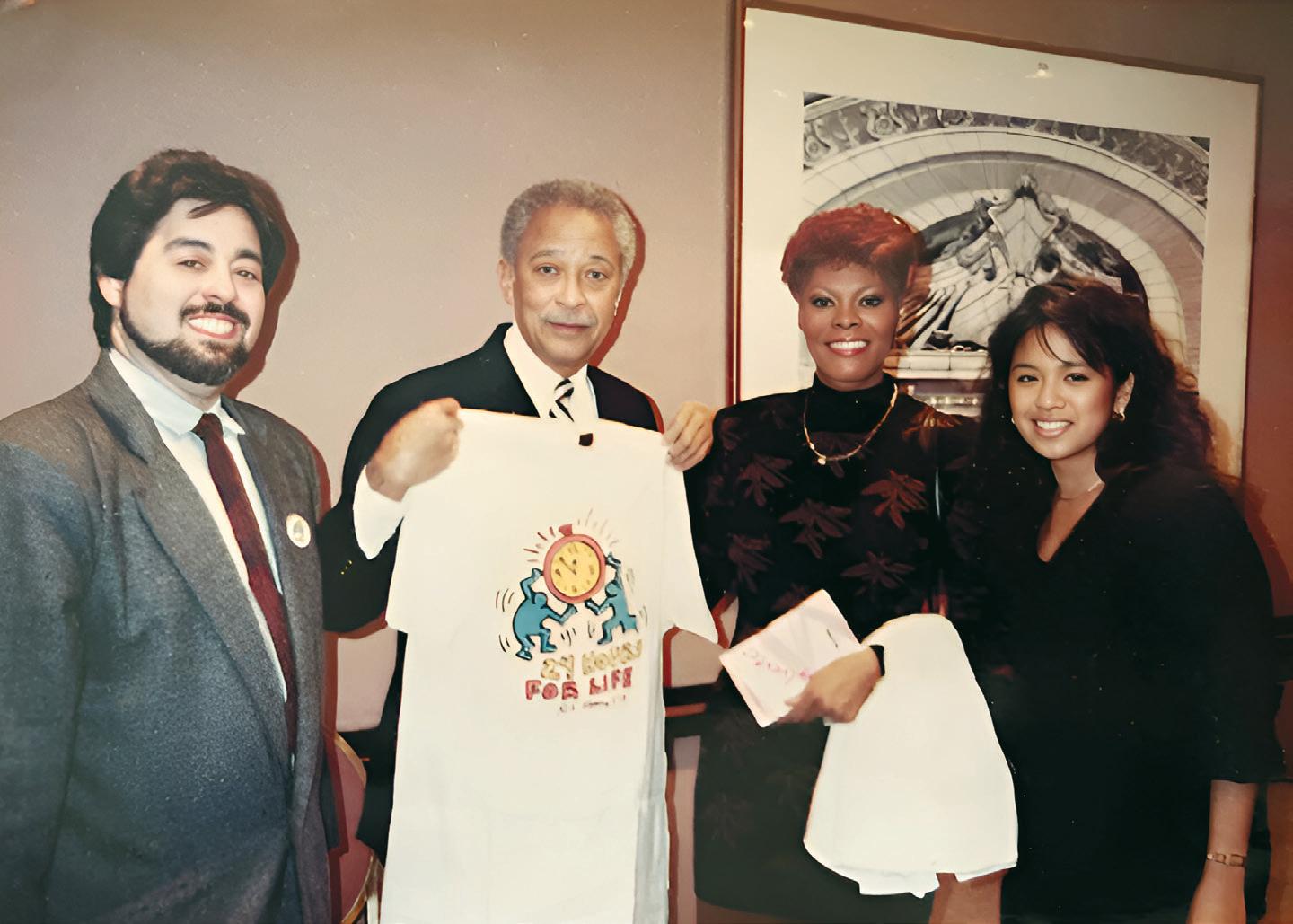
$25,000 to meet Frank. I was in my early 20s, and clueless to New York City’s corporate hierarchy. But we were successful, and throughout this process folks thought I knew all these powerful people.”
It helped that Warwick’s record label, Arista Records, and its founder, Clive Davis, were supportive of raising money for the gala weekend.
“I was invited to all of these events, and I remember one time shooting pool with my colleagues when Malcolm Forbes appeared and joined us,” Mateo says. “Everyone was trying to figure out who was this girl from Michigan?”
Long story short, through her cold calls, introductions, and recruitment efforts, combined with Warwick’s reach, multiple stars performed throughout the weekend, including Warwick, Sinatra, Sammy Davis Jr., Whitney Houston, Gladys Knight, Cyndi Lauper, Mary Wilson, Patti Labelle, Tony Orlando and Dawn, and many others.
Following one year in the entertainment world, which she enjoyed but grew tired of, Mateo joined Indevo, a Swedish consulting firm, as an associate consultant. Two years later, in 1992, she landed another consulting job, this time with Coopers & Lybrand.
“I was working long days for C&L, restructuring a company, and my team wondered why I was never available to work late on Thursdays,” she recalls.
As Mateo explains, “if you worked at Saks Fifth Avenue for 10 years, you could get a lifetime 30 percent discount. I’d already worked for Saks for almost nine years in Michigan, so when I moved to New York, I worked bridal once a week.”
But not for long. Once Mateo’s C&L client and Saks’ new owner, Investcorp, got wind about the lifetime discount, they pulled the plug. That’s when Mateo quit Saks and had her Thursdays back.
During her seven years at C&L, she worked on multiple restructuring projects in the retail, telecommunication, consumer products, and financial services industries.
In the mid-1990s, C&L sponsored her when she was accepted into Columbia Business School’s Executive MBA program. She started taking classes when her first child was 5 months old.

By the time she finished, she had another child, and C&L was in the midst of negotiating a merger with Price Waterhouse, which was Mateo’s cue to make another move.
“The merger between C&L and Price Waterhouse was a bit messy, so I left when a U-M classmate working at a venture capital firm recruited me to be the No. 2 at a startup, 1800GiftCertificate/IncentOne. We turned gift certificates into what are now ubiquitous gift cards and online incentives,” she says.
Mateo spent about two years with the startup, but was lured back to PwC by her former C&L mentor, Sam DiPiazza, when he was named PwC’s Global CEO.
“Some people referred to me as his chief of staff, but I never used that title. He recruited me back to work directly with him,” she notes.
The job at PwC was a turning point in Mateo’s professional life. Not only did she work with DiPiazza for 10 years, but the job led to the next challenge in her career.
“Sam chaired the World Economic Forum and the World Business Council for Sustainable Development (WBCSD), among several other organizations, and I was responsible for his contribution to these strategic relationships. One WBCSD groundbreaking project, called Vision 2050, changed my life,” she says.
“Spooked by the global financial crisis, companies committed to sustainability feared that similar misplaced assumptions could create another crisis. It was the first collaborative global, multisector project on sustainability.”
Speaking at the UN Human Rights Council in Geneva, Switzerland, in spring 2014, Mateo advocated for working with others to assist female entrepreneurs and women-owned businesses.
Mateo joins some of her fellow board members of Boys & Girls Club of Harlem at a holiday party for children last December. Guests included A$AP Rocky (in blue) and Rihanna, fourth from right.

Mateo says she co-chaired the Vision 2050 project on behalf of DiPiazza, and presented the outcomes to CEOs and government leaders around the world.
“That experience opened my eyes to new opportunities,” she says. “Vision 2050 laid out how an expected 9 billion people could live well within the resource limits of the planet by 2050.
“I’ve focused primarily on five of the 40 Vision 2050 ‘must haves,’ specifically clean energy, clean water, sustainable food, health, and women’s economic empowerment,” she says.
“Achieving Vision 2050 includes not only net-zero carbon emission goals, but also gender equality,” she says. “With Goldman Sachs estimating that $76 trillion will be spent in the coming decades to hit net-zero carbon emission goals, I’m working with others to help female entrepreneurs and women-owned businesses access and win at least 30 percent of that spend. You can go through various climate impact reports and triangulate geographically exactly where that money will be spent by sector.”
Today, the mother of three college graduates, including one from U-M, lives with her husband in the New York metropolitan area, where she often thinks about the state where she grew up, which Vision 2050 views as a highly desirable place to be in the years to come.
“With its Great Lakes, Michigan is less impacted by the climate chaos affecting other states — hurricanes, droughts, wildfires, and disease-carrying mosquitoes — so I’m bullish on the Mitten State,” she says. “In 2008, I started investing in real estate in Michigan, and I continue to invest now. I have several properties in Detroit, Ann Arbor, and a farm outside of Chelsea.”
After visiting more than 70 countries and all 50 states several times, Mateo says the character Dorothy in the “The Wizard of Oz” said it best: “There’s no place like home.”
In the six years it’s been open, Mootz Pizzeria + Bar has grown to become one of downtown Detroit’s most popular dining destinations.
BY TIM KEENAN | JOSH SCOTT
Mootz Pizzeria + Bar in downtown Detroit has overcome a couple of major hurdles in its first years of operations. The first was record-cold temperatures for its opening week; the second occurred a year later, with the global pandemic.
Co-owner Lisa Walters and Executive Chef Angela Georges, who joined the team three years ago, have persevered — and the result is an establishment that has garnered more than 2,500 5-star Google reviews over the past six years.
Before taking on Mootz, Walters’ previous food service experience was as a server at an ice cream shop and a Denny’s in Ann Arbor. Her business acumen was honed at the helm of Herkimer Radio Service, a two-way communications business in Monroe that she still runs.
The Mootz opportunity came via an offer by Bedrock to rent space to operate a restaurant in downtown Detroit. The offer, along with the original menu created by award-winning pizza creator and culinary consultant Bruno DiFabio, was one Walters couldn’t refuse.
“The first week we opened we had an arctic blast with temperatures at 50 below,” Walters recalls. “We said if we can survive that, we’ll be OK. Of course, a year later we had the pandemic. Again, I said if we can survive that, we can survive anything.”
Mootz has more than survived. It has thrived.
The establishment’s popularity expedited the need to expand into the 2,000-square-foot former comic bookstore next door. That project began in December 2024 and the addition opened in time for the NFL Draft in April of last year.
“The draft was fun because we’d have a table of Lions fans and a table of Packers fans, and they’d be yelling and cheering back and forth,” Walters says. “We started using the expansion area immediately and the business has improved exponentially.”
The expansion increased Mootz’s space to 5,900 square feet from its original 3,900 square feet, including the kitchen. Capacity increased to 165 seats from the original 101 seats. The outside patio area adds

CHEESE PLEASE
Mootz Pizzeria + Bar opened along Library Street in downtown Detroit in 2019.
The menu includes the Bee Sting, above, which includes pepperoni, fresh buffalo “mootzarella,” fresh basil, and hot honey.
about 40 seats to the total when weather permits. The Side Hustle Lounge adjacent to the addition, has another 20 seats. Both the Side Hustle and the addition can be rented out for private parties.
Since the expansion, business has improved by 10 percent to 15 percent on average; some days the boost is 30 percent to 40 percent, Walters reports.
Not surprisingly, Saturday tends to be Mootz’s busiest day, followed by Friday and Sunday. Monday is the slowest.
“Events always provide a jump in business,” Walters says. “Disney on Ice, AC-DC, the Lions, Tigers, Pistons in the playoffs, the Red Wings.”
Walters says she leans on her business background to operate the restaurant, but the growing popularity of the establishment is making it difficult to rely on data to plan for the future.
“We keep great records about holidays and events from year to year, in an effort to be ready for what’s coming, but it seems like we can never plan,” she says. “It’s been that way since day one. (With) opening in 2019 and COVID-19 in 2020, it seems like we’re just now getting consistent planning data.”
Mootz’s most popular menu offerings include the No. 1 seller, the Bee Sting, a New York-style pizza with pepperoni, fresh buffalo “mootzarella” cheese, fresh basil, and a hot honey drizzle. The Mootz name is a reference to the shorthand version of mozzarella often used by New Yorkers.
The Uptown is the restaurant’s next-most-popular pizza. It’s a glorified pepperoni pizza with double the pepperoni and shaved parmesan and pecorino cheese.
What makes a New York-style pizza pie different from other varieties? It’s the dough — or biga, as pizza starter dough is called.
Executive Chef Georges, who started her career 15 years ago at Como’s in Ferndale and segued to fine dining before landing at Mootz, says she was intrigued by New York-style pizza starter dough.
“I was fascinated by the process,” she says.
New York-style pizza dough takes three days (compared to three or four hours for standard pizza) to make, due to a prolonged fermentation process — typically 72 hours — that allows for improved flavor and texture development. This cold fermentation allows the gluten in the dough to relax, making it easier to stretch for the signature New York-style crust. The flavor also matures during this time, resulting in a more complex taste.
131,147 Full pizzas sold in 2024

“For a restaurant, you have to plan that many days ahead to make sure you don’t run out,” Georges says.

76,306 Individual slices sold in 2024
Using that dough as its foundation, the pizza at Mootz is baked exactly as it is in New York, at 700 degrees using a domed, gas-fired brick oven that was hand-crafted in the U.S. The pizza sauce is made from California-grown tomatoes, and the mozzarella is made in Wisconsin.
Georges adds that other items on the Mootz menu allow her to flex the fine dining muscles she developed at Parc Restaurant in Campus Martius in downtown Detroit and the former Bacco Ristorante in Southfield.
One of the top non-pizza menu items at Mootz is Cajun Salmon Alfredo, comprised of fettuccine, salmon, Cajun-infused Alfredo, sautéed roasted red peppers, and shaved parmesan.

156,000 Pounds of flour used in 2024
85,000 Pounds of cheese used in 2024
Source: Mootz Pizzeria + Bar
THE PIES HAVE IT
Co-owner Lisa Walters and Executive Chef Angela Georges serve up pies at Mootz Pizzeria. The menu includes appetizers, salads, pasta dishes, multiple pizza selections, and desserts.


“The golden potato gnocchi dumpling with pecorino Romano, ricotta, spinach, and palomino sauce is fun,” Georges says. “We have a lot of pasta dishes that we make from scratch. That’s kind of where you can get more of a fine dining experience with this restaurant. We make our Alfredo authentic. There’s no wine or garlic. It’s pure cream and parmesan cheese.
“The ownership encourages us to be more creative, and I appreciate that.”
Besides the pizza dough, what drew Georges to Mootz Pizzeria?
“When I came here, I looked at the environment and the location, and I realized there was something about this location that sparked something in me to come back to the pizzeria world,” Georges says. “There’s an atmosphere of casual dining that can easily be a fine diner.”
In addition to the pizza and pasta items, popular starters at Mootz include garlic knots (fresh-baked dough tossed in garlic butter and pecorino parmesan cheese with a choice of ranch or marinara) and the Truffled Bumblebee (whipped milk ricotta, bee pollen, honeycomb, fig, truffle honey, and walnut focaccia bread).
Among the vegetarian offerings is the Grandma pizza, which features tomato chunks, garlic, extra-virgin olive oil, fresh mozzarella, basil, pecorino, and shaved parmesan.
Behind the Mootz bar, the most popular signature cocktails are Friend of a Friend (Reposado tequila, Aperol spritz, lemon, and strawberry syrup) and Just a Friend (Reposado tequila, lemon, and blueberry syrup).
“Things are going way beyond our expectations,” Walters says. “It’s becoming a destination for people now. With General Motors coming soon and everything that’s going on across the street at the Hudson’s development (Hudson’s Detroit), everything is improving and increasing.”
THE OWNERSHIP ENCOURAGES US TO BE MORE CREATIVE, AND I APPRECIATE THAT.”
— EXECUTIVE CHEF ANGELA GEORGAS


































AND INVENTIONS
A former faculty member at the University of Michigan in Ann Arbor, Lynn Conway invented a technique for using algorithms to arrange millions of transistors on miniaturized computer chips.
BY NORM SINCLAIR
The story of the life, career, and global impact of Lynn Conway, a pioneering computer scientist and engineer, seems implausible even by science fiction novel plot lines.
Conway, who joined the University of Michigan faculty in 1985, was inducted into the 50th class of the National Inventors Hall of Fame last year.
It was the last of more than a dozen prestigious national and international accolades awarded to Conway for outstanding achievement and innovation in computer engineering.
The impressive recognition was for her early work developing supercomputers at IBM and, later, at the Xerox Palo Alto Research Center (PARC) — where, with a colleague, she invented a method using algorithms to squeeze millions of transistor circuits onto a microchip.
This breakthrough transformed the global microelectronics industry, opening the way for small computing devices such as personal computers, tablets, and smartphones.
In a tribute to Conway, Valeria Bertacco, a professor of electrical engineering and computer science at U-M, said her field would not exist without Conway.
“Chips used to exist by drawing them with paper and pencil, like an architect’s blueprints in the predigital era,” Bertacco said in an online tribute. “Conway’s work developed algorithms that enabled our field to use software to arrange millions, and later billions, of transistors on a chip.”
Conway’s professional accomplishments parallel the remarkable backstory of her own personal life growing up as transgender in the 1950s, and the ensuing emotional and psychological challenges she overcame.
Conway was born a boy in 1938 in Mount Vernon, N.Y. Her father was a chemical engineer, and her mother was a kindergarten teacher. The couple divorced when Conway was 7 years old.
“Although I was born and raised as a boy all during my childhood years, I felt like, and desperately wanted to be, a girl,” Conway wrote in a detailed telling of her life that she posted online after she retired.
Lynn Conway, a pioneer in the field of supercomputers, worked with a colleague to develop a method using algorithms to place millions of transistor circuits onto a single microchip.

In an exhaustive profile in the Los Angeles Times in 2000, in which she first publicly discussed her life as a transsexual, Conway related her experience as a boy who preferred playing with girls, and whose parents tried to block out any signs of effeminacy their child displayed.
One day, the youngster startled her mother while they were shopping in a department store. Conway stopped and admired a girl’s dress that was on display, because it was like one her friend Janet wore. She asked her mother to buy it for her.
After that incident, Conway’s parents cut her hair as short as possible, and her mother stopped cuddling the child, fearing such a display of maternal love would make her son more feminine.
As a child, Conway recalled she was attracted to math, science, and libraries, where she said she spent a lot of time reading about adventuresome people. “I’ve been impacted in very deep ways by the stories of the adventures of people who’ve done cool things — adventures with technology, inventors, designers, discoverers,” Conway later said.
“I loved listening to the radio as a child during World War II, especially to BBC broadcasts from London. Thrilled by hearing people speak from far away, I wondered how this mysterious machine worked, with all the glowing tubes and strange looking parts inside,” she said in an interview with the Institute of Electrical and Electronics Engineers (IEEE)’s Solid-State Circuits magazine.
“My father, who was a chemical engineer, gave me ‘The Wonder Book of Knowledge’ as one of my first big books. From it, I learned not only how to read, but also how electricity was tamed, and radios were created, and that engineers did these things,” she continued.
Conway’s penchant for creating things began in childhood. With help from her younger brother, she built a hi-fi system. She also created a wood-framed enlarger for their new hobby of photography.
In high school in the early 1950s, Conway researched building a radio telescope. That effort involved scanning the skies for radio waves emitted by cosmic bodies, a foundation of modern astronomy. She designed a telescope, gathered the lumber and aluminum sheeting needed for the project, and with her brother’s help, erected a working telescope 12 feet in diameter in their backyard.
At age 17, she left home for college. As a freshman at the Massachusetts Institute of Technology, Conway initially thrived academically, finishing her freshman year in the top 2 percent of the class.
Her personal struggles with sexuality continued, however. She went on a regimen of self-injected estrogen, unsuccessfully sought help from a doctor on the MIT staff, and finally self-medicated with cheap wine. She eventually flunked out of school and moved to San Francisco, where she lived on the fringe of the gay community — an experience that reinforced Conway’s belief she was more female than male.
She moved back home and worked as a repair technician for a hearing aid company before enrolling at Columbia University and returning to school in 1961. Two years later, she had earned bachelor’s and master’s degrees in engineering.
An IBM executive who was an instructor at Columbia recruited Conway for the company’s top-secret project, designing the world’s fastest supercomputer, the ACS — short for Advanced Computer System.
Shortly after joining IBM, Conway and an elite 200-member team of engineers were moved cross-country to a building in Menlo Park, Calif., now the center of Silicon Valley.
Working in that cerebral, high-energy environment, the Columbia graduate scored a breakthrough that had bedeviled other engineers: devising the fastest way for a computer to perform multiple functions at once.
That innovation, referred to as “dynamic instruction scheduling,” or DIS, was incorporated into IBM’s supercomputer ACS, and later became a staple for other supercomputers.
During this time, even as her psychological struggle continued over her sexual identity, Conway married a woman, and they had two daughters. The marriage ended in 1968 when Conway began transitioning into a woman with hormone treatments and surgery. She was one of the first Americans to undergo the procedure.
The development prompted IBM to fire their star engineer. With a new identity as a woman and the name Lynn Conway, she obliterated her past and rebuilt her career starting from scratch, taking a lowly job as a computer programmer with a small company.
FAMILY CIRCUIT
Right: Conway, with Carver Mead, wrote the textbook, “Introduction to VLSI Systems,” published in 1979.
Below: Conway and her husband, Charles Rogers, met in Ann Arbor.
For the next 31 years, Conway lived in what she called “stealth mode,” never revealing her past life or successes at IBM to anyone except a few very close friends.
In 1972, she was recruited by Xerox to join its elite PARC team, which had already invented personal computers, laser printing, and other advances in the computer field.
One of her new colleagues, Carver Mead, an engineer and professor at the California Institute of Technology, was promoting the idea that computers need no longer be room-sized machines, but could be tiny enough to fit into a telephone, a washing machine, or a car.
In Conway, he found someone with hands-on engineering experience and a deep understanding of computer architecture, which she had gained at IBM and Memorex.
“I had never designed a computer, but she had,” Mead said of Conway.
Taking the lead, Conway invented a technique for using algorithms to arrange millions of transistors


onto miniaturized computer chips, a development that became known as “very-large-scale integration,” or VLSI.
Conway also is credited with creating design rules for the new VLSI that could be applied to any VSLI design, revolutionizing the development of personal computers and small computing devices.
Conway and Mead codified their work in a bestselling 1979 textbook, “Introduction to VLSI Systems,” which was used in computer classes in 122 universities around the world and was referred to by generations of engineering students as the “Mead-Conway textbook.”
Conway was granted five patents for her various inventions by the U.S. Patent Office.
In turn, the IEEE, founded in 1917, gave her its highest recognition, the Pioneer Award, citing her “foundational contribution” to the development of supercomputers at IBM and her “launching of a world-wide revolution” with the creation of the microcomputer chip at Xerox PARC.
Ironically, while working at PARC, Conway served a term as a visiting associate professor of electrical engineering and computer science at MIT. She never revealed that, as a male student, she had flunked out of MIT more than a decade earlier.
In 1983, she was recruited by the federal government to lead a supercomputer program at the U.S. Department of Defense’s Advanced Research Projects Agency. Conway was delighted that her hidden past life wasn’t an issue, as she easily passed an FBI background check.
Two years later, Conway joined the faculty at the University of Michigan, where she contributed to numerous research and instructional initiatives, including the Media Union.
One day in 1987, at a canoe shop in Ann Arbor, she met Charles Rogers, a commercial engineer who shared her enthusiasm for the outdoors. Within months, they moved into a country home outside Ann Arbor.
Fifteen years later, in 2002, in a fairy-tale setting with a horse and a carriage, they married on Mackinac Island. The couple remained inseparable until Conway died at age 86 last summer.
In 2020, more than 52 years after she was fired by IBM, the company apologized in an online video ceremony watched by 1,200 employees.
“We deeply regret what you went through, and I speak for all of us,” Diane Gherson, an IBM vice president, told the gathering.
Dario Gil, director of IBM Research, acknowledged Conway’s impact on IBM in a tribute after her death.
“Lynn was recently awarded the rare IBM Lifetime Achievement Award, given to individuals who have changed the world through technology inventions,” Gil said.
“Lynn’s extraordinary technical achievements helped define the modern computing industry. She paved the way for how we design and make computing chips today — and forever changed microelectronics, devices, and people’s lives.”

Left unaddressed, information gaps can harm workplace culture and potentially grow into larger organizational issues.
BY VANESSA DENHA GARMO
During my third coaching session with a new client, I noticed a signi cant communication gap.
Mickey, my client, had been upbeat and excited about his new position during our rst two sessions. He contrasted it with his previous job, which he described as de ating.
He also commended the onboarding process, calling it the best he had experienced in his career. is feedback was particularly exciting for me, as I had collaborated with his supervisor to develop a new onboarding program.
Mickey was the third employee to go through the revised process, making his positive assessment feel like a big win.
However, during our third session, Mickey’s demeanor was completely di erent. His voice was subdued, and the energy I had seen in previous meetings was gone. He seemed upset, even angry.
He explained that he had just left his 90-day review with his supervisor and the human resources director, and it had not gone well. He described receiving a list of 13 items that he referred to as “complaints” about his performance.
Together, Mickey and I reviewed each item, categorizing them as either critiques or actionable points. We worked on leveraging his natural strengths to create a plan for addressing the issues. While developing a game plan wasn’t the main challenge, it became evident that a communication disconnect existed between Mickey and management.
Mickey felt blindsided by the review. He claimed it was the rst time he had heard about any performance issues, despite believing that he had been performing well for the past 90 days.
When I later spoke with his supervisor, he clari ed that some concerns had been communicated to Mickey before the review.
is disconnect made me wonder if management fully realized how signi cant such communication gaps can be. Left unaddressed, they can harm workplace culture and potentially grow into larger organizational issues.
E ective communication is essential, as it shapes the culture of an organization — whether the conversations happen in the boardroom, the breakroom, or at the water cooler.
In today’s fast-paced business world, many organizations struggle with high employee turnover, toxic work environments, weak team cohesion, poor leadership, and declining pro tability.
Often, these problems stem from communication breakdowns. Even in thriving organizations, there’s always room to elevate culture through improved communication and leadership. at’s where a communications audit comes in.
As a leadership development coach, one of my most valuable tools is a thorough communications audit. is process identi es gaps and provides actionable insights, resulting in a detailed plan to enhance workplace culture and create a more cohesive, productive environment. ese insights often lead to coaching sessions for supervisors, managers, leaders, and even entire teams.
While pro tability, strong teams, and productive departments are usually the focus of an organizational analysis, communication issues often go overlooked.
A communications audit examines how employees communicate, the consistency of their messages, the content they share, and the channels they use. It also evaluates organizational goals and the overall e ectiveness of communication strategies.
Audits are particularly useful in identifying “bad apples” or workplace bullies. e 2006 “Bad Apple E ect” study by Will Felps and his colleagues at the University of Washington highlighted how a single negative team member can drastically impact group performance, reducing overall team e ectiveness by 30 percent to 40 percent.

Even high-performing teams aren’t immune. One individual’s negative behavior can disrupt team dynamics, leading to decreased productivity, reduced creativity, and weakened cohesion. Morale often plummets, with teams experiencing up to a 40 percent drop when a negative individual is present.



Having written my master’s thesis on workplace bullying, I can attest that such bullies

frequently embody the “bad apple” e ect, eroding company culture.
is underscores the importance of addressing negativity and con ict within teams to maintain optimal performance. A communications audit can help identify these negative in uences and pave the way for constructive solutions.
When administered e ectively, an audit assesses an organization’s communications practices, strategies, and channels. It seeks to identify strengths and weaknesses, and improve communication e ectiveness and e ciency.
An audit can evaluate internal and external communications, ensuring they’re aligned with a company’s goals and brand image. It also will reveal disconnects and gaps within communication, and show how to close the gaps and connect the dots.
One exercise I regularly recommend to clients is to lead listening tours, where they engage with their teams and ask thoughtful, meaningful questions. Gaining insight into how people communicate within the organization helps re ne leadership skills and fosters stronger connections.










Remember, an organization’s communication strategy creates the culture in which we work.







PATRICK GLORIA
Fratarcangeli Wealth Management in Bloomfield Hills hosted a racing appreciation event on May 29 at M1 Concourse in Pontiac. Approximately 200 people attended, including four-time Indy 500 champion Helio Castroneves, two-time Indy 500 winner Josef Newgarden, and past Indy 500 participant and women’s racing advocate Pippa Mann. The event supported M1 Mobility, an initiative created in partnership with the Pontiac Community Foundation.
1. Pippa Mann, Josef Newgarden, Jeff Fratarcangeli, Helio Castroneves, Saylor Frase
2. James Simonson, Rick Beamon, Brett Lucas, Ben Sharkey
3. James and Sarah Schneider
4. Bryce Moore, Tiffany Huezo, Carter Boles, Jeff Cauley
5. Jeanne and David Hoffa
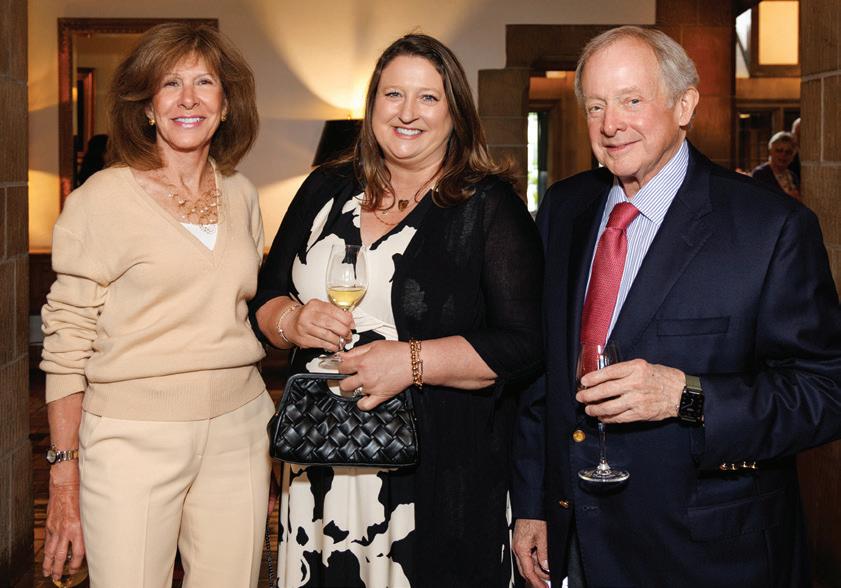





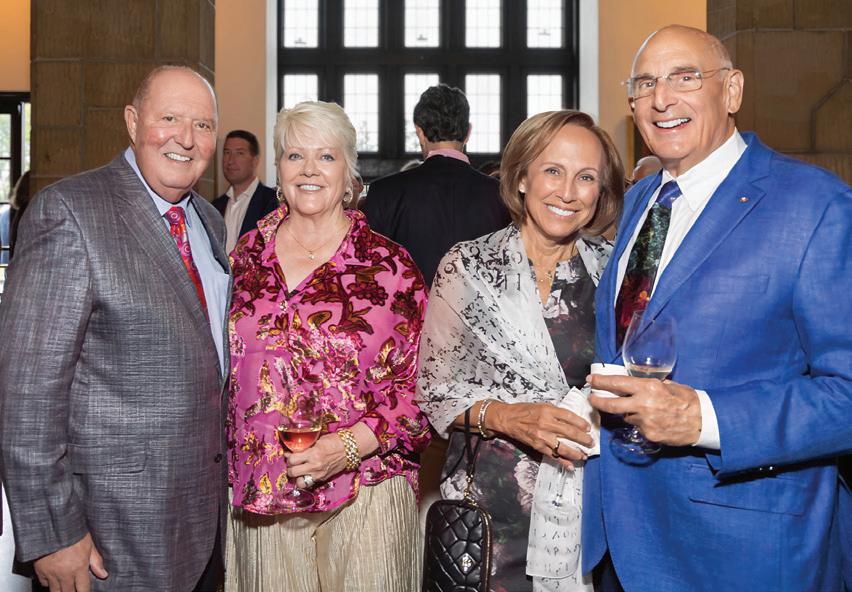

PATRICK GLORIA
The Detroit Public Safety Foundation hosted its 12th annual Women in Blue recognition breakfast on May 22 at MGM Grand Detroit. The event celebrated the women within the Detroit Police Department and Detroit Fire Department. Rhonda Walker of WDIV-TV 4 was the host, and Sati Smith, CEO of Diversified Members Credit Union and a DPSF board member, was the keynote speaker. Savannah Mann was named Women in Blue Police Officer of the Year and Nashanique Webster was named Women in Blue Firefighter of the Year. Rocket Cos. and Diversified Members Credit Union were the event’s Platinum Sponsors.
11. Cristina Floristeanu, Patti Kukula, Alissia Floristeanu, Antonia Bud
12. Charles Fitzgerald, Tiffany Stewart, Eric Ewing
13. Shawna Victoria, Laura Grabowski, Erica Jackson, Katlyn Carey
14. Latoya Peacock, Antwan Brown, Dennis Stone
15. Tamara Randolph, Treva Eaton




PATRICK GLORIA
Filmmaker Keith Famie and his production of
“Detroit: The City of Chefs II” hosted its “Dinner of the Decade” on May 30 at the Country Club of Detroit in Grosse Pointe Farms. The event was a tribute to James Beard orchestrated by Master Chef Brian Beland and multi-James Beard Award winner Chef Jimmy Schmidt. The goal for the evening was to generate two $5,000 donation scholarships through the Michigan Chefs de Cuisine for future culinary students in the Oakland Community College and Schoolcraft College culinary programs. A portion of the funds also went to further support the culinary educational work that the James Beard Foundation does nationally for the hospitality industry.
6. Cynthia Ford, Kristi Lincicome, Edsel Ford
7. Gene Esshaki, Cindy Merry, Jan and Dr. Ted Hadgis
8. Chef Takashi Yagihashi, Madelyn Wisne, Mia Johnson
9. Keith Famie, Chef Jimmy Schmidt, Jeff Black 10. Jeff and Vivian Denha
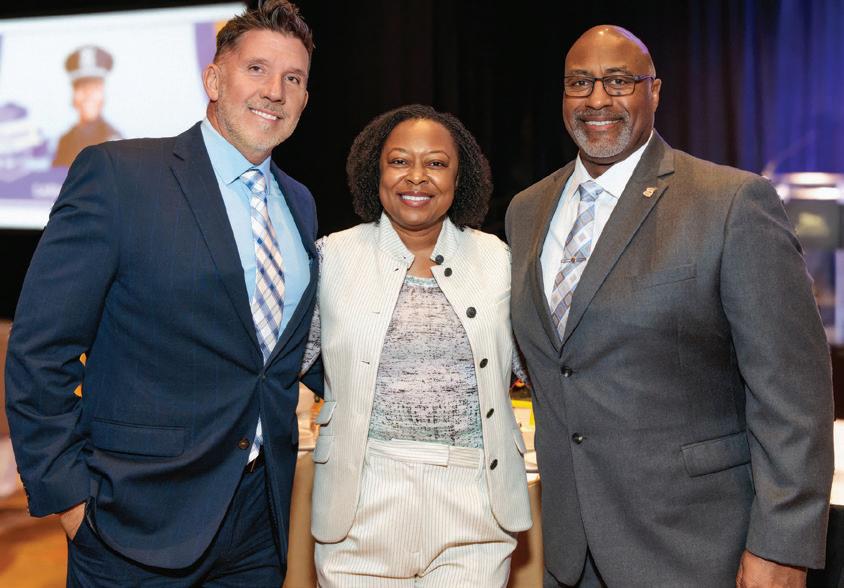


Now is the moment we’ve been waiting for. With new treatments emerging in the fight against Alzheimer’s and all other dementia, now is the time for hope. Now is the time for action. Help us keep the momentum going in your community at the Alzheimer’s Association Walk to End Alzheimer’s®, the world’s largest fundraiser to fight the disease.

The contemporary business landscape is evolving at an unrelenting pace. Today ’s leaders need rapid , impactful results . Since 1874, Kerr Russell has been setting the standard for legal innovation in and beyond Michigan .
kerr -russell.com

Support the fight against Alzheimer’s by becoming a Walk sponsor. Learn more at alz.org/walk or by emailing shrobertson@alz.org.



PATRICK GLORIA
The 10th annual ACG Detroit M&A All Star Awards Dinner took place on May 7 at the Townsend Hotel in downtown Birmingham. Attendees enjoyed networking, a strolling buffet, beverages, and an awards ceremony sponsored by Diamond sponsor Foley & Lardner. Awards were given in several categories, including Deals of the Year Over and Under $50 million, Adviser of the Year, Dealmaker of the Year, Investment Banker of the Year, Rising Star, and the Thomas S. Vaughn Lifetime Achievement Award.
1. Andrew Kulka, Justin Kimkom, Danielle Bass, Christopher Letts
2. Bryan Berent, Chris Caron, Jennifer Caron, Fideh Brundirks
3. Ryan Muneio, Ellen Clark, Todd Halsted
4. Gjina Lucaj, Robert Nederhood, Kim Easterle Mattes, Omar Lucia
5. William Bence, Lydia Mansoor, Suhas Parekh
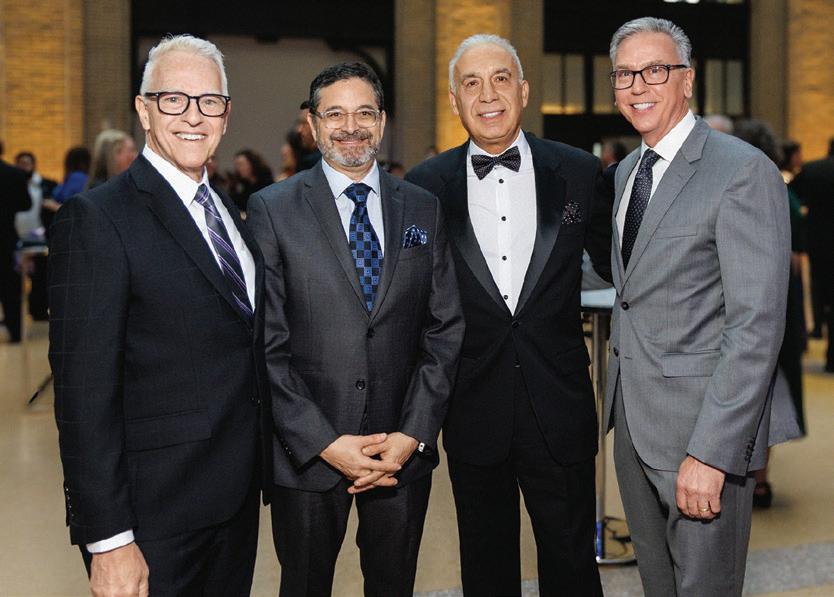
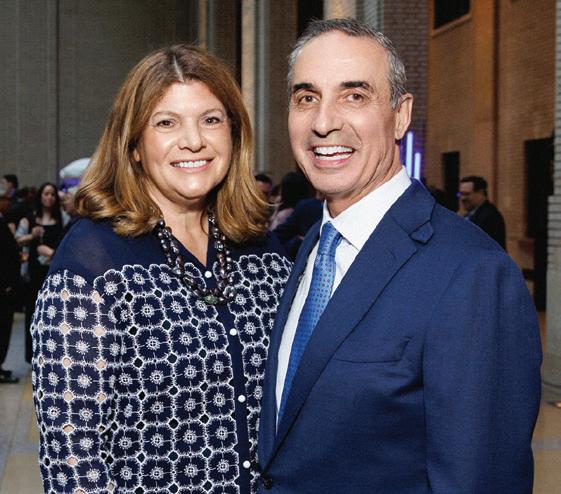
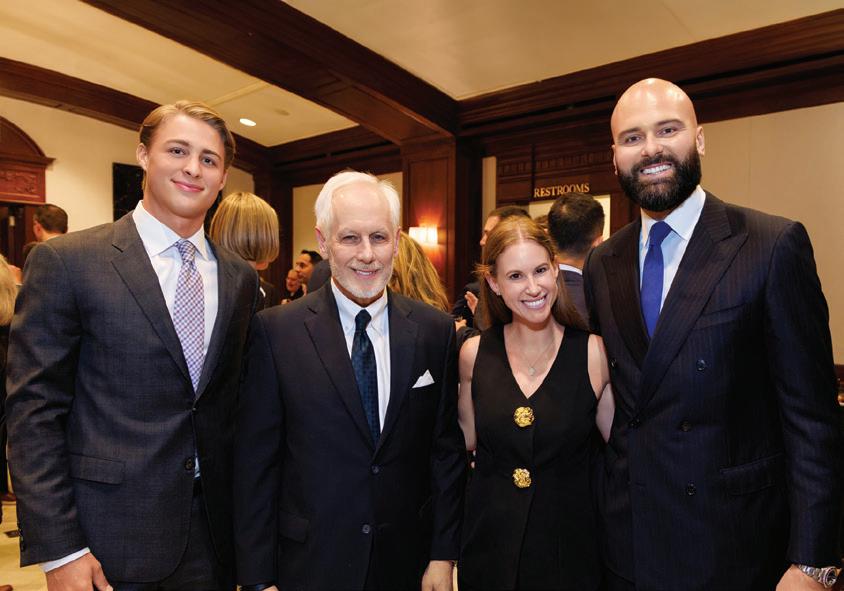


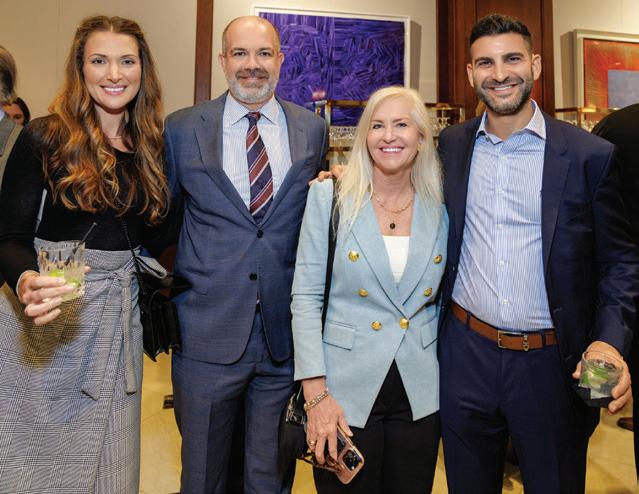


PATRICK GLORIA
The Celani Family Foundation hosted its 11th Cars & Cigars Smoke Detroit event on June 5 at the Michigan Lottery Amphitheatre at Freedom Hill in Sterling Heights. The event included a luxury car show and a reception with cigars, music, appetizers, and beverages, followed by a sit-down dinner, a live auction, and other presentations. Proceeds from the event directly benefit the Celani Family Foundation, which supports underprivileged families and children through local Detroit charities including Gleaners Community Food Bank and the Capuchin Soup Kitchen.
11. Bill Green, John Gonway, Todd Rammler
12. Dal Bouey, Lucas Bouey, Grace and Mike Burns
13. Tom Celani, Paul W. Smith, Dario Bergamo, Rocky Patel
14. Anthony Bellino, Lomas Brown
15. Danny Hill, Phil Peters, Matt Simoncini




PATRICK GLORIA
Lawrence Technological University in Southfield hosted its annual Scholarship Gala on May 17 at Michigan Central Station in Detroit’s Corktown neighborhood. The event’s theme, “Innovation Through the Ages,” reflected LTU’s 93-year history of education and its alumni, while also turning attention to the future. Guests enjoyed an elegant dinner, entertainment, and a live auction. The evening included the presentation of the Edward Donley, Luminary, and Ray Moy awards, recognizing individuals for their contributions in leadership, philanthropy, scholarship, and service. The gala raised funding for students, and will advance STEM education.
6. Dan Stewart, Matthew Cole, Massood Omrani, Richard DeLoofu
7. Nabby Yono, Tarek Sobh, Nihal Sobh, Dr. Jacoub Mansour
8. Michelle and Victor Saroki
9. Robert and Janice Magel
10. Michelle Baker, Cliff Samuels Jr.
















July 13, 2 to 6 p.m.
warmemorial.org/eventcalendar11/augustsoiree
The 2024 Summer Beer & Wine Soiree on the Bay invites guests to sip and stroll through lakefront gardens, enjoy waterfront views, and explore the historic Alger House. Featuring over 100 wines, 50 craft beers and seltzers, gourmet pairings, and live yacht rock.
July 14 , 8 a.m. to 8 p.m. migreengrape.com
Greens ’n’ Grapes returns to Saint John’s Resort, showcasing top local and international wines, craft brews, and gourmet food. Guests will enjoy a golf tournament at the Cardinal Championship Golf Course and wine tasting in the Garden Pavilion while supporting Michigan charities that serve children and families across the state.



July 24, 6 to 9 p.m. corewellhealth.org/foundation/southeast/events/grosse-pointe-gathering
The second annual Grosse Pointe Gathering on July 24 will support Corewell Health Beaumont Grosse Pointe Hospital’s Spiritual Care Endowment Fund. Scheduled for 6 to 9 p.m. at a private lakeside home, the event will include cocktails, dinner, entertainment, and activities.


July 24, 7:45 a.m. to 5 p.m. business.auburnhillschamber.com/events/details/auburn-hills-chamber-golf-open-2025-16855
Golfers will gather for one of Michigan’s premier golf outings, featuring a hot breakfast with a Bloody Mary and mimosa bar, followed by a shotgun start and 18 holes of scramble-style golf. The day will include on-course beer stations, lunch at the turn, post-golf dinner with carving stations, networking, and raffles. Early registration recommended.
July 26–27, 10 a.m. to 6 p.m. hotworks.org/events-hot-works/orchard-lake-fi ne-art-show-july-26-27-2025


Consistently ranked among the top 100 art shows in America, this juried event in West Bloomfield, Michigan, features original, handmade artwork by professional artists from across the country. Visitors can enjoy live entertainment, delicious food, and a youth art competition for ages 5 to 13. Admission is $5 for adults; there is no cost for children 13 and under. Free parking is available behind Corewell Health at 6900 Orchard Lake Road.
Aug. 11, 8:30 a.m. to 5:30 p.m. eventregisterpro.com/event/newayworks
The fifth annual Neway Works Golf Classic tees off Aug. 11 at Greystone Golf Club in Washington, Michigan. Highlights will include pro golfers Lizzie Win and Josh Jackson, celebrity match play, and a $10,000 hole-in-one prize. A four-player scramble, networking, and a charity dinner will round out this action-packed day.


(RANKED BY METRO DETROIT-AREA EMPLOYMENT)
1. DELOITTE
1001 Woodward Ave.
Detroit
313-396-3000
deloitte.com
Top local executive: David Parent, Managing Principal
Detroit-area employees:
2025: 1,502
2024: 1,445
Michigan employees:
2025: 1,688
2024: 1,624
Number of CPAs:
2025: 328
2024: 332
2. PLANTE MORAN
3000 Town Center, Ste. 100 Southfield
248-352-2500 plantemoran.com
Top local executive: Jason Drake, Managing Partner
Detroit-area employees: 2025: 1,402 2024: 1,661
Michigan employees: 2025: 2,004 2024: 2,487
Number of CPAs: 2025: 1,348 2024: 1,472
3. UHY*
Chrysler House
230 E. Grand River Ave., Ste. 700
Detroit
313-964-1040 uhy-us.com
Top local executive: Tom Callan, Great Lakes Managing Partner
Detroit-area employees: 2025: NA 2024: NA
Michigan employees: 2025: 1,400 (est.) 2024: NA
Number of CPAs: 2025: NA 2024: NA
4. ERNST & YOUNG
One Kennedy Square 777 Woodward Ave., Ste. 1000 Detroit 313-628-7100
ey.com
Top local executive: Angie Kelly, Detroit Office Managing Partner
Detroit-area employees: 2025: 751 2024: 795
Michigan employees: 2025: 852 2024: 887
Number of CPAs: 2025: 258 2024: 273
5. REHMANN
1500 W. Big Beaver Rd. Troy 248-952-5000 rehmann.com
Top local executive: Ryan Krause, Regional Managing Principal
Detroit-area employees: 2025: 304 2024: 376
Michigan employees: 2025: 825 2024: 777
Number of CPAs: 2025: 269 2024: 253
6. DOEREN MAYHEW
305 W. Big Beaver Rd., Ste. 200 Troy 248-244-3000
doeren.com
Top local executive: Chad Anschuetz, CEO
Detroit-area employees: 2025: 278
2024: NA
Michigan employees:
2025: 403
2024: NA
Number of CPAs: 2025: 229 2024: NA
7. BDO USA
2600 W. Big Beaver Rd., Ste. 600 Troy 248-362-2100
bdo.com
Top local executives: Rich Black, Assurance Practice Leader; Matt Manosky, Tax Practice Leader; Kevin Patterson, Assurance Market Leader; Andy Zaleski, Tax Market Leader Detroit-area employees: 2025: 243
2024: 280
Michigan employees: 2025: 897
2024: 980
Number of CPAs: 2025: 243 2024: 244
8. BAKER TILLY
1000 Town Center, 27th floor Southfield 248-372-7300
bakertilly.com
Top local executive: Patrick Killeen, Michigan Managing Partner Detroit-area employees: 2025: 124 2024: 116
Michigan employees: 2025: 155 2024: 137
Number of CPAs: 2025: 41 2024: 38

9. KPMG*
150 W. Jefferson Ave., Ste. 1900 Detroit 313-230-3000
kpmg.com
Top local executive: Kevin Voigt, Office Managing Partner, Detroit and Grand Rapids Detroit-area employees: 2025: NA
2024: NA
Michigan employees: 2025: 350+ (est.)
2024: NA
Number of CPAs: 2025: NA 2024: NA
10. GRANT THORNTON 2777 Franklin Rd., Ste. 800 Southfield 248-262-1950 grantthornton.com
Top local executive: Jim Tish, Principal in Charge, Detroit Detroit-area employees: 2025: 99 2024: 104
Michigan employees: 2025: 99 2024: 104
Number of CPAs: 2025: 42 2024: 46
11. WIPFLI (Formerly Clayton & McKervey)
2000 Town Center, Ste. 1800 Southfield 248-208-8860 wipfli.com
Top local executive: Rob Dutkiewicz, Partner
Detroit-area employees: 2025: 70
2024: 68
Michigan employees: 2025: 79 2024: 78
Number of CPAs: 2025: 29 2024: 33
12. GORDON ADVISORS
1301 W. Long Lake Rd., Ste. 200 Troy 248-952-0200 gordoncpa.com
Top local executives: Paul J. Arment & Maureen M. Moraccini, Executive Committee
Detroit-area employees: 2025: 70 2024: NA
Michigan employees: 2025: 70 2024: NA
Number of CPAs: 2025: 32 2023: NA
13. SCHLAUPITZ MADHAVAN, PC 820 Kirts Blvd., Ste. 100 Troy 248-649-1600 smcpafirm.com
Top local executives: Ronald Schlaupitz & Donny Madhavan, Managing Directors
Detroit-area employees:
2025: 56
2024: 53
Michigan employees:
2025: 56
2024: 53
Number of CPAs: 2025: 37 2024: 29
14. COLE, NEWTON & DURAN
33762 Schoolcraft Rd. Livonia
734-427-2030
cndcpa.com
Top local executive: Arthur Cole, Managing Partner
Detroit-area employees: 2025: 33
2024: 31
Michigan employees:
2025: 36 2024: 34
Number of CPAs: 2025: 13 2024: 12
15. MELO USA, PC (Formerly Edwards, Ellis, & Associates)
2155 Butterfield Dr., Ste. 190 Troy
248-643-4545
eeacpas.com
Top local executive: Jeffrey B. Ellis, CPA
Detroit-area employees:
2025: 30
2024: 29
Michigan employees:
2025: 30
2024: 29
Number of CPAs:
2025: 15
2024: 16
16. MRPR GROUP, CPAS AND ADVISORS
28411 Northwestern Hwy., Ste. 800 Southfield 248-357-9000
mrpr.com
Top local executive: Angie Mastroionni, President & Managing Principal
Detroit-area employees:
2025: 25
2024: 25
Michigan employees: 2025: 50 2024: 45
Number of CPAs:
2025: 26 2024: 21
*Did not respond to requests for information.
Source: DBusiness research
1. HUNTINGTON BANK*
2025 Woodward Ave. Detroit
866-258-1807
tcfbank.com
Top local executive: Mike Land, President, Southeast Michigan and Ohio Market
Assets 2024: $204.2B
Assets 2023: $189.4B
Net income 2024: $1.7B
Net income 2023: $2.4B
Total loans 2024: $127.8B
Total loans 2021: $119.7B
2. FLAGSTAR BANK 5151 Corporate Dr. Troy 248-312-5400
flagstar.com
Top Local Executive: Alessandro Dinello, Chairman of New York
Community Bancorp and Flagstar Bank
Assets 2024: $100.2B
Assets 2023: $114.1B
Net income 2024: $(1.2)B
Net income 2023: $(117)M
Total loans 2024: $68B
FLAGSTAR BANK, TROY
3. COMERICA BANK*
411 W. Lafayette Blvd. Detroit 313-222-4000 comerica.com
Top local executive: Steve Davis, Michigan Market President Assets 2024: $79.3B
Assets 2023: $85.9B Net income 2024: $698B Net income 2023: $881M
Total loans 2024 (FY average): $50.9B
Total loans 2023 (FY average): $53.9B
4. FIRST MERCHANTS BANK 32991 Hamilton Court Farmington Hills 800-205-3464
firstmerchants.com
Top local executive: Terri Cable, Regional President
Assets 2024: $12.6B
Assets 2023: $12.3B Net income 2024: $199.5M
5. BANK OF ANN ARBOR 125 S. Fifth Ave. Ann Arbor 734-662-1600
bankofannarbor.com
Top local executive: Tim Marshall, President & CEO
Total loans 2024: $1.5B
Total loans 2023: $1.4B
7. STERLING BANK AND TRUST
One Towne Square, Ste. 1900 Southfield 248-355-2400
sterlingbank.com
Top local executive: Christine Meredith, President
Assets 2024: $2.4B
Assets 2023: $2.4B
Net income 2024: $2.1M
Net income 2023: $7.4M
Total loans 2024: $1.2B
Total loans 2023: $1.3B
8. FIRST STATE BANK 24300 Little Mack Ave. St. Clair Shores 586-775-5000
fsb.bank
Top local executive: Mark Jansen, President & CEO
Assets 2024: $1.3B
Assets 2023: $1.1B
Net income 2024: $13.6M
Net income 2023: $13.7M
Total loans 2024: $809.5M
Total loans 2023: $667.9M
6. CHOICEONE BANK 109 E. Division St. Sparta 616-205-0321
choiceone.com
Top local executive: Kelly J. Potes, CEO Assets 2024: $2.7B Assets 2023: $2.5B Net income 2024: $26.7M
income 2023: $21.3M
9. UNIVERSITY BANK 2015 Washtenaw Ave. Ann Arbor 734-741-5858
university-bank.com
Top local executive: Stephen L. Ranzini, President & CEO Assets 2024: $980M
2023: $909.7M Net income 2024: $11.8M Net income 2023: $6.8M
Total loans 2024: $782.4M
Total loans 2023: $733.87M
10.
chelseastate.bank

13. DEARBORN FEDERAL SAVINGS BANK
22315 Michigan Ave. Dearborn
313-565-3100
mydfsb.com
Top local executive: William R. White, Chairman & President
Assets 2024: $276.6M
Assets 2023: $268.9M
Net income 2024: $83K
Net income 2023: $253K
Total loans 2024: $184.4M
Total loans 2023: $196.8M
14. MI BANK
3707 W. Maple Rd., Ste. 100 Bloomfield Township
313-510-7361 mi.bank
Top local executive: Jenny Meier, Chairman & CEO
Assets 2024: $275.9M
Assets 2023: $236.1M
Net income 2024: $1.2M
Net income 2023: $576K
Total loans 2024: $190.9M
Total loans 2023: $196.8M
15. HURON VALLEY STATE BANK
130 S. Milford Rd. Milford 248-684-9626 hvsb.com
Top local executive: Jack Shubitowski, President & CEO
Assets 2024: $245.3M
Assets 2023: $232.2M
Net income 2024: $2.8M
Net income 2023: $2.6M
Total loans 2024: $186M
Total loans 2023: $174.9M
*Numbers are national figures.
Total financial results are listed for banks headquartered in Wayne, Oakland, Macomb, Livingston, and Washtenaw counties. For banks headquartered outside this area, local results only are provided. Many national banks do not release results for individual markets; therefore, major institutions aren’t included on this list. Total loans also account for leases.
Sources: Federal Deposit Insurance Corp., DBusiness research
(RANKED BY 2024 ASSETS)
1. DFCU FINANCIAL
400 Town Center Dr. Dearborn
888-336-2700
dfcufinancial.com
Top local executive: Ryan
Goldberg, President & CEO
Assets 2024: $6.66B
Assets 2023: $6.2B
Total income 2024: $268.6M
Total income 2023: $225.3M
Total loans 2024: $2.1B
Total loans 2023: $1.75B
2. GENISYS CREDIT UNION
2100 Executive Hills Blvd. Auburn Hills
248-322-9800
genisyscu.org
Top local executive: Jackie
Buchanan, CEO
Assets 2024: $5.3B
Assets 2023: $4.85B
Total income 2024: $323.4M
Total income 2023: $225M
Total loans 2024: $3.88B
Total loans 2023: $3.6B
3. MICHIGAN SCHOOLS AND GOVERNMENT CREDIT UNION
40400 Garfield Rd. Clinton Township
586-263-8800
msgcu.org
Top local executive: Peter D.
Gates, President & CEO
Assets 2024: $3.89B
Assets 2023: $3.62B
Total income 2024: $214.5M
Total income 2023: $159.9M
Total loans 2024: $3.36B Total loans 2023: $3.1B
4. COMMUNITY CHOICE CREDIT UNION
31155 Northwestern Hwy. Farmington Hills 877-243-2528
communitychoice.com
Top local executive: Robert Bava, President & CEO
Assets 2024: $1.84B
Assets 2023: $1.78B
Total income 2024: $124.8M
Total income 2023: $102.8M
Total loans 2024: $1.44B
Total loans 2023: $1.35B
5. CREDIT UNION ONE
400 E. Nine Mile Rd. Ferndale
800-451-4292
cuone.org
Top local executive: Gary A.
Moody, President & CEO
Assets 2024: $1.7B
Assets 2023: $1.72B
Total income 2024: $97.9M
Total income 2023: $86.3M
Total loans 2024: $1.17B
Total loans 2023: $1.2B
6. COMMUNITY FINANCIAL CREDIT UNION
500 S. Harvey St. Plymouth 734-453-1200
cfcu.org
Top local executive: Tansley Stearns, President & CEO
michiganfirst.com
Top local executive: Jennifer
Borowy, President & CEO
Assets 2024: $1.4B
Assets 2023: $1.5B
Total income 2024: $136.4M
Total income 2023: $122.35M
Total loans 2024: $1.04B
Total loans 2023: $1.07B
8. UNIVERSITY OF MICHIGAN CREDIT UNION
340 E. Huron St., Ste. 100 Ann Arbor
734-662-8200
umcu.org
Top local executive: Tiffany Ford, CEO
Assets 2024: $1.35B
Assets 2023: $1.35B
Total income 2024: $89.4M
Total income 2023: $64.48M
Total loans 2024: $1.04B
Total loans 2023: $1.06B
9. VIBE CREDIT UNION
44575 W. 12 Mile Rd. Novi
248-735-9500
vibecreditunion.com
Top local executive: Chaz Rzewnicki, President & CEO
Assets 2024: $1.31B
Assets 2023: $1.2B
Total income 2024: $87.4M
Total income 2023: $17.4M
Total loans 2024: $884.5M
Total loans 2023: $868M
Total income 2024: $37.7M
Total income 2023: $70.6M
Total loans 2024: $489.9M
Total loans 2023: $868.3M
11. CHRISTIAN FINANCIAL CREDIT UNION 35100 Van Dyke Ave. Sterling Heights 586-772-6330
christianfinancialcu.org
Top local executive: Patricia L. Campbell, President & CEO
Assets 2024: $901.2M
Assets 2023: $855.9M
Total income 2024: $36.5M
Total income 2023: $21.69M
Total loans 2024: $659.5M
Total loans 2023: $591.8M
12. ZEAL CREDIT UNION 17250 Newburgh Rd. Livonia 800-321-8570 zealcreditunion.org
Top local executive: Julie Kreinbring, President & CEO
Assets 2024: $825M
Assets 2023: $811.9M
Total income 2024: $57.3M
Total income 2023: $54.8M
Total loans 2024: $654.1M
Total loans 2023: $616.7M
13. ALLIANCE CATHOLIC CREDIT UNION
14. DIVERSIFIED MEMBERS CREDIT UNION
1480 E. Jefferson Ave. Detroit 313-568-5000 dmcu.com
Top local executive: Kathie Trembath, CEO
$30.6M
15. PEOPLE DRIVEN CREDIT UNION 24333 Lahser Rd. Southfield 248-263-4100 peopledrivencu.org
16.
7. MICHIGAN FIRST CREDIT UNION 27000 Evergreen Rd. Lathrup Village 800-664-3828
10. MICHIGAN EDUCATIONAL CREDIT UNION 9200 N. Haggerty Rd. Plymouth 734-455-9200 michedcu.org
Top local executive: Robert Sandercock, President & CEO
Assets 2024: $1.02B
Assets 2023: $1.23B
26913 Northwestern Hwy., Ste. 520 Southfield 877-950-2228 allianceccu.com
Top local executive: Robert Grech, President & CEO
Assets 2024: $627.2M
Assets 2023: $637.8M
Total income 2024: $24.7M
Total income 2023: $29.8M
Total loans 2024: $328.6M
Total loans 2023: $287.1M

800-777-6728
ccfinancial.com
Top local executive: Heidi Kassab, President & CEO
Assets 2024: $424.9M Assets
Total
18. PUBLIC SERVICE CREDIT
UNION
7665 Merriman Rd. Romulus
734-641-8400
pscunow.com
Top
Total loans 2023: $267M
19. OUR CREDIT UNION
3070 Normandy Rd. Royal Oak
248-549-3838 ourcuonline.org
Top local executive: Darren Camron, President & CEO
Assets 2024: $357.8M
Assets 2023: $364.4M
Total income 2024: $19.6M
Total loans 2024: $202.7M Total loans 2023: $220M
20. MICHIGAN UNITED CREDIT
UNION
576 E. Lincoln St. Birmingham
248-647-5958
michiganunitedcu.org
Top local executive: Andrew
Staley, President & CEO
Assets 2024: $331.6M
Assets 2023: $367.7M
Total income 2024: $16.7M
Total income 2023: $14.3M
Total loans 2024: $202.1M
Total loans 2023: $223.2M
Total financial results are listed for credit unions headquartered in Wayne, Oakland, Macomb, Livingston, and Washtenaw counties.
Sources: Michigan Credit Union League and A liates, DBusiness research


GENESEE COUNTY
BISHOP INTERNATIONAL AIRPORT (KFNT)
3425 W. Bristol Rd. Flint
810-235-6560
bishopairport.org Tower: Yes
Instrument approach procedures: Yes
Number of runways: 2
Longest runway: 7,848 ft.
Total operations 2024: 282,719
Services: Fuel (100 LL, Jet A), maintenance, hangars, tie-downs, aircraft parking, ground power unit, de-icing, restrooms, showers, flight planning, satellite weather, passenger lounge, passenger terminal, on-site rental cars, lavatory service, air stairs, pilot lounge, crew cars, limo service, catering, business services, pilot supplies, internet, conference room, U.S. Customs, flight training, air freight, military landing rights FBOs/other services: Avflight Flint, 810-235-0681
Hours: Open 24 hours daily
PRICE’S AIRPORT (K9G2) 15057 Lindbergh Court Linden 810-444-3458 horizonlakesairpark.net Tower: No
Instrument approach procedures: Yes
Number of runways: 1
Longest runway: 4,000 ft.
Total operations 2023: 17,600 (est.)
Services: Self-serve fuel (100 LL), maintenance on call, snow removal, hangars, tie-downs
Hours: Open 24 hours daily
LIVINGSTON COUNTY
BRIGHTON AIRPORT (K45G) 8664 Hyne Rd. Brighton 810-223-6819 brightonairport.org Tower: No
Instrument approach procedures: No
Number of runways: 1
Longest runway: 3,120 ft.
Total operations 2024: 17,600
Services: No public fuel available,

tie-downs
Hours: Open 24 hours daily (irregular)
LIVINGSTON COUNTY SPENCER J. HARDY AIRPORT (KOZW)
3399 County Airport Dr. Howell 517-546-6675
milivcounty.gov/airport/ Tower: No
Instrument approach procedures: Yes
Number of runways: 1
Longest runway: 5,002 ft.
Total operations 2024: 50,000 (est.)
Services: Fuel (100 LL, Jet A), maintenance, repair, inspection, charters, rentals, flight training, hangars, medical transport
FBOs/other services: Airservice Enterprise Inc., 517-546-7379; Aira Aviation, 517-940-4147; Crosswinds Aviation, 517-552-1101; Fuel After Hours, 517-861-1856; Crosswinds Aviation, 517-552-1101
Hours: 7 a.m.-5 p.m.
Monday-Friday; 8 a.m.-noon Saturday-Sunday
MACOMB COUNTY
RAY COMMUNITY AIRPORT (K57D)
59819 Indian Trail Ray Township
586-749-9558
go2ray.us
Tower: No
Instrument approach procedures: No
Number of runways: 2
Longest runway: 2,495 ft.
Total operations 2024: 26,000 (est.)
Services: Fuel (100 LL), flight instruction, mechanic on call, hangar, tie-downs
FBOs/other services: Berz Flight Training, 586-731-6750
Hours: 10 a.m.-4 p.m. daily
ROMEO STATE AIRPORT (KD98) 15340 32 Mile Rd. Romeo 586-336-9116 airnav.com/airport/D98 Tower: No
Instrument approach procedures: Yes
Number of runways: 1
Longest runway: 4,003 ft.
Total operations 2024: 15,000 (est.)
Services: Self-serve fuel (100 LL, Jet A), on-call maintenance, airport management, rental cars, flight training, charters, aircraft rentals, hangars, hangar leasing/sales, passenger terminal, passenger lounge, tie-downs
FBOs/other services: St. Clair
Flight School, 586-536-0773
Hours: 8 a.m.-4 p.m. Monday-Friday
OAKLAND COUNTY
OAKLAND COUNTY
INTERNATIONAL AIRPORT (KPTK) 6500 Patterson Parkway Waterford Township 248-666-3900 oakgov.com/aviation
Tower: Yes
Instrument approach procedures: Yes
Number of runways: 3
Longest runway: 6,521 ft.
Total operations 2024: 154,944
Services: Fuel (100 LL, Jet A), aircraft parking, maintenance, repair, parts, detailing, pilot/ passenger lounges, rental cars, limo service, catering, ground power units, de-icing, lavatory and oxygen service, flight planning, live weather radar, U.S. Customs, heated FBO hangars, conference rooms, wireless internet, showers, concierge, passenger/freight charters, military landing rights
FBOs/other services: Michigan Aviation, 248-666-3440; Oakland Air, 248-666-4300; Pentastar Aviation, 248-666-8230; Royal Air, 248-666-3070
Hours: Open 24 hours daily
OAKLAND/SOUTHWEST AIRPORT (KY47)
57751 Pontiac Trail New Hudson 248-437-2333 oakgove.com/aviation
Tower: No
Instrument approach procedures: Yes
Number of runways: 1
Longest runway: 3,128 ft.
Total operations 2024: 11,000 (est.)
Services: Self-serve fuel (100 LL), pilot/passenger lounge, hangars, tie-downs, internet and computer for flight and weather planning
Hours: 8:30 a.m.-5 p.m.
OAKLAND/TROY AIRPORT (KVLL)
2672 Industrial Row
Troy 248-288-6100
oakgov.com/aviation Tower: No
Instrument approach procedures: Yes
Number of runways: 1
Longest runway: 3,549 ft.
Total operations 2024: 30,000 (est.)
Services: Self-serve fuel (100 LL, Jet A), hangars, tie-downs
FBOs/other services: JDS
Pump-N-Go, 248-288-6100; 2HRFUEL.com, 248-655-1474
Office hours: 8 a.m.-6 p.m. daily
WASHTENAW COUNTY
ANN ARBOR MUNICIPAL AIRPORT (KARB)
801 Airport Dr. Ann Arbor
734-794-6336 airport@a2gov.org Tower: Yes
Instrument approach procedures: Yes
Number of runways: 2
Longest runway: 3,505 ft.
Total operations 2024: 78,654
Services: Fuel (100 LL, Jet A), maintenance, repairs, parts,
WILLOW RUN AIRPORT, VAN BUREN TOWNSHIP
aviation accessories, rental cars, restroom, limousine service available 24 hours a day, parking/ tie-downs, auxiliary power units, jump-starting, computerized weather and flight planning, aircraft parking, aircraft rental, aerial tours/ aerial sightseeing, rental/crew cars, oxygen, pilot lounge, shower, internet, passenger lobby, catering, refreshments, aircraft rental, flight training, hangars, glider towing, tie-downs
FBOs/other services: ACE Aviation Center, 734-662-6806; Solo Aviation, 734-994-6651
Hours: 8 a.m.-8 p.m. daily; terminal open 7 a.m.-dusk
WILLOW RUN AIRPORT (KYIP)
47763 A St. Van Buren Township 734-485-6666
willowrunairport.com Tower: Yes
Instrument approach procedures: Yes
Number of runways: 3
Longest runway: 7,543 ft.
Total operations 2023: 78,907
Services: Fuel (100 LL, Jet A), flight planning, de-icing, aircraft lavatory service, satellite weather, U.S. Customs services, parking (ramp and tie-down), hangars, passenger
terminal, pilot lounge, catering, concierge, rental/crew cars, high-speed wireless internet, business services, freight/cargo handling, military landing rights
FBOs/other services: Avflight Willow Run (East), 734-482-2621; Avflight Willow Run (West), 734-483-3531; Odyssey Aviation, 734-547-7359; Flagship Private Air, 734-926-2000
Hours: Open 24 hours daily
CANTON-PLYMOUTH-METTETAL AIRPORT (K1D2)
8550 North Lilley Rd. Canton Township
734-459-0012
airnav.com/airport/1D2
Tower: No
Instrument approach
procedures: Yes
Number of runways: 1
Longest runway: 2,302 ft.
Total operations 2024: 14,000 (est.)
Services: Fuel (100 LL), hangars, maintenance, repair, parking, tie-downs, flight school, aircraft rental, high-speed wireless internet, lounge, computerized weather, flight planning
Hours: 8 a.m.-4 p.m. daily
COLEMAN A. YOUNG INTERNATIONAL AIRPORT (KDET)
11499 Conner Ave. Detroit 313-628-2144
detroitmi.gov/Government/ Departments/airport.aspx
Tower: Yes
Instrument approach procedures: Yes
Number of runways: 1
Longest runway: 5,090 ft.
Total operations 2024: 75,000 (est.)
Services: Fuel (100 LL, Jet A), maintenance, cleaning, de-icing, hangars, weather/flight planning, tie-downs, charter, courtesy transportation, aircraft lavatory service, passenger terminal, pilot lounge, rental cars, limo service, catering, aircraft sales, aircraft cleaning/washing/detailing, conference rooms, concierge, military landing rights
FBOs/other services: Avflight, 313-527-6620
Hours: Open 24 hours daily
DETROIT METROPOLITAN WAYNE COUNTY AIRPORT (KDTW)
Wayne County Airport Authority 11050 Rogell Dr., Bldg. 602
Romulus
734-247-7678
metroairport.com
Tower: Yes
Instrument approach procedures: Yes
Number of runways: 6
Longest runway: 12,003 ft.
Total operations 2024: 303,441
Services: Cleaning, fuel (100 LL, Jet A), hangars, office rental, weather/flight planning, tie-downs, passenger/pilot lounges, lavatory and potable water, GPU, ground handling, rental/crew cars, de-icing, exec terminal, crew lounge, wireless, catering, limo service, conference rooms, on-site hotel and concierge, military landing rights
FBOs/other services: Signature Flight Support, 734-941-7880
Hours: Open 24 hours daily
GROSSE ILE MUNICIPAL AIRPORT (KONZ)
9601 Groh Rd. Grosse Ile Township 734-692-6424
grosseileairport.com
Tower: No
Instrument approach procedures: Yes
Number of runways: 2
Longest runway: 4,846 ft.
Total operations 2024: 16,000+ (est.)
Services: Fuel (100 LL, Jet A), hangar leasing/sales, tie-downs, computerized weather, pilot lounge, plane wash, rental/crew cars, charter, aircraft lavatory service, conference room, concierge, catering, restaurant and lodging on-site, flight training, military landing rights
FBOs/other services: Grosse Ile Municipal Airport, 734-675-0155; Hall’s Flying Service, 734-346-1930; Max Flight Helicopter Services, 734-231-3102
Hours: 8 a.m.-6 p.m.
Monday-Friday; 8 a.m.-5 p.m. Saturday
Sources: Michigan Office of Aeronautics, AirNav.com, DBusiness research







PRESENTING SPONSORS







TUESDAY, SEPTEMBER 16
A NEW EVENT for industry leaders, engineers, OEMs, and technology innovators. If you’re responsible for driving change, developing talent, or deploying technology in a complex and evolving environment — this is your space to connect, collaborate, and drive what’s next.
GOLD SPONSORS

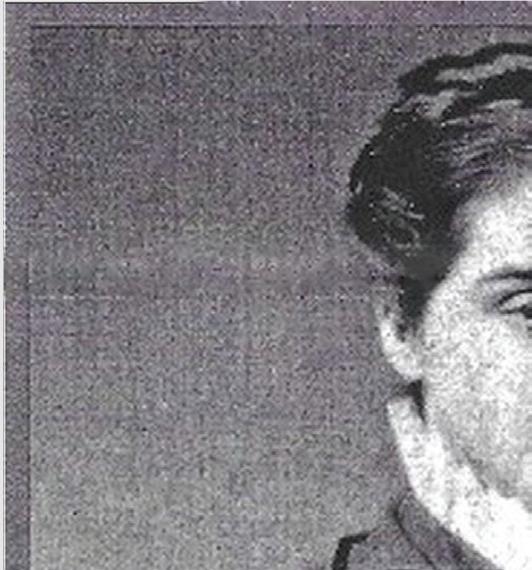
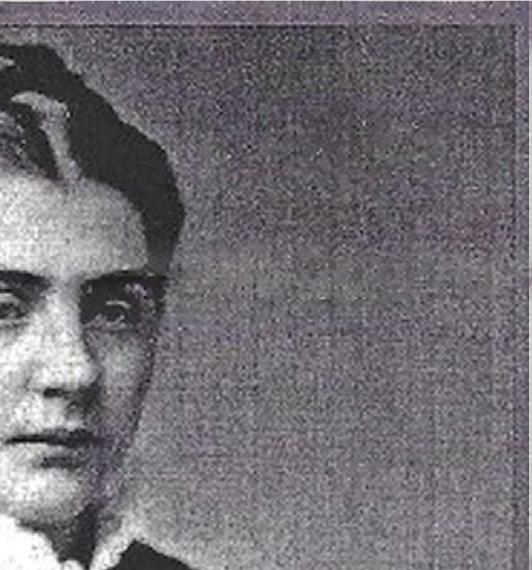
Michigan’s first female attorney, Elizabeth Eaglesfield, was an activist and an entrepreneur with a penchant for conflict.
BY RONALD AHRENS
Elizabeth Eagles eld was peddling cherries and berries from the deck of her boat when a Milwaukee policeman on wharf patrol tried to arrest her. It was the rst weekend of July in 1911, and she o ered her ripe fruit at low costs.
After Eagles eld refused permission to board Golden Girl, the police o cer could only squawk uselessly to his chief. e United States District Court had already asserted her coastal trader’s license was valid. Bessie, as she was known, had every right to conduct business from the boat.
Ever since 1878, when she earned a law degree at the University of Michigan in Ann Arbor — the rst woman to do so, and the rst woman to be admitted to the state bar — con ict seemed to follow Eagleseld. She was an ardent su ragist, but in the 1890s, her Eagles eld Literary Club in Grand Rapids ended up with a schismatic faction that rejected her political views. ose members formed their own group.
Eagles eld, born in 1853, was a Free Silver advocate who once said, “ e old abolition spirit in one is just as strong for this new question.” As president of the Woman’s Parliamentary Law Club in Grand Rapids, she led a revolt and withdrew the group from the Michigan State Federation of Women’s Clubs. She was frequently in the news; one writer called her “plucky.”
In addition to representing clients in divorce and custody disputes, she engaged in several cases of her own interest. e rst was her divorce from James Ashley Jr. after a few years of marriage in her native Indiana, where she had returned after college. She represented herself in that matter.
By 1886, she arrived in Grand Rapids with her son, Phillip. Opening her law o ce, Eagles eld became one of four female practitioners in Michigan. Her newspaper ad said, “Consultation free to women, Saturdays, 2 to 4 p.m.”
CAPTAIN BESSIE
In addition to being the first woman admitted to the State Bar of Michigan, Elizabeth Eaglesfield owned five ships that transported produce across Lake Michigan. She also represented herself in a divorce case.




In 1889, a reporter visited her o ce at 63-65 Monroe St., nding “a cheerful coal re” and law books in the reception room.
“I can’t say that my business is increasing with the rapidity that I could desire,” she said. “ ere are a great many barriers in our way that only women lawyers can appreciate. e advance of our sex in the professions has been so rapid and so recent that many prejudices exist against us.”
Many attorneys were reluctant to work with women, she explained. Clients were wary, and all-male juries could be biased.
Eagles eld gave up her law practice by 1897, but persisted in other activities. In the North End Women’s Club, she and her fellow clubwomen looked into the question, “Are political women repulsive to men?” Newspaper society notes dished out the answer: “Mrs. Elizabeth Eagles eld gave an excellent talk on ‘Soul Growth Maketh Attractive.’ e question was decided in the negative.”
By 1900, son Phillip, 20 years old, wanted to be a mariner; Bessie matched his e orts and they both became captains. In 1909, Golden Girl became the rst of their eet of ve vessels. As usual, though, there was con ict — this time with Grand Rapids Gas Engine & Yacht Co.
e lawsuit that resulted went all the way to the Michigan Supreme Court. In 1915, the court delivered its judgment against Eagles eld.
Two years later, Margaret Parsons, Eagles eld’s longtime housemate, sued her over a business matter and won. Bessie spent her last 20 years in Benton Harbor, where she died at age 86. Her epitaph reads, “I found life di cult, but wonderful, beautiful, and worth living.”

At Display Group, we don’t just create events — we build experiences that draw people in and keep them talking. Our team of designers, fabricators, tech wizards, and event pros work together under one roof to bring bold ideas to life. From custom décor and jaw-dropping lighting to immersive sound, video, and next-level fabrications — we’ve got everything you need to turn your vision into reality. Need to stream it? We can take it live with our in-house broadcasting studio.
Let’s build something unforgettable. Call us at 313-965-3344 to get started.
